World War II (1939-1945) was the most destructive war in history. It killed more people, destroyed more property, and disrupted more lives than any other war in history. It probably had more far-reaching consequences than any other war. The war brought about the downfall of Western Europe as the center of world power. It led to the dominance of the Soviet Union and the United States. It set off a power struggle between the two countries called the Cold War. World War II also opened the nuclear age.
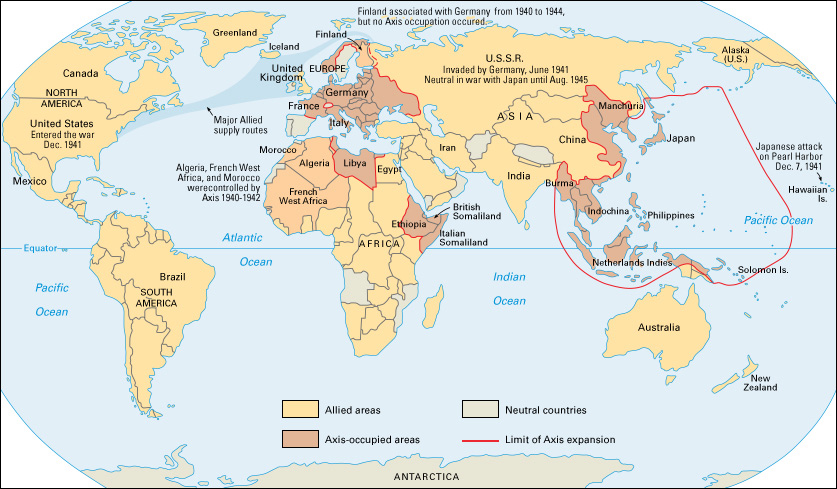
It is impossible to say exactly how many people died as a result of World War II. Estimates suggest more than 20 million soldiers died during the war’s six years. From 30 to 40 million civilians also perished. That makes a combined death toll of 50 million to 60 million people.
The battlegrounds of World War II spread to nearly every part of the world. Troops fought in the jungles of Southeast Asia. They battled in the deserts of North Africa. They fought on the islands and seas of the Pacific Ocean. Battles raged on the frozen steppes of the Soviet Union and in the cities, forests, and farmers’ fields of Europe. Submarines fought below the surface of the Atlantic Ocean.
World War II began on Sept. 1, 1939, when Nazi Germany invaded Poland. Germany’s powerful war machine rapidly crushed Poland, Denmark, Luxembourg, the Netherlands, Belgium, Norway, and France. In June 1940, Fascist Italy joined the war on Germany’s side. In western Europe, only the United Kingdom remained. The United Kingdom resisted German air attacks that destroyed great sections of London and other cities. German and Italian forces then clashed with the British in Greece and northern Africa. In June 1941, Germany invaded the Soviet Union. Germany thus broke their nonaggression pact of 1939. In that treaty, they had promised not to attack each other.
Imperial Japan invaded China in 1937. It allied itself with Germany and Italy in September 1940, creating the Axis Powers. On Dec. 7, 1941, Japan attacked the American military base at Pearl Harbor, Hawaii. The attack brought the United States into the war. By mid-1942, Japanese forces had conquered much of Southeast Asia. Japan had also swept across many islands in the Pacific.
Bulgaria, Hungary, Romania, and the German-created states of Croatia and Slovakia eventually joined the Axis. In opposition, the United Kingdom, the United States, the Soviet Union, and China formed the core of the Allies. The Allies totaled 50 nations by the end of the war.
During 1942, the Allies stopped the Axis advance in northern Africa, the Soviet Union, and the Pacific. Allied forces landed in Italy in 1943. They reached France in 1944. In 1945, the Allies drove into Germany from the east and the west. A series of bloody battles in the Pacific brought the Allies to Japan’s doorstep by the summer of 1945. Germany surrendered on May 7, 1945. Japan surrendered on Sept. 2, 1945.
An uneasy peace took effect as a war-weary world began to rebuild after World War II. Much of Europe and parts of Asia lay in ruins. Tens of millions of people were dead. Millions more were starving and homeless. The United States and the Soviet Union emerged as the world’s most powerful nations. But new threats to peace arose.
Causes of the war
The Peace of Paris.
In 1919, after the end of World War I (1914-1918), representatives of the victorious nations met in Paris to dictate the peace. The treaties of the Paris Peace Conference followed more than four years of costly and bitter warfare. They were worked out in haste by countries with opposing goals. The agreements failed to satisfy even the victors. Of the countries on the winning side, Italy and Japan left the peace conference most dissatisfied. Italy gained less territory than it felt it deserved. It vowed to take action on its own. Japan gained control of German territories in the Pacific. It thereby launched a program of expansion. Yet Japan felt slighted by the peacemakers’ refusal to endorse the principle of the equality of all races.
The defeated countries in World War I—Germany, Austria-Hungary, Bulgaria, and the Ottoman Empire—were especially dissatisfied with the Peace of Paris. They were stripped of territory and arms. They were also required to make reparations (payments for war damages).
The Treaty of Versailles punished Germany severely. Its representatives signed the treaty only at the threat of invasion. Many Germans resented the “war guilt clause” that forced Germany to accept sole responsibility for causing World War I. 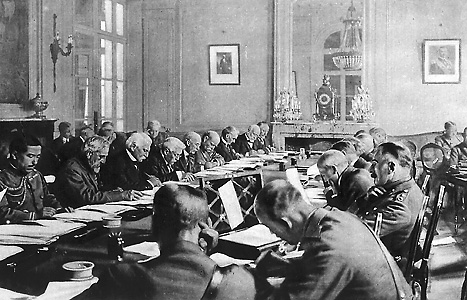
Economic problems.
World War I damaged the economies of European countries. Both the winners and the losers came out of the war in debt. The defeated powers had difficulty paying reparations to the victors. The victors had difficulty repaying loans from the United States. The global economic shift from war to peace left millions of veterans unemployed. Millions of others who had worked in munitions factories and other war-related industries lost their jobs.
Italy and Japan suffered from overcrowding and a lack of resources after World War I. They eventually tried to solve their problems by territorial expansion. In Germany, hyperinflation (rapid, uncontrolled price increases) made money worthless. People lost their life savings. In 1924, loans from the United States helped stabilize Germany’s currency. The reparation payment schedule was relaxed. By the late 1920’s, the economic situation in Germany—and the rest of Europe—had improved.
Then came the Great Depression, a worldwide business slump. It began in the United States in 1929. By the early 1930’s, it had halted and reversed Europe’s economic recovery. The Great Depression caused mass unemployment. It spread poverty and despair. It weakened democratic governments. It also strengthened extreme political movements that promised to end the economic crisis.
Two movements in particular gained strength. The forces of Communism, known as the left, called for revolution by the workers. The forces of fascism, called the right, favored strong national government. Throughout Europe and elsewhere, the forces of the left ground against the forces of the right. Political extremes gained support in countries with the greatest economic problems and the deepest resentments of the Peace of Paris.
Nationalism
was an extreme form of patriotism that swept across Europe beginning in the 1800’s. Supporters of nationalism placed loyalty to their nation above any other public loyalty. They defined nationality by language and ethnicity. They viewed foreigners and minority groups with suspicion and scorn. Such beliefs helped nations justify their conquests of other lands. Such ideas also helped justify the poor treatment of minorities within their borders. Nationalism was a chief cause of World War I. It grew even stronger afterward.
Nationalism corresponded with feelings of discontent. The more people felt deprived of national honor, the more they wished to see their country powerful and able to insist on its rights. Many Germans felt humiliated by their defeat in World War I and the harsh terms of the Treaty of Versailles. During the 1930’s, they enthusiastically supported the National Socialist German Workers’ Party—the Nazis. The Nazi Party glorified Germany’s position in the world and vowed to make the nation strong again. 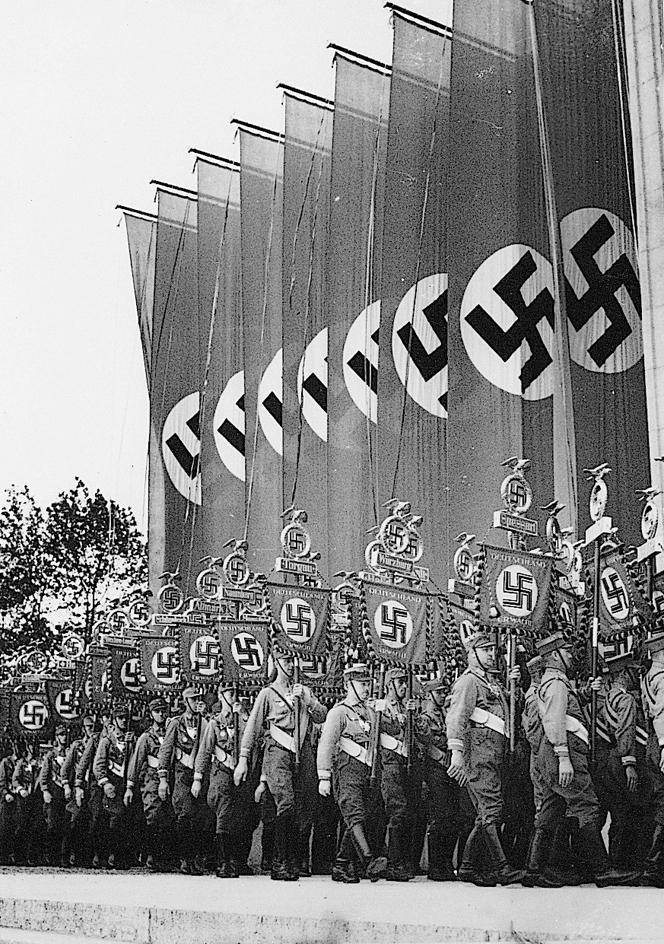
The Peace of Paris established an international organization called the League of Nations to maintain peace. But nationalism and individual arguments prevented the League from working effectively. Each country backed its own interests at the expense of other countries. Only weak countries agreed to submit their disagreements to the League of Nations for settlement. Strong nations reserved the right to settle their disputes by threats or even force.
The rise of dictatorships.
During the 1920’s and 1930’s, political unrest and poor economic conditions enabled radical dictatorships to come to power in the Soviet Union, Italy, Germany, and Japan. The dictators held total power and ruled without regard to law. They used terror and secret police to crush opposition to their rule. People who objected risked imprisonment or execution.
Communists, led by V. I. Lenin, seized power in Russia in 1917. The Soviet Union was established in 1922. A dictatorship set up by Lenin controlled the country by the time he died in 1924. After Lenin’s death, Joseph Stalin and other leading Communists struggled for power. Stalin eliminated his rivals one by one, taking total control in 1929.
In Italy, economic distress after World War I led to strikes and riots. As a result of the violence, a strongly nationalistic group called the Fascist Party gained many supporters. Benito Mussolini, leader of the Fascists, promised to bring order and prosperity to Italy. He vowed to restore to Italy the glory it had known in the days of the ancient Roman Empire. By 1922, the Fascists had become powerful enough to force the king of Italy to appoint Mussolini prime minister. Mussolini took the title Il Duce (The Leader). He began to establish an authoritarian state—that is, one that valued obedience to authority above individual freedom.
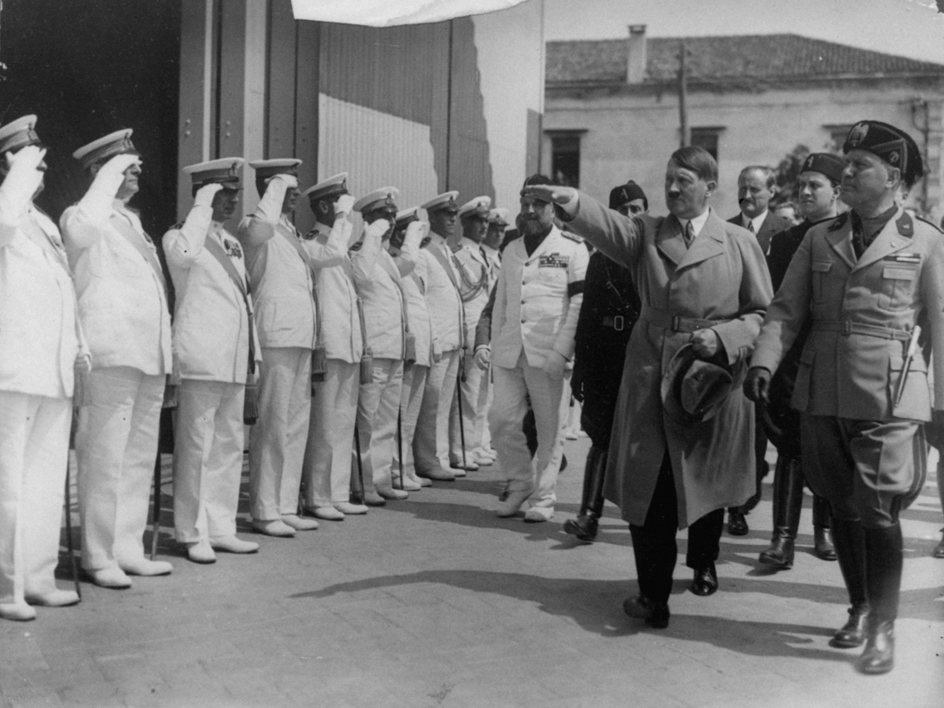
In Germany, the Nazi Party made huge gains during the Great Depression. In 1933, Adolf Hitler, the leader of the Nazis, was appointed chancellor of Germany. Hitler, who was called der Führer (the Leader), rapidly increased his own power. He vowed to ignore the Versailles Treaty and avenge Germany’s defeat in World War I. Hitler preached that Germans were a “superior race.” He called Jews and Slavs inferior. He began a campaign of hatred against Jews and Communists and promised to rid the country of them. In this time of distress and depression, Hitler’s extreme nationalism appealed to many Germans.
In Japan, power rested in the hands of Emperor Hirohito, known in Japan as Showa. But by the 1930’s, military officers had formed a strong government around the emperor. Japan’s military regime glorified war. It admired the traditional samurai warrior code of bushido. In 1941, Hirohito named the militarist General Hideki Tojo as prime minister of Japan.
Aggression on the march.
Japan, Italy, and Germany followed a policy of aggressive territorial expansion during the 1930’s. They invaded weak lands that could be easily conquered.
Japan had annexed Korea in 1910. In 1931, Japan seized control of Manchuria, a large Chinese region rich in natural resources. Japan ruled Manchuria with brutality. In 1937, Japanese troops invaded the rest of China. By the end of 1938, Japan’s military leaders were planning the conquest of all of east Asia.
In 1935, Italian troops invaded Ethiopia. At that time, Ethiopia was one of the few independent countries in Africa. The Italians used machine guns, tanks, and airplanes to overpower Ethiopia’s poorly equipped army. In 1939, Italy swept through Albania, in southeastern Europe. Albania was another easy conquest for Mussolini.
Soon after Hitler took power in Germany, he began to build up Germany’s armed forces. The build-up violated the Treaty of Versailles. In 1936, Hitler sent troops into the Rhineland. The Rhineland was an area in western Germany that the treaty had made a demilitarized zone, a neutral zone free from military control. In March 1938, German soldiers marched into neighboring Austria and united it with Germany. Many people in both countries welcomed the Anschluss (union) of Austria and Germany.
These acts of aggression were easy victories for the dictatorships. The League of Nations lacked the resources or authority to field an international army. The United States had withdrawn from European affairs after World War I. It refused to join the League or become involved in any disputes. The United Kingdom and France were unwilling to risk another war.
In 1936, Germany and Italy agreed to support each other’s foreign policy. The alliance was known as the Rome-Berlin Axis. Japan joined the Axis in 1940. It then became the Rome-Berlin-Tokyo Axis.
The Spanish Civil War.
A civil war tore Spain apart from 1936 to 1939. In 1936, many of Spain’s army officers revolted against the government. The army rebels chose General Francisco Franco as their leader. Franco’s forces were known as Nationalists or Rebels. The forces that supported Spain’s elected government were called Loyalists or Republicans. The Spanish Civil War drew worldwide attention.
Hitler and Mussolini sent troops, weapons, aircraft, and advisers to aid the Nationalists. The Soviet Union was the only power to officially help the Loyalists. France, the United Kingdom, and the United States did not intervene. But Loyalist sympathizers from many countries joined the International Brigades to fight in Spain.
The last Loyalist forces surrendered on April 1, 1939. Franco set up an authoritarian government in Spain. The Spanish Civil War served as a military proving ground for weapons and tactics that were later used during World War II. The conflict in Spain foreshadowed the coming war. It pitted forces of the radical right—Nazis and Fascists—against the rest of the world.
The failure of appeasement.
Czechoslovakia had become an independent nation after World War I. Its western region of Bohemia was surrounded on three sides by Germany. Hitler sought control of the Sudetenland, the German-speaking border areas of Bohemia. More than 3 million people of German descent lived there. Urged on by Hitler and his agents, Sudeten Germans began to clamor for union with Germany. 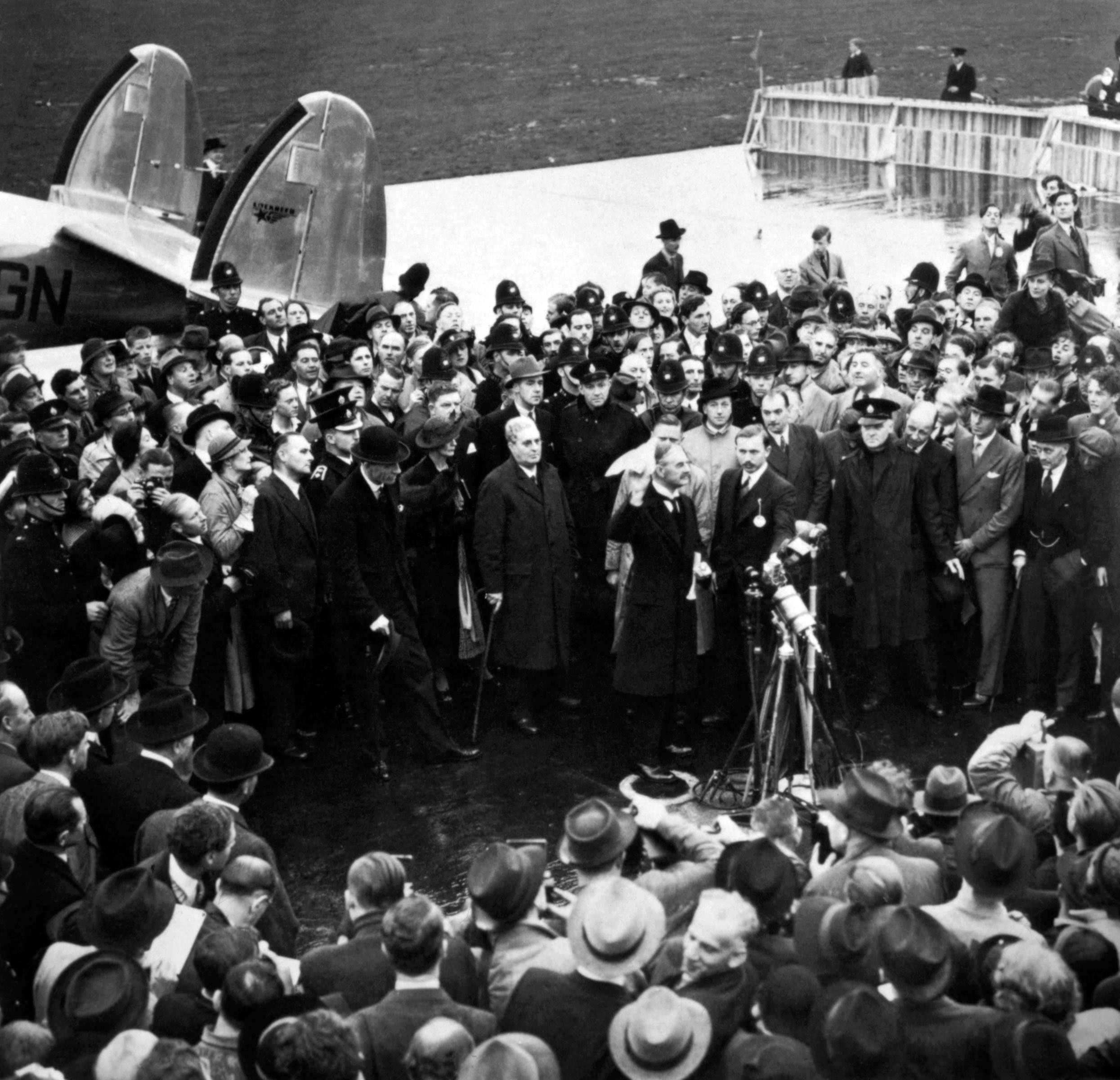
Czechoslovakia refused to concede territory. Hitler prepared to strike. France and the Soviet Union pledged to support the young nation against German aggression. As tension mounted, the United Kingdom’s Prime Minister Neville Chamberlain wished to preserve peace at all cost. He believed that war could be prevented by meeting Hitler’s demands. That policy became known as appeasement.
Chamberlain had several meetings with Hitler during September 1938 as Europe edged closer to war. Hitler raised his demands at each meeting. On September 29, Chamberlain and French Premier Édouard Daladier met with Hitler and Mussolini in Munich, Germany. Chamberlain and Daladier agreed to turn over the Sudetenland to Germany. They forced Czechoslovakia to accept the agreement. Hitler promised to demand no more territory in Czechoslovakia.
The Munich Agreement marked the height of the policy of appeasement. Chamberlain and Daladier hoped that the agreement would satisfy Hitler. They hoped it would prevent war—or at least prolong the peace until the United Kingdom and France were ready for war. The two leaders were mistaken on both counts.
The failure of appeasement soon became clear. Hitler broke the Munich Agreement in March 1939 and seized the rest of Czechoslovakia. He thereby added Czechoslovakia’s armed forces and industries to Germany’s military might. In the months before World War II began, Germany’s preparations for war moved ahead faster than did the military build-up of the United Kingdom and France. 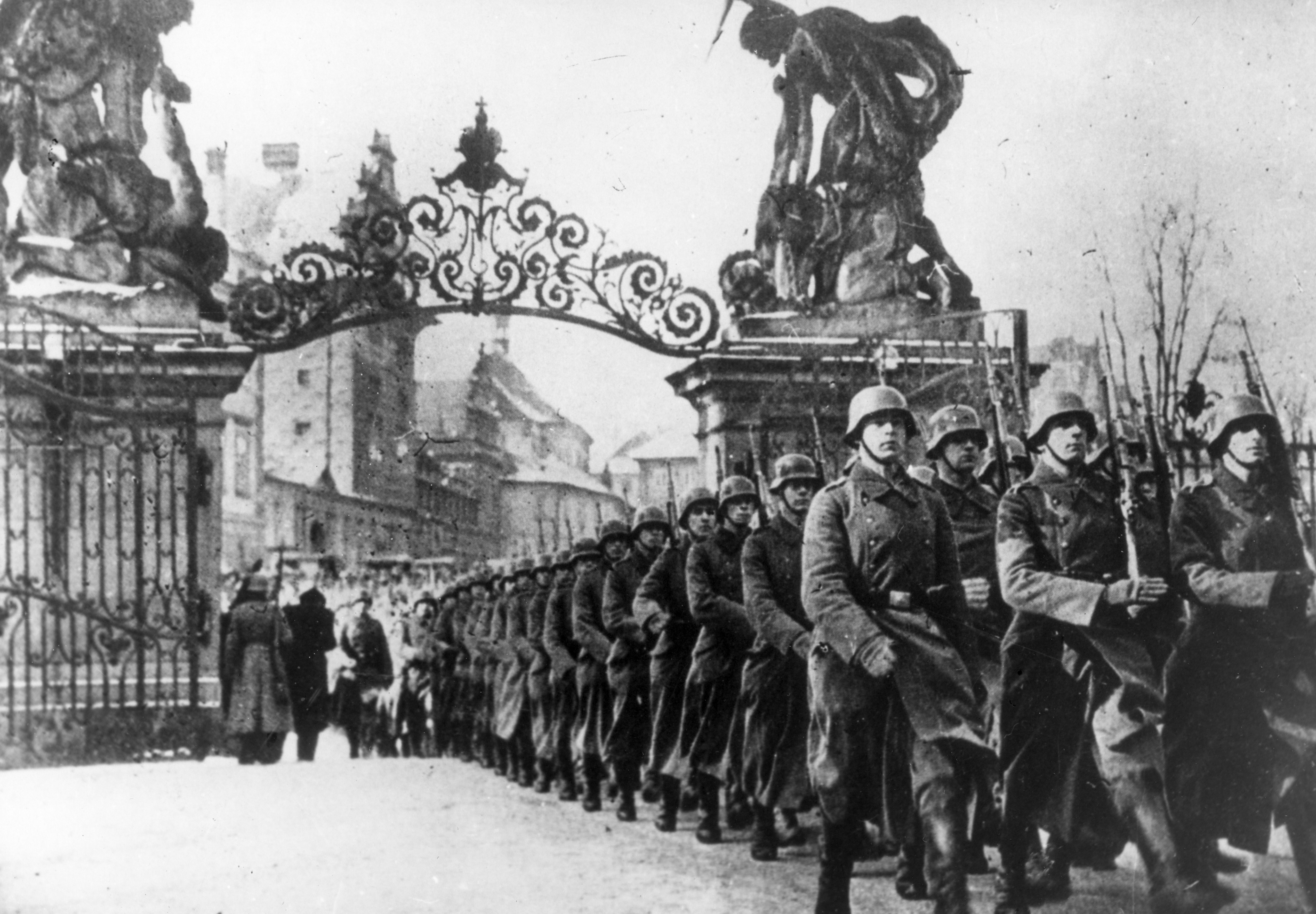
Early stages of the war
During the first year of World War II, Germany won a series of swift victories. It conquered Poland, Denmark, Luxembourg, the Netherlands, Belgium, Norway, and France. Germany then attempted to bomb the United Kingdom into surrendering, but failed.
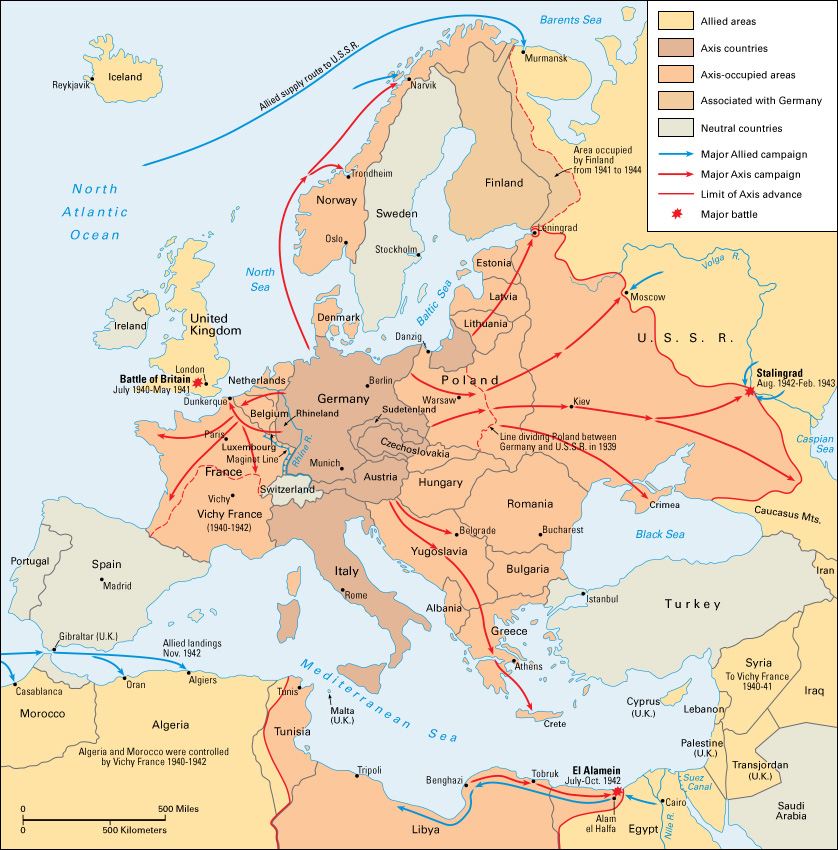
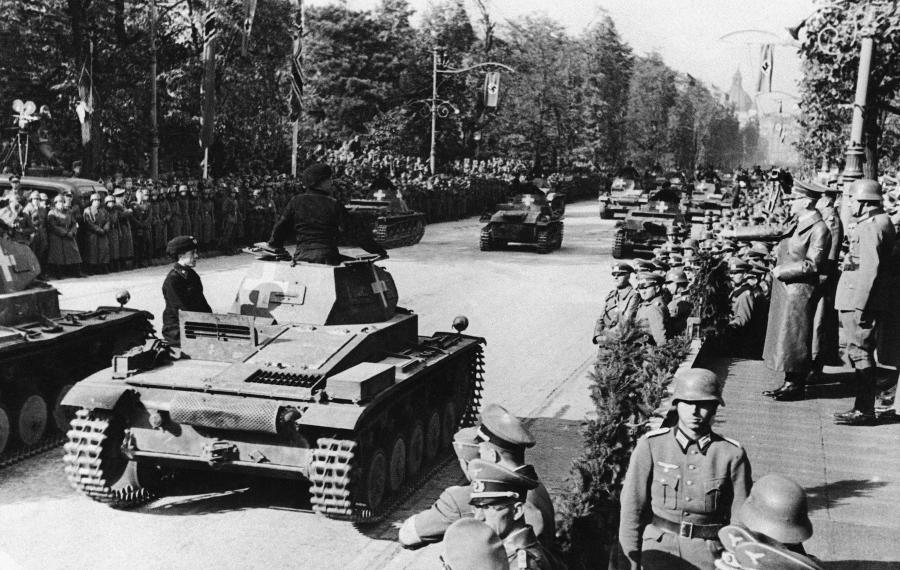
The invasion of Poland.
The port city of Danzig (Gdańsk) and the province of East Prussia were separated from Germany by the Treaty of Versailles. In March 1939, Hitler demanded the city’s return, as well as access to East Prussia. Poland refused. The United Kingdom and France pledged to help Poland if Germany attacked it. Yet the two powers could aid Poland only by invading Germany. Neither wanted to take that step. The United Kingdom had only a small army. France had prepared to defend its territory, not to attack.
The United Kingdom and France hoped that the Soviet Union would help defend Poland. But Hitler and Stalin shocked the world by becoming allies. On Aug. 23, 1939, Germany and the Soviet Union signed a nonaggression pact. In the agreement, they promised not to go to war against each other. They secretly planned to divide Poland between themselves.
On Sept. 1, 1939, Germany invaded Poland, beginning World War II. Poland had a large army but little modern equipment. Polish leaders expected to fight along the country’s frontiers. However, the Germans introduced a new method of warfare called blitzkrieg (lightning war). It stressed speed and surprise. Rows of tanks smashed through Poland’s defenses and rolled deep into the country before the Polish army had time to react. Swarms of German dive bombers and fighter aircraft knocked out communications and pounded battle lines. More than 1 million German troops swept across the Polish plains.
The Poles fought bravely. But the German attack threw their army into confusion. Adding to Poland’s troubles, Soviet forces invaded from the east on Sept. 17, 1939. Within two weeks, the Soviet Red Army occupied the eastern third of Poland. Germany had swallowed up the rest. When the fighting stopped on October 6, over 60,000 Polish troops were dead. So were tens of thousands of civilians. The Germans lost more than 10,000 killed in action.
The Phony War.
The United Kingdom and France declared war on Germany on Sept. 3, 1939, two days after the invasion of Poland. But the two countries did little while Poland collapsed. France moved troops to the Maginot Line. The line was a belt of steel and concrete fortresses it had built along its border with Germany. The United Kingdom sent a small force into northern France. Germany stationed troops on the Siegfried Line, a strip of defenses Hitler built in the 1930’s opposite the Maginot Line. The two sides avoided fighting in late 1939 and early 1940. Journalists called the period the “Phony War.”
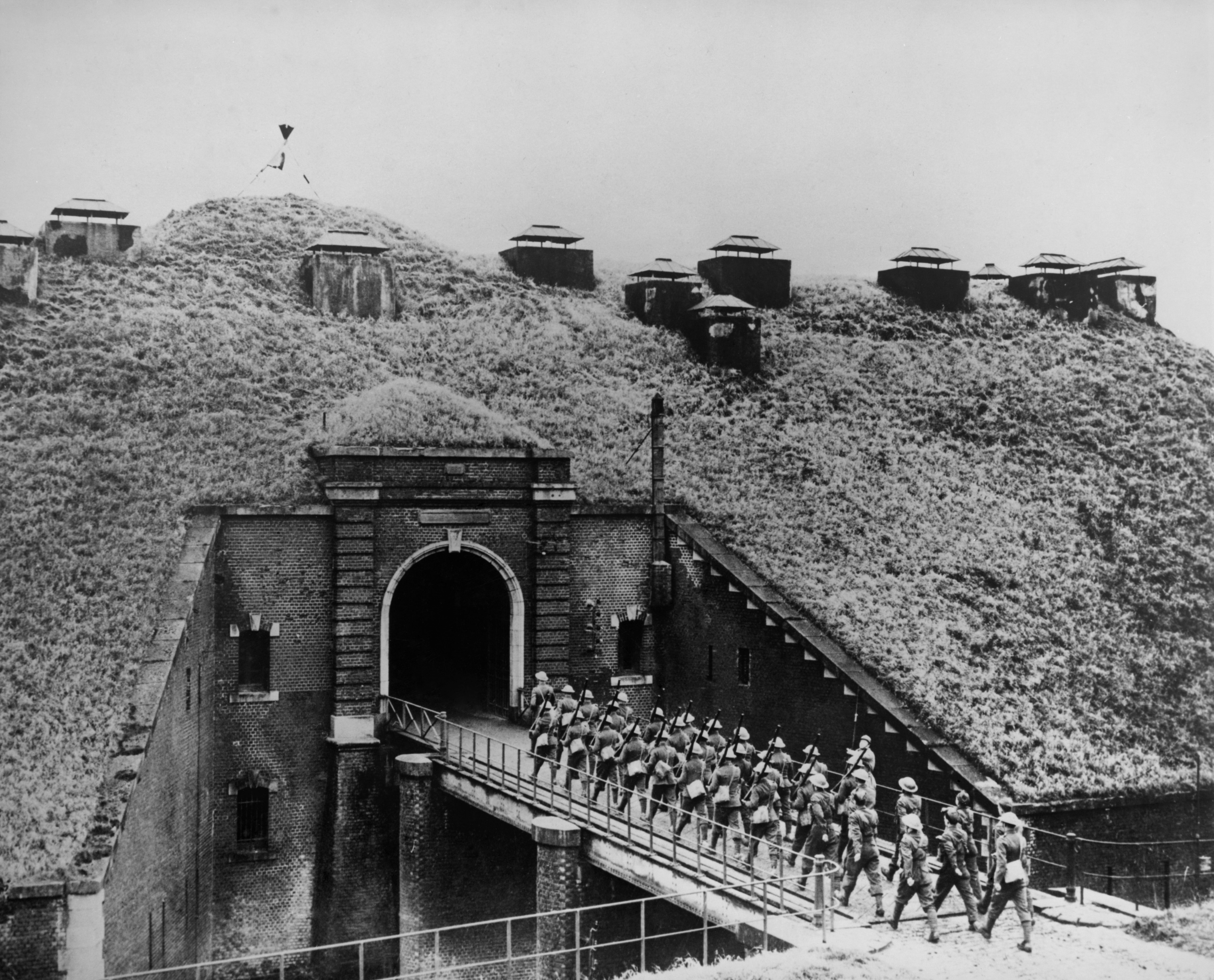
The conquest of Denmark and Norway.
After the outbreak of war in September 1939, Denmark, Finland, Norway, and Sweden announced their neutrality. Germany depended heavily on Swedish iron ore shipments through neutral Norway. Hitler feared British plans to cut off those shipments by laying explosives in Norway’s coastal waters. On April 9, 1940, German forces invaded Norway and Denmark. Denmark surrendered the same day. The United Kingdom tried to help Norway. But Germany’s air power prevented many British ships and troops from reaching the country. Norway surrendered on June 10, 1940. The conquest of Norway secured Germany’s shipments of iron ore. It also provided bases for German submarines and aircraft. About 5,000 Germans were killed in the conquest. So were over 6,000 Allied troops (British, French, Norwegian, and Polish).
Chamberlain, who had favored appeasement, resigned after the invasion of Norway. Winston Churchill replaced him as the United Kingdom’s prime minister on May 10, 1940. Churchill told the British people he had nothing to offer them but “blood, toil, tears, and sweat.”
The invasion of the Low Countries.
The Low Countries—Belgium, Luxembourg, and the Netherlands—hoped to remain neutral after World War II began. However, Germany launched a blitzkrieg against them on May 10, 1940. Luxembourg surrendered in one day. The Netherlands gave up in five days. British and French forces rushed into Belgium and fell into a German trap. As the Allied forces raced northward, the main German invasion cut behind them through the Belgian Ardennes Forest to the south. The Germans reached the English Channel on May 21. They had nearly surrounded the Allied forces in Belgium.
King Leopold III of Belgium surrendered on May 28, 1940. The surrender left the Allied forces in Belgium trapped. They retreated to the French seaport of Dunkerque on the English Channel. To rescue the troops, the United Kingdom sent all available seacraft. The fleet of “little ships” included destroyers, yachts, ferries, fishing vessels, and motorboats. Under heavy enemy fire, the hastily assembled fleet safely ferried about 338,000 troops to England from May 26 to June 4. 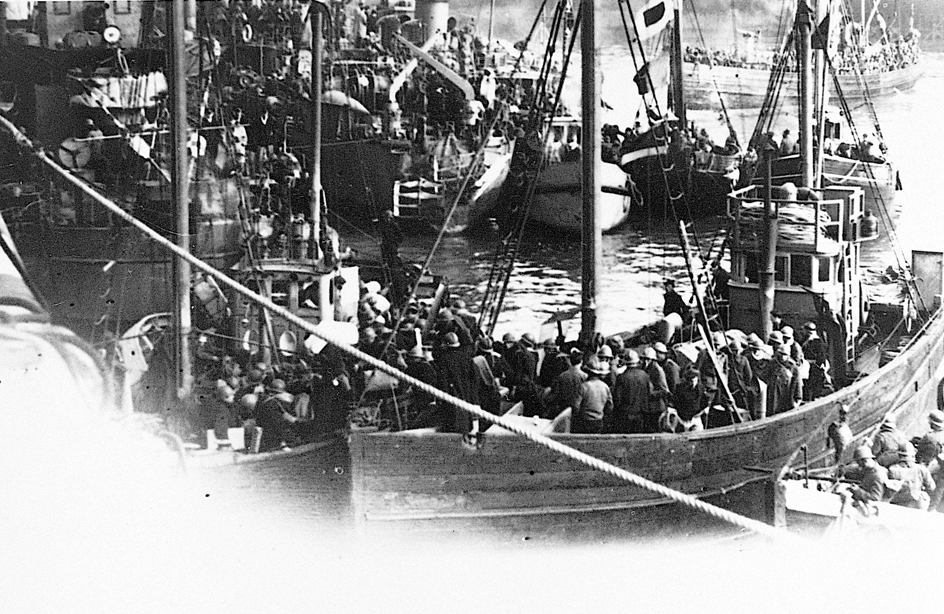
The relief of Dunkerque saved many soldiers to fight another day. About 35,000 Allied troops were left behind. So were tens of thousands of vehicles and tanks. The British Royal Air Force (RAF) lost more than 100 warplanes protecting the evacuation.
The fall of France.
France had expected to fight along a stationary battlefront. The country had built the Maginot Line to defend the front. But in May 1940, German tanks and aircraft passed around the line. They swept through Luxembourg and Belgium and into northern France. On June 5, the Germans launched a major assault along the Somme River. The Somme had been the scene of brutal slaughter in World War I. The blitzkrieg overwhelmed the French forces, driving them mercilessly backward. Seeing an opportunity to profit from Germany’s success, Italy declared war on France and the United Kingdom on June 10. The French government fled from Paris to Bordeaux the same day.
German troops entered Paris on June 14, 1940. Paul Reynaud, the new French premier, wanted to fight on. But many of his generals and cabinet officers believed that the battle for France was lost. Reynaud resigned. A new French government agreed to an armistice (truce) on June 22.
Under the terms of the armistice, Germany occupied the northern two-thirds of France and a strip of western France along the Atlantic Ocean. Southern France remained in French control. The town of Vichy became the capital of unoccupied France. Marshal Henri Philippe Pétain, a French hero of World War I, headed the Vichy government. He largely cooperated with the Germans. Then in November 1942, German troops occupied all France.
One of the French generals, Charles de Gaulle, escaped to the United Kingdom after France fell. In radio broadcasts to France, he urged the people to carry on the fight against Germany. The troops who rallied around de Gaulle became known as the Free French.
During the conquest of the Netherlands, Belgium, Luxembourg, and France, about 27,000 German troops died. More than 100,000 Allied soldiers lost their lives. The dead included about 90,000 French.
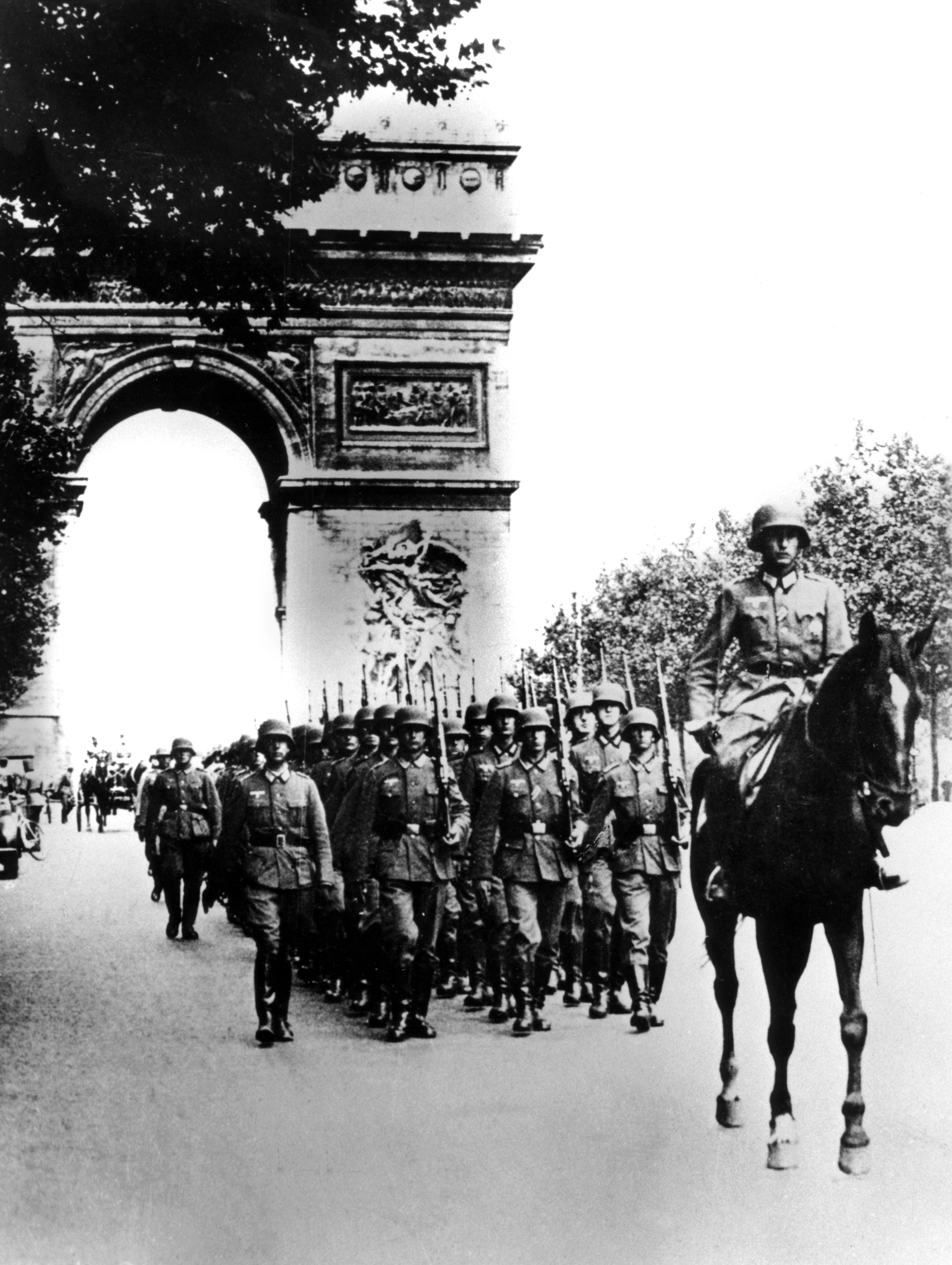
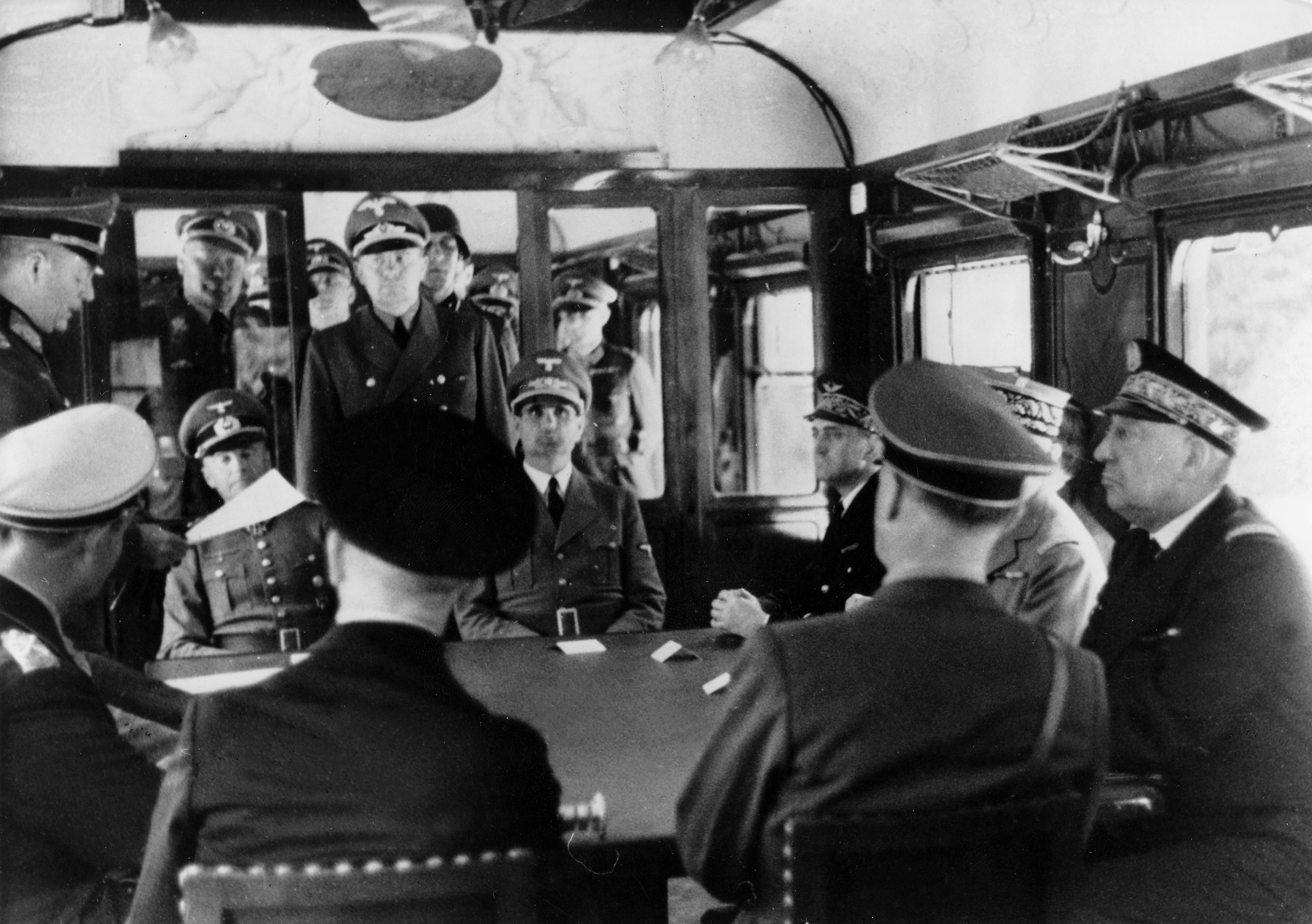
The Battle of Britain.
The Royal Air Force (RAF) Fighter Command of the United Kingdom lost nearly half its strength in the Battle of France. The Germans took some time to coordinate newly captured air bases and prepare to attack yet again. The British took advantage of this precious time to replace the planes and pilots lost over France. Flyers from Australia, Canada, Czechoslovakia, New Zealand, Poland, South Africa, and elsewhere helped replenish the ranks. Prime Minister Churchill told Parliament: “What General Weygand called the Battle of France is over. The Battle of Britain is about to begin.”
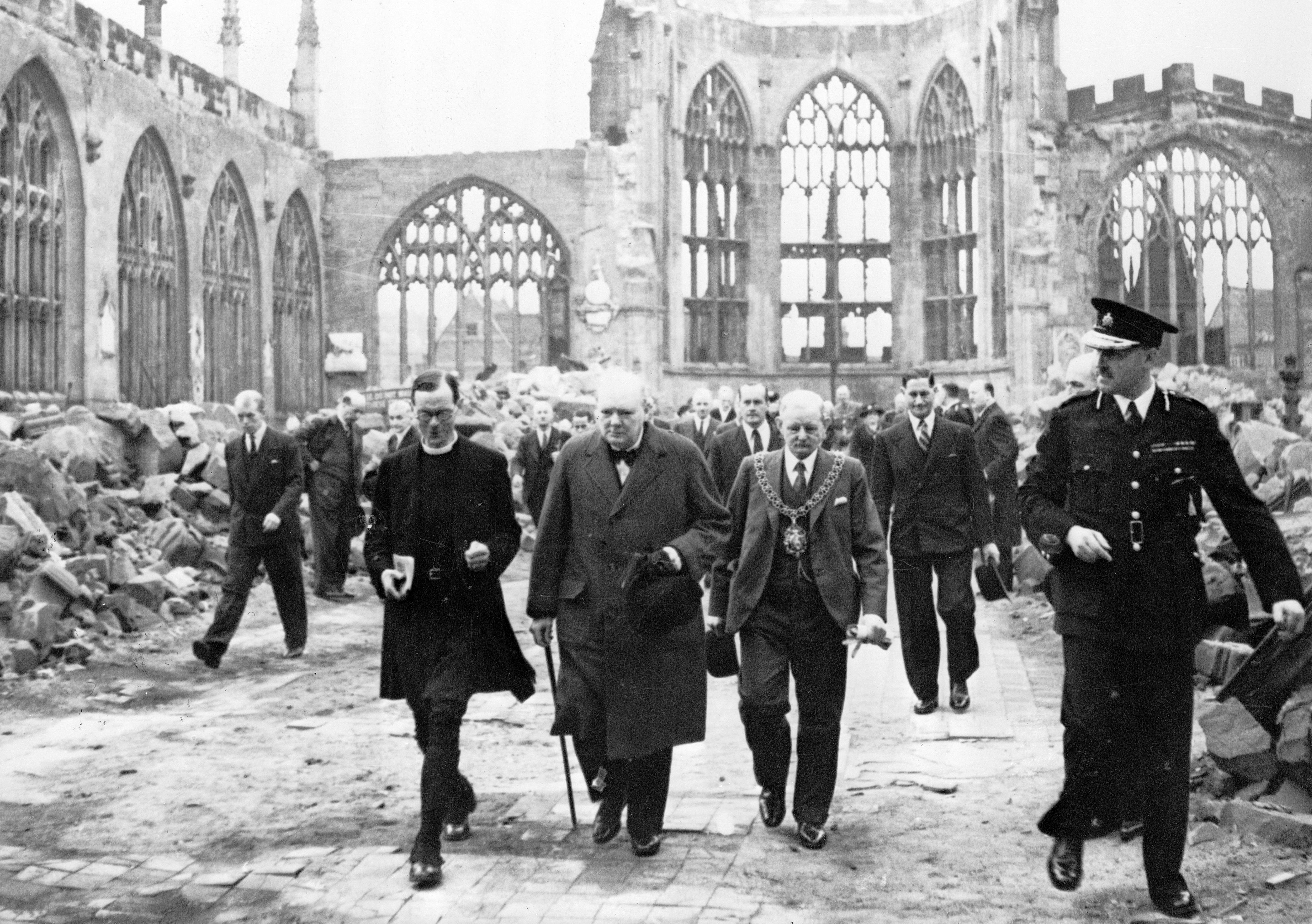
Hitler believed that the United Kingdom would now seek peace. The British, however, were determined to resist the Nazis. The United Kingdom fought on alone. Hitler prepared to invade southern England in a military operation with the code name Sea Lion. But before an invasion force could safely cross the English Channel, Hitler had to clear the RAF from the sky. The Battle of Britain was the first battle ever fought solely for air supremacy.
In July 1940, the German air force, the Luftwaffe, began to attack RAF and Royal Navy bases. Germany’s bombers and fighter planes outnumbered the RAF’s fighters by more than 4 to 1. But the previous victories of the Luftwaffe had come against nations with inferior air forces. The RAF had two outstanding types of pursuit plane—the Hurricane and the Spitfire. The RAF had also greatly developed the new technology of radar. RAF radar stations could detect German squadrons as they left their airfields in France. 
The air campaign was violent and costly for both sides. Of the nearly 3,000 British and Allied pilots who took part in the Battle of Britain, more than 500 were killed. The RAF lost about 900 aircraft. For the Germans, it was worse. Germany lost around 1,750 aircraft along with 2,600 aviators and crew. Operation Sea Lion was scrapped. But the bombing continued.
Hitler had originally ordered that no civilian targets should be attacked. But in late August, a lost Luftwaffe pilot violated his orders and bombed central London. An outraged Churchill retaliated with a bombing attack on Berlin. Hitler then unleashed his air force against English cities. He thus began what is known as the Blitz. German planes bombed cities from London to Manchester day after day, then night after night for months. Raids continued throughout the winter and spring. Finally, in May 1941, Germany gave up its attempts to defeat the United Kingdom from the air. More than 40,000 British civilians had lost their lives. 
Hitler’s decision to switch attacks from RAF bases to British cities effectively won the battle for the United Kingdom. It allowed the RAF to constantly replace both planes and pilots. The United Kingdom’s survival became important later in the war. The island served as an airfield and base for the Allied invasion of Europe. The British Army and High Command also made crucial contributions to the ultimate Allied victory.
The war spreads
By the end of 1941, World War II had become a global conflict. Battles erupted in Africa, the Balkan Peninsula of southeastern Europe, and the Soviet Union. The Axis and the Allies also battled each other at sea and in Asia. In December 1941, the United States entered the war.
The Western Desert Campaign.
The Italian army opened battlefronts in Africa in the summer of 1940. In August, Italian troops pushed eastward from Ethiopia. They overran the British forces in British Somaliland (now Somalia). The following month, forces from the Italian colony of Libya invaded Egypt.
Fighting seesawed back and forth across the Mediterranean coasts and deserts of Libya, Tunisia, and Egypt. The United Kingdom fought to protect the oil fields of the Middle East. It also tried to defend the Suez Canal, the shortest sea route for the crucial exchange of supplies and troops with Asia. British and Commonwealth troops struck back at the Italians in December 1940, sweeping them from Egypt. But an Axis invasion of Greece drew part of the Allied force from Africa and ended the Allied advance. 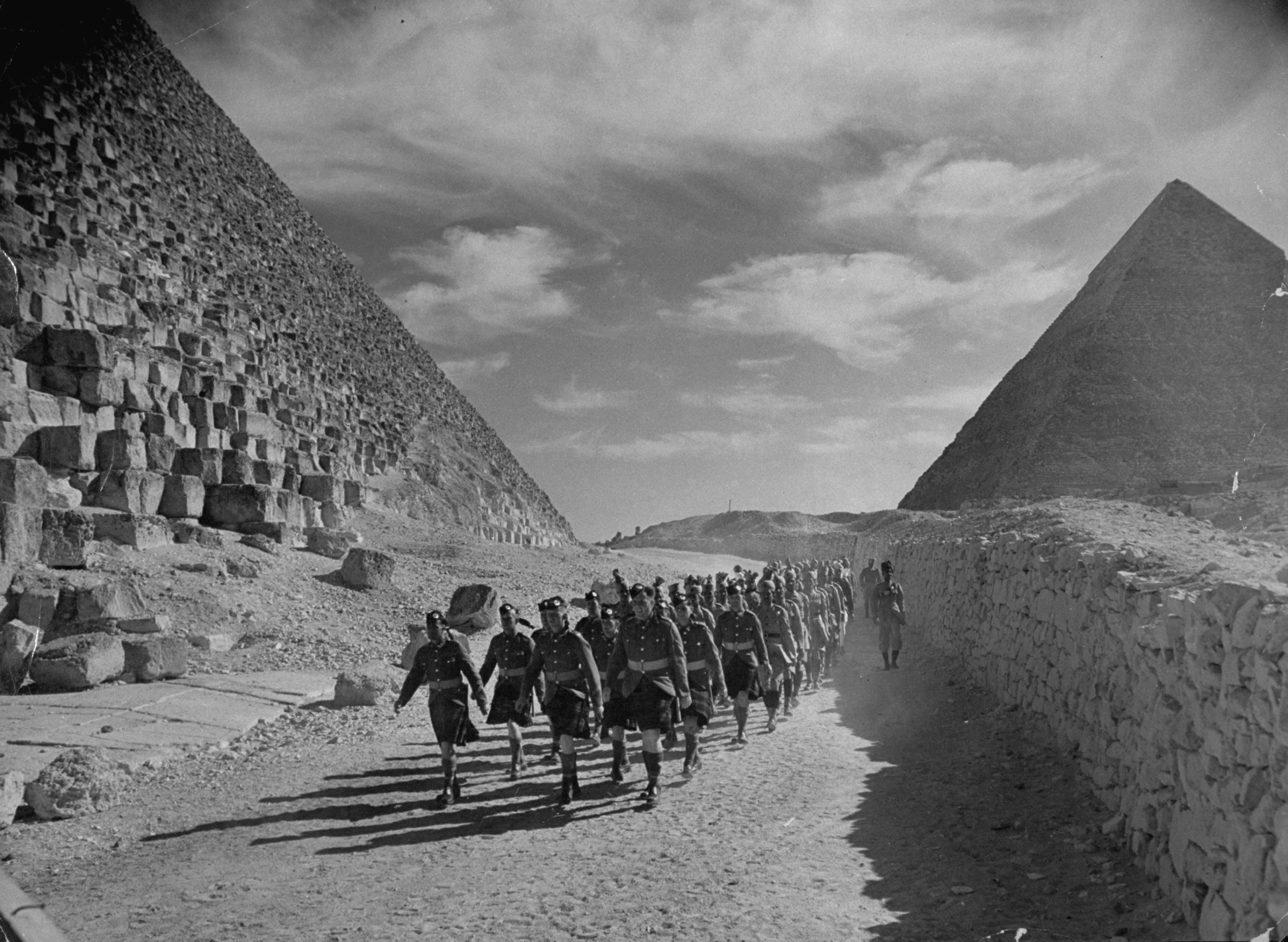
Early in 1941, Hitler sent panzer (tank) units trained in desert warfare to help the Italians in North Africa. German Field Marshal Erwin Rommel led the panzer units. They were known as the Afrikakorps. Rommel’s clever tactics earned him the nickname “The Desert Fox.” After a series of battles in Libya, Rommel drove into Egypt. But the British again repelled the Axis forces. In May 1942, Rommel broke through into Egypt again. He threatened the port of Alexandria, the capital city of Cairo, and the vital Suez Canal. British forces led by Lieutenant General Bernard Montgomery met Rommel at El Alamein on Oct. 23, 1942. The ensuing tank battle raged until November 5, when Rommel’s defeated forces withdrew. The Desert War, however, was far from over.
Allied dead in the Western Desert amounted to more than 35,000. More than 30,000 German and Italian soldiers were killed.
Fighting in the Balkans.
Hitler pressured Bulgaria, Hungary, and Romania into joining the Axis. These countries provided Germany with vast supplies of food, petroleum, and personnel. Yugoslavia’s government signed an agreement with the Axis in March 1941. But the Yugoslav military rebelled and overthrew the government. An enraged Hitler ordered the young nation crushed. German troops poured into Yugoslavia on April 6. Yugoslavia surrendered on April 17. But underground resistance there remained stubborn and deadly until the end of the war.
Mussolini had tired of playing Hitler’s junior partner. He wanted a victory to boost his standing. On Oct. 28, 1940, Italian forces based in Albania invaded Greece. They expected to defeat the poorly equipped Greek army easily. Though outnumbered, the Greeks fought fiercely. By December, they had driven the Italians out of Greece and had overrun part of Albania. The United Kingdom sent a small force to help the Greeks. But in April 1941, a much larger German force came to the aid of the Italians. By the end of the month, the Axis was in control. British troops had withdrawn to the island of Crete.
On May 20, 1941, thousands of German paratroopers descended on Crete and seized an airfield. More German troops then landed, securing the island. The victory gave Germany an important base in the Mediterranean. 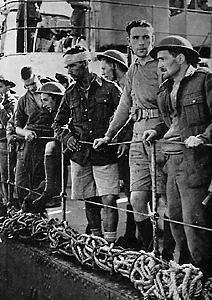
Thousands of Allied and Axis troops died in the Balkan Campaign. The defeats in the Balkans were blows to the Allies. However, the detours into Yugoslavia and Greece were costly for Hitler too. They delayed his invasion of the Soviet Union.
The invasion of the Soviet Union.
The Soviet Union and its enormous Red Army were constant threats to Hitler. He privately viewed them—and Communism itself—as Germany’s chief enemy. He feared Soviet ambitions to expand in eastern Europe, while planning to expand there himself. The German dictator desired more lebensraum (living space) for his people. Hitler also wanted control of the vast wheat and oil fields of Ukraine and elsewhere within the Soviet Union. The 1939 nonaggression pact with Stalin was a stalling tactic on both their parts. It served merely to keep the Soviet Union out of the war while Germany overran western Europe.
Stalin sought to obtain more naval bases and strengthen Soviet borders. In November 1939, the Soviet Union invaded Finland. An outnumbered and outgunned Finnish army fought fiercely for five months in what came to be known as the Winter War. Finland surrendered in March 1940, giving Stalin minor territorial concessions. The much smaller Finnish Army lost about 25,000 troops killed in action. The Red Army lost about 200,000. In the summer of 1940, the Soviet Union seized the countries of Estonia, Latvia, and Lithuania along the Baltic Sea.
The length and difficulty of Stalin’s Winter War with Finland helped give Hitler a low opinion of the Red Army. The Soviet Union may have had the largest army in the world at the time. But the German army was better trained, better equipped, and better led. 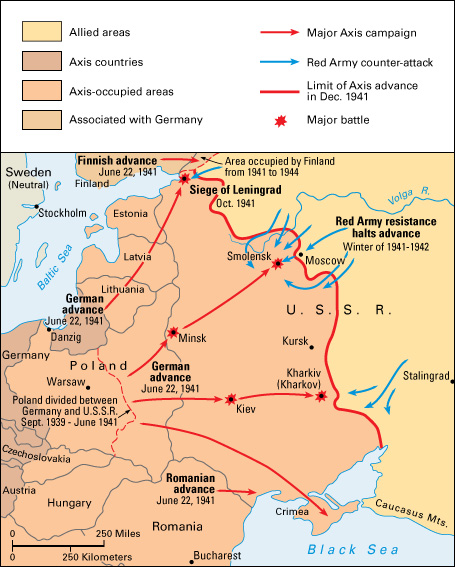
The German invasion of the Soviet Union, Operation Barbarossa, began on June 22, 1941. It started five weeks later than Hitler had intended. His generals warned of the dangers of the Russian winter. But Hitler was confident the fighting would be over before the first snowfall. Stalin ignored Allied warnings of the coming invasion. The attack took the Soviet Union by surprise.
More than 3 million German and Axis troops invaded along a 2,000-mile (3,220-kilometer) front. Germany’s Panzerkorps, an armored and mechanized unit, smashed through the Soviet lines. Luftwaffe squadrons devastated the Red Air Force. In just a few weeks, the Germans killed or captured hundreds of thousands of Soviet soldiers. The Germans pushed far into Soviet territory. As the Red Army and civilians retreated, they destroyed factories, dams, railroads, and food supplies. They wanted to deprive the enemy of anything that might be useful.
Looking for the killer blow, Hitler’s generals wanted to press on immediately to Moscow. Instead, Hitler sent his Panzerkorps to join the German armies heading through Ukraine toward the Crimean Peninsula on the Black Sea. While the Germans weakened their center and spent time transferring forces, Stalin reinforced. The German advance slowed. But on September 19, the Germans took the city of Kyiv (also spelled Kiev). It was Germany’s greatest single victory of the war, Germany captured nearly 665,000 Soviet soldiers. A total of 1 1/2 million Soviets had been taken prisoner thus far in the campaign. Another 700,000 had been killed. German dead had already passed 100,000.
In October, the Panzerkorps returned to the German center for the advance on Moscow. But the autumn rains had come. German tanks and artillery bogged down in the mud just 40 miles (64 kilometers) from the Russian capital. On Nov. 15, 1941, exhausted German soldiers attacked Moscow. Fresh Soviet troops from the Far East combined with the onslaught of winter to stop the Germans 20 miles (32 kilometers) from the city. The Germans had no winter clothing. Temperatures plunged to –40 °F (–40 °C). The German soldiers suffered terribly. Tanks and weapons seized up. Stuck vehicles became a part of the frozen earth. As it had been in wars past, winter was once again Russia’s greatest ally.
By December 1941, Operation Barbarossa had claimed the lives of 200,000 German soldiers. Thousands of Croatians, Hungarians, Italians, Romanians, and Slovaks were among them. The Red Army had already suffered hundreds of thousands killed and more than 3 million captured. The worst fighting, however, was yet to come.
The Battle of the Atlantic.
The Allied war effort depended heavily on shipments of food, military equipment and supplies, and other provisions across the Atlantic Ocean from North America. Germany tried to stop the shipments. The Allies struggled to keep the supplies coming. 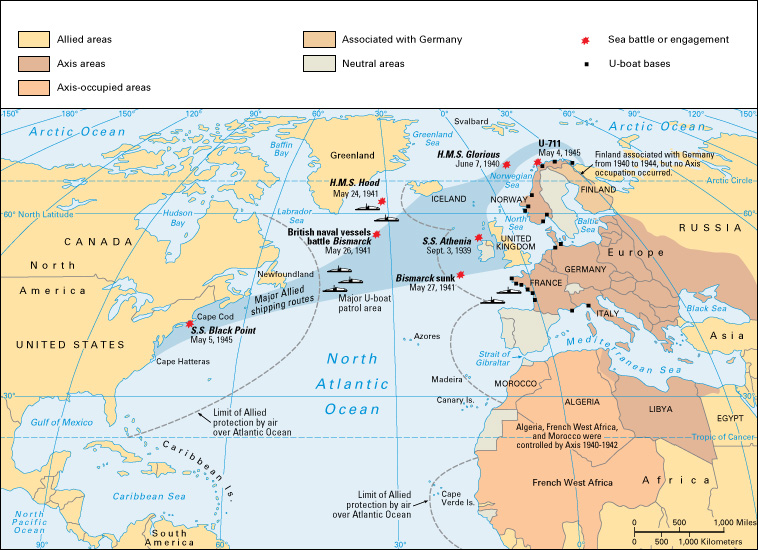
Germany’s surface fleet could not seriously challenge the United Kingdom’s Royal Navy. But German warships attacked merchant vessels (commercial ships). The Royal Navy hunted down and sank such raiders one by one. The biggest operation was against the powerful German battleship Bismarck. In May 1941, a fleet of British warships chased, trapped, and finally sank the Bismarck. Afterward, Germany‘s large warships rarely left harbor.
The greatest threat to Allied shipping came from German submarines, called Unterseeboote or U-boats. The U-boats prowled the Atlantic. They torpedoed any Allied ships they spotted. The conquests of Norway and France gave Germany bases for its U-boats. As a defensive measure, the United Kingdom began to use a convoy system in which merchant ships sailed in large groups escorted by warships.
From 1940 to 1942, Germany appeared to be winning the Battle of the Atlantic. Each month, U-boats sank thousands of tons of Allied shipping. But the Allies gradually overcame the U-boat danger. They used surface radar and an underwater detection device called sonar to locate German submarines. Long-range aircraft bombed U-boats as they surfaced. Shipyards in North America stepped up their production of warships to accompany convoys. Eventually, the Allies were sinking U-boats faster than Germany could replace them. After terrible losses in “Black May” 1943, the U-boat “wolf packs” retreated and regrouped. The U-boats resumed action in the fall. But they never regained their previous success.
The Battle of the Atlantic was the longest military campaign of World War II. It lasted the length of the war. The Germans launched nearly 1,200 submarines. Of these, close to 800 were sunk. Out of about 40,000 German submariners sent into action, 28,000 never returned—the highest death rate of any armed service in the history of modern warfare. About 3,000 Allied ships sank to the bottom of the Atlantic Ocean, and more than 70,000 Allied merchant mariners, sailors, and aviators lost their lives.
The United States enters the war
After World War II began in 1939, President Franklin D. Roosevelt announced the neutrality of the United States. Canada, as part of the Commonwealth of Nations, entered the war on Sept. 10, 1939, one week after the United Kingdom.
Loading the player...
The world at war, part 1
Loading the player...
The world at war, part 2
Roosevelt and many other people wanted to do more to help the Allies. These people, called interventionists, argued that an Axis victory would endanger democracies everywhere. Roosevelt urged “all aid short of war” to nations fighting the Axis. Isolationists, on the other hand, thought that the United States should not interfere in European affairs. They opposed aid to warring nations. They accused Roosevelt of steering the nation into a war it was not prepared to fight. The majority of people in the United States thought the Allied cause was just. But they wanted their country to stay out of World War II.
The arsenal of democracy.
Roosevelt hoped to contribute to the defeat of the Axis powers by equipping the Allies. Roosevelt asked his fellow Americans to become what he called “the arsenal of democracy,” meaning that the United States would supply military equipment to the Allies. The United States sent ships, tanks, aircraft, and other war equipment.
The United States then took several steps toward war. In November 1939, U.S. neutrality laws were changed to allow the sale of arms to warring nations—specifically the United Kingdom and France. In September 1940, the U.S. Navy gave the United Kingdom 50 destroyers to protect Atlantic convoys. In March 1941, with the Allies nearly broke, the U.S. Congress approved the Lend-Lease Act. The act permitted President Roosevelt to lend or lease raw materials, supplies, and weapons to any nation fighting the Axis. In all, 38 nations received a total of about $50 billion in aid through the Lend-Lease Act. More than half the aid went to the British Empire. About a fourth went to the Soviet Union.
Japan attacks.
By 1940, Japanese forces were still bogged down in China. To force the Chinese to surrender, Japan wanted to cut off the supply route from Southeast Asia. Japan also wanted the rich resources of Burma (now Myanmar) and Indochina (parts of modern Laos and Vietnam) for itself. Japan’s military leaders had hopes of an empire. They called it the Greater East Asia Co-Prosperity Sphere. Loading the player...
Attack on Pearl Harbor
Japan’s expansion in Southeast Asia troubled the United States. In September 1940, as Japanese troops occupied northern Indochina, the United States cut off vital exports to Japan. Japanese industries relied heavily on petroleum, scrap metal, and other raw materials from the United States. After Japan seized the rest of Indochina in 1941, Roosevelt barred the withdrawal of Japanese funds from American banks.
General Hideki Tojo became prime minister of Japan in October 1941. Tojo and Japan’s other military leaders realized that only the United States Navy had the power to block Japan’s expansion in Asia. They decided to cripple the U.S. Pacific Fleet with one forceful blow. Loading the player...
Franklin Roosevelt responds to Pearl Harbor attack
On Dec. 7, 1941, the Japanese launched a surprise attack upon the U.S. Pacific Fleet at Pearl Harbor, Hawaii. Two waves of Japanese warplanes sank several U.S. ships, including four battleships. They also destroyed more than 180 U.S. aircraft. The Japanese killed 2,400 Americans but lost only about 100 of their own troops. The attack was a success. But bringing the United States into the war would prove disastrous for the Japanese Empire and its citizens.
The United States, Canada, and the United Kingdom declared war on Japan on Dec. 8, 1941. Germany and Italy declared war on the United States on December 11. The world was now truly a world at war.
The war in Europe and North Africa
Soviet forces held off the German advance in eastern Europe in 1942. The Soviets won a major victory at Stalingrad (now Volgograd) in 1943. The Allies invaded North Africa in 1942 and forced Italy to surrender in 1943. Allied troops swarmed into France in 1944 in the largest seaborne invasion in history. Allied attacks from the east and the west forced Germany to surrender in 1945.
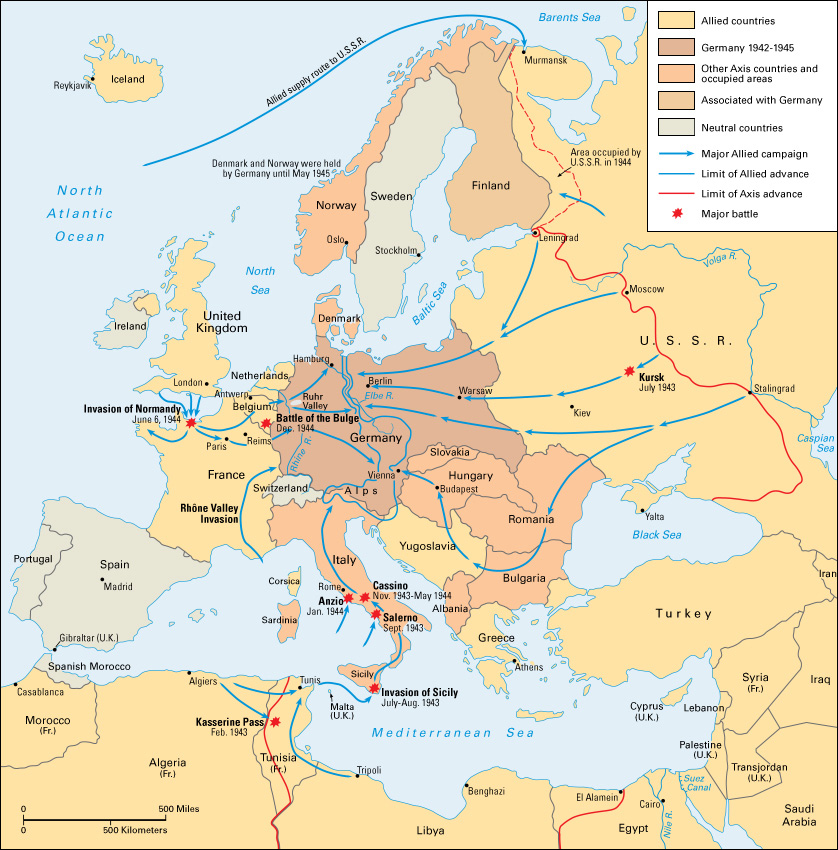

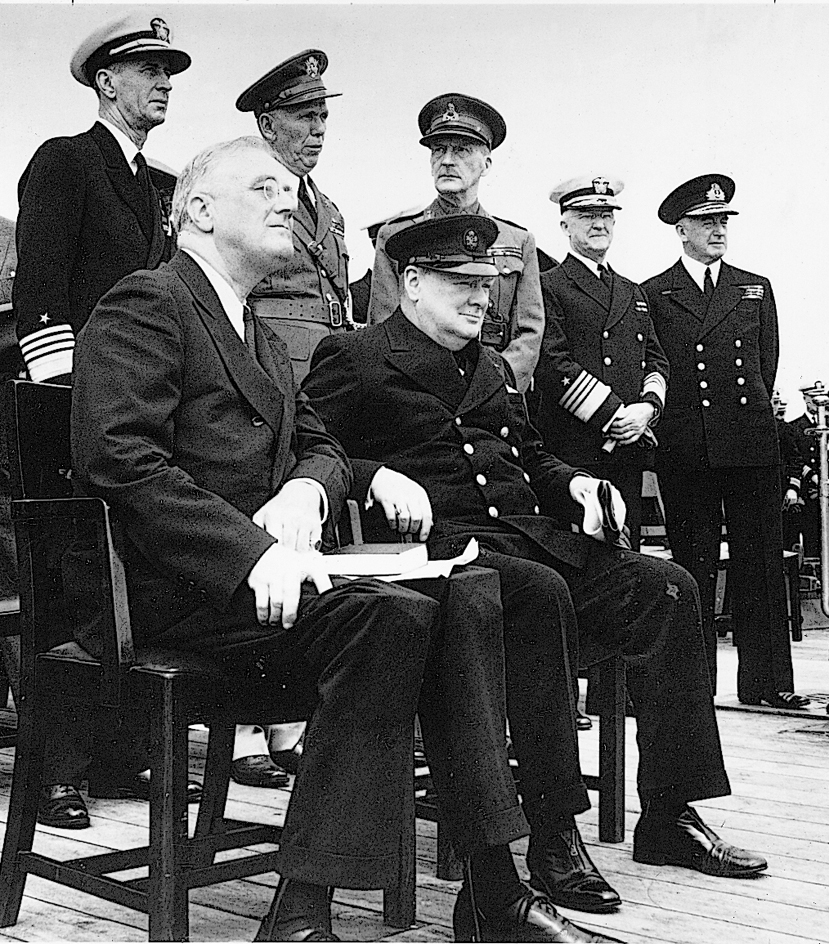
The strategy.
Churchill, Roosevelt, and Stalin—the leaders of the three major Allied powers—were known during World War II as the Big Three. Churchill and Roosevelt conferred frequently on overall strategy. Stalin directed the Soviet war effort. But he distrusted his allies’ intentions and rarely consulted them.
The main wartime disagreement among the Big Three concerned an Allied invasion of western Europe. Stalin constantly urged Roosevelt and Churchill to open a second fighting front in western Europe and thus draw German troops from the Soviet front. Both Roosevelt and Churchill supported the idea. But they disagreed on where and when to invade. The Americans wanted to land in northern France as soon as possible. The British argued that an invasion of France before the Allies were fully prepared would be disastrous. Instead, Churchill favored invading Italy first. His view won out.
Roosevelt and Churchill first met in August 1941 aboard ship off the coast of Newfoundland. They issued the Atlantic Charter, a statement of the postwar aims of the United States and the United Kingdom. After the Japanese attacked Pearl Harbor, Roosevelt and Churchill conferred in Washington, D.C. The two leaders felt that Germany was a nearer and a more dangerous enemy than Japan. They decided to concentrate on defeating Germany first.
In January 1943, Roosevelt and Churchill met in Casablanca, Morocco. They agreed to invade the Mediterranean island of Sicily after driving the Germans and Italians from northern Africa. At the conference, Roosevelt announced that the Allies would accept only unconditional (complete) surrender from the Axis powers. Churchill supported him.
Roosevelt and Churchill first met with Stalin in November 1943 in Tehran, Iran. The Big Three discussed plans for a joint British and American invasion of France in the spring of 1944. They did not meet again until Germany neared collapse. In February 1945, Roosevelt, Churchill, and Stalin gathered at Yalta, a Soviet city on the Crimean Peninsula. They agreed that their countries would each occupy a zone of Germany after the war. France was to occupy a fourth zone. Roosevelt died on April 12, 1945, less than one month before the end of the war in Europe.
The Battle of Stalingrad.
The Red Army struck back at the Germans outside Moscow on Dec. 5, 1941. The Soviets pushed the invaders back about 100 miles (160 kilometers). But as the weather broke in the spring months of 1942, the Germans regrouped and prepared for a summer offensive—Operation Blue. Hitler was now personally directing the war. He bolstered his battered armies with divisions from Hungary, Italy, Romania, Slovakia, and Spain.
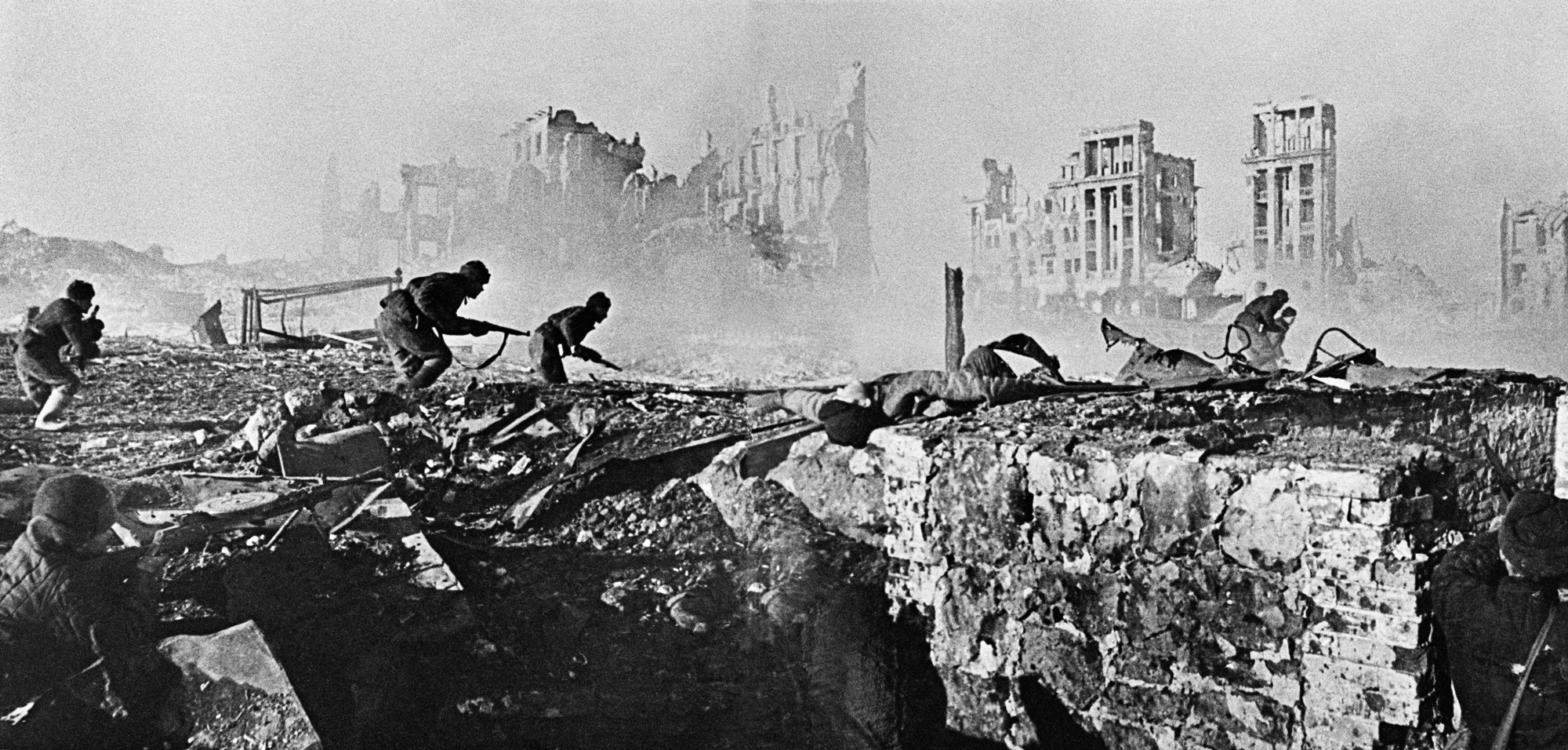
The combined Axis forces overran the Crimean Peninsula and headed eastward toward the rich oil fields in the Caucasus. Hitler ordered General Friedrich von Paulus to take the city of Stalingrad. About 1 million German soldiers poured into the city. The Soviets rose to meet them. Stalin had ordered, “Not one step back.” The savage battle for Stalingrad began in September and dragged through the autumn. The Germans took most of the city but could not hold it. Neighborhoods, city blocks, even individual buildings were fought over for days or weeks. Thousands of people died. Then the same buildings were fought over again.
Paulus’s losses mounted. The German commander repeatedly asked permission to pull out. Hitler repeatedly refused. Soviet troops counterattacked in mid-November. Eventually, they trapped Paulus’s army. The Luftwaffe attempted to resupply the army by air. But it was too little, too late. Each day, thousands of German soldiers froze, starved to death, or died of disease. On Feb. 2, 1943, after months of suffering, the last German troops in Stalingrad surrendered. 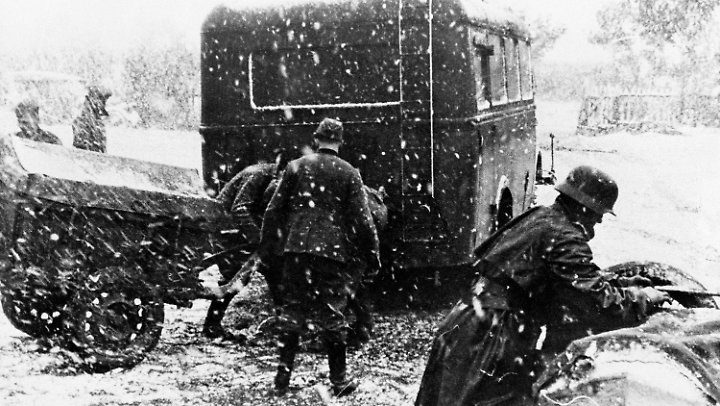
The Battle of Stalingrad halted Germany’s eastward advance. it marked a turning point in the war as advantage swung to the Soviets. It was one of the largest battles in human history. Its cost was horrific. About 450,000 Axis troops were killed. The Soviets lost at least 500,000 soldiers and hundreds of thousands of civilians.
The Siege of Leningrad.
In September 1941, the northern group of German armies surrounded the Russian city of Leningrad (now St. Petersburg). German warplanes and artillery bombarded the city. Nearly all supplies were cut off. The more than 2 million citizens and soldiers of Leningrad held out. They suffered through winters without electric power. They endured shortages of water, food, and medicine. All the while, they suffered bombardment by German artillery. By the time the Red Army broke through and lifted the siege in January 1944, 1 1/3 million Soviets were dead.
The Tunisia Campaign.
The Battle of El Alamein in late 1942, like Stalingrad, had marked a turning point in the war. The Axis never again attacked in North Africa. On Nov. 8, 1942, Allied troops commanded by Lieutenant General Dwight D. Eisenhower of the U.S. Army landed in Algeria and Morocco. Vichy French forces initially resisted the Americans. But within two days they had joined the Allied cause.
The Allies hoped to advance rapidly into Tunisia and cut off the Axis forces from their home bases in Italy and Sicily. But Axis troops moved faster and seized Tunisia first. There, Rommel prepared for battle. The first major clash between American and German combat troops was in mid-February during the fight for Kasserine Pass. Rommel defeated the inexperienced Americans. But thereafter, the Allies steadily closed in. Rommel returned to Germany. The last Axis forces in North Africa surrendered in May—about 250,000 of them. The Allies had saved the oil fields of the Middle East. They also sustained the supply route to Asia and cleared a path for the invasions of Sicily and Italy. 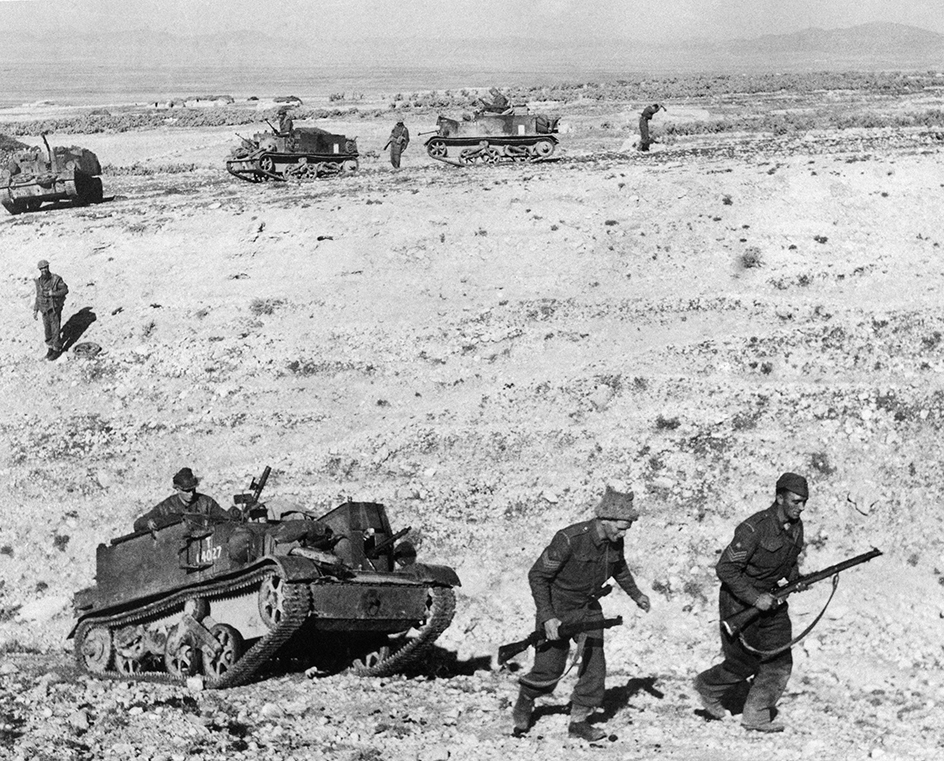
Axis dead in the Tunisian Campaign numbered over 14,000. The British, Americans, and French lost over 10,000 troops.
The air war.
Before World War II began, many aviation experts claimed that the long-range bomber was the most advanced weapon in the world. They believed that bombers could wipe out cities and industries. In this way, bombing could destroy an enemy’s desire and ability to go on fighting. The theory was tested during World War II.

By May 1941, Germany’s bombing of the United Kingdom had largely stopped. But RAF bombers pounded Germany until the end of the war. At first, the bombing was costly and ineffective. British losses were heavy. Bomber Command relied on area bombing. Area bombing involved dropping a large number of bombs on an area without pinpointing targets. Bomber Command also favored nighttime raids. Night raids were safer than daytime raids, but bombers too often missed their targets in the dark. In 1942, the United Kingdom turned to saturation bombing of German cities. Such bombing involved dropping enough bombs to totally destroy the target area. A massive group of more than 1,000 aircraft battered the railyards and city of Cologne on May 30, 1942. Bomber Command continued its nighttime raids on German cities to the end of the war. It made 35 raids on Berlin alone.
Meanwhile, the U.S. Army Air Forces had arrived. They joined the air campaign against Germany in 1942. The American B-17 bomber carried a better bombsight than British planes. B-17’s were known as Flying Fortresses because of their heavy armor and many guns. They could take much punishment. For those reasons, the Americans favored precision bombing. It involved placing bombs with a high degree of accuracy. The Americans directed their bombing at mostly industrial and military targets. They carried out their bombing raids during the day. 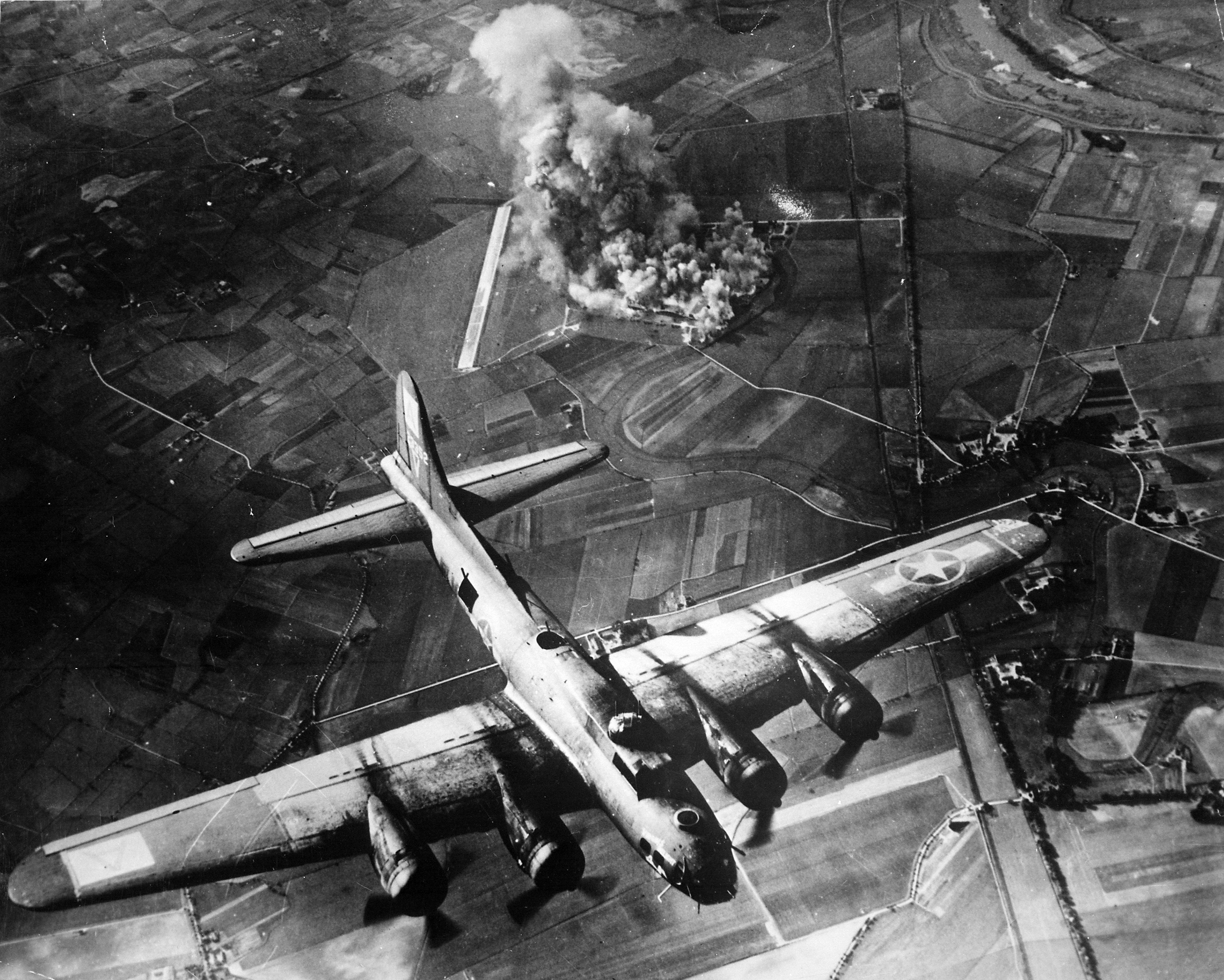
Over the course of the war, American and British bombers dropped more than 2.7 million tons (2.45 million metric tons) of explosives onto European targets. Nearly 160,000 Allied aviators were killed in the bombing campaign. About 500,000 German civilians also died.
In spite of the bombardment, German industries continued to increase production. German morale failed to crack. The air war achieved its goals only during the last 10 months of World War II. In that time, nearly three times as many bombs fell on Germany as in all the rest of the war. By the end of the war, Germany’s cities lay in ruins. Its factories, refineries, railroads, and canals had nearly ceased to operate.
Loading the player...The air war during World War II
Germany’s air defenses rapidly improved during World War II. The Germans used radar to spot incoming bombers. They used fighter planes and antiaircraft guns, called flak, to shoot them down. In 1944, Germany introduced the first jet fighter, the Messerschmitt Me 262. The plane was known as the Schwalbe (Swallow). The Swallow easily overtook the propeller-driven fighters of the Allies. Also in 1944, Germany used the first guided missiles against the United Kingdom. The V-1 and V-2 missiles caused great damage and took many lives. But these innovative weapons were too few and came too late to affect the war’s outcome. 
The invasion of Italy.
The Allies planned to invade Sicily after driving the Axis forces out of northern Africa. Axis planes had bombed Allied ships in the Mediterranean Sea from bases in Sicily. The Allies wanted to make the Mediterranean safe for their ships. They also hoped that an invasion of Sicily might knock a war-weary Italy out of the war.
Allied forces under Eisenhower landed along Sicily’s south coast on July 10, 1943. For 38 days, they engaged in bitter fighting with the enemy over rugged terrain. The last Germans left Sicily on August 17.
Mussolini had fallen from power on July 25. The Italian government imprisoned him. But German commandos later rescued the former dictator. Italy’s new prime minister, Field Marshal Pietro Badoglio, began secret peace talks with the Allies. Badoglio hoped to prevent Italy from becoming a battleground. Italy surrendered on September 3. But Field Marshal Albert Kesselring, Germany’s commander in the Mediterranean region, was determined to fight the Allies for control of Italy.
Allied forces led by U.S. Army Lieutenant General Mark W. Clark landed at Salerno, Italy, on Sept. 9, 1943. It was a struggle just to stay ashore. Another Allied force had already landed farther south. The Allies struggled up the Italian Peninsula in a series of head-on assaults against well-defended German positions. By early November, the Allies had reached the Gustav Line. The line was Germany’s formidable defensive line about 75 miles (120 kilometers) south of Rome. Repeated Allied assaults on Monte Cassino resulted in some of the most brutal fighting of World War II. The Gustav Line held.
In January 1944, the Allies landed at Anzio, west of Cassino, in an effort to attack the Germans from behind. However, German forces kept the Allies pinned down on the beaches at Anzio for four months. 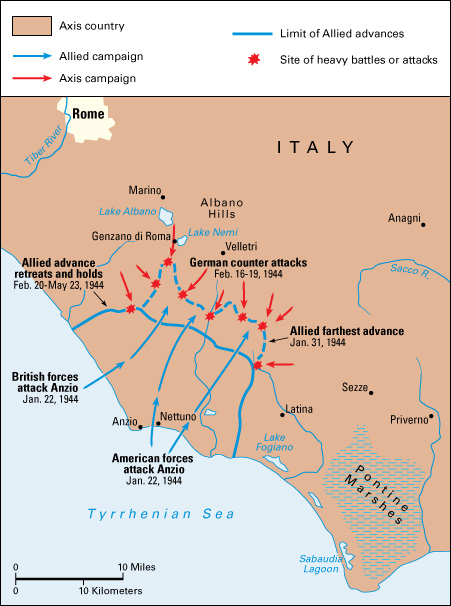
The Allies finally broke through German defenses in Italy in May 1944. Rome fell on June 4. The Germans held their positions in northern Italy through the fall and winter. But in the spring, the Allies swept toward the Alps. Italian resistance fighters captured Mussolini on April 27, 1945. They shot him on April 28. German forces in Italy finally surrendered on May 2. About 70,000 Allied soldiers died taking Italy. Around 48,000 Germans died defending it.
D-Day.
Soon after the evacuation of Dunkerque in 1940, the United Kingdom started to plan a return to France. In 1942, the United States and the United Kingdom began to discuss a large-scale invasion across the English Channel. To test the German defenses, the Allies raided the French port of Dieppe in August 1942. The mostly Canadian landing force suffered disastrous losses. The Allies learned hard lessons at Dieppe. Among the lessons was that landing on open beaches had a better chance of success than landing in a port. 
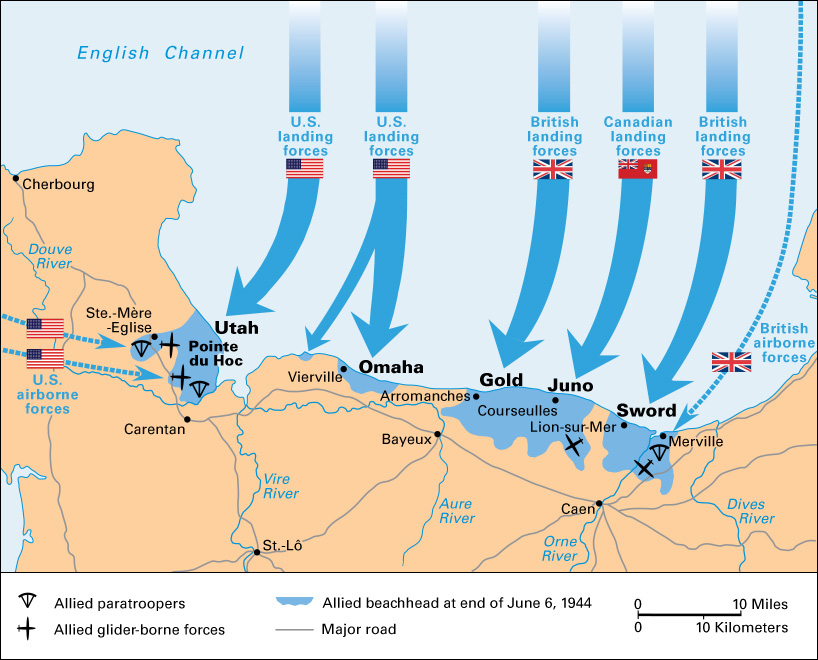
Invasion of France
Throughout 1943, preparations moved ahead for an invasion of northern France the following year. The invasion plan received the code name Operation Overlord. Huge amounts of equipment and great numbers of troops massed in southern England. General Eisenhower, as supreme commander of the Allied forces, directed the invasion.
The Germans expected an Allied invasion along the north coast of France in 1944. But they were unsure where. A chain of fortifications, which the Germans called the Atlantic Wall, ran along the coast. Hitler placed Rommel in charge of strengthening German defenses along the English Channel. Rommel brought in artillery. He placed explosive mines in the water and on the beaches. He also strung up barbed wire. The Germans concentrated their troops near Calais, at the narrowest part of the English Channel. But the Allies planned to land farther west, in a region of northern France called Normandy.
Eisenhower chose Monday, June 5, 1944, as D-Day—the date of the Normandy invasion. However, rough seas forced him to postpone until June 6. During the night, thousands of ships carrying landing craft and more than 130,000 landing troops crossed the channel. Minesweepers had gone ahead to clear the water. In addition, about 23,000 paratroopers and glider troops began dropping behind German lines. They captured bridges and railroad tracks. At dawn, battleships opened fire on the beaches. At 6:30 a.m., soldiers from the United States, the United Kingdom, Canada, and France stormed ashore. They landed on a 60-mile (100-kilometer) front. It was the largest seaborne invasion in history.

D-Day took the Germans by surprise. They responded fiercely. At one landing site, code-named Omaha Beach, U.S. troops came under heavy fire and barely managed to stay ashore. Nevertheless, all five Allied landing beaches were secure by the end of D-Day. The Allies soon had an artificial harbor in place for unloading more troops and supplies. A pipeline carried fuel across the channel. By the end of June 1944, about 1 million Allied troops had reached France.
The Allied forces advanced slowly. The Americans struggled westward to capture the port of Cherbourg. It fell on June 27. On July 18, British and Canadian soldiers finally captured Caen, which the British had hoped to capture on D-Day. On July 25, Allied bombers blasted a gap in the German front near St.-Lo, about 50 miles (80 kilometers) southeast of Cherbourg. The U.S. Third Army under Lieutenant General George S. Patton plowed through the hole. The battlefield had opened up. During August, the Allies cleared the Germans out of most of northwestern France. Allied bombers hounded the retreating Germans. More than 50,000 Allied troops and aviators died in the Battle of Normandy. Tens of thousands of Germans also lost their lives.
The drive to the Rhine.
Patton’s army rolled eastward toward Paris. On Aug. 19, 1944, Parisians rose up against the occupying German forces. Resistance fighters battled the Germans street by street. American and Free French forces liberated Paris on August 25. 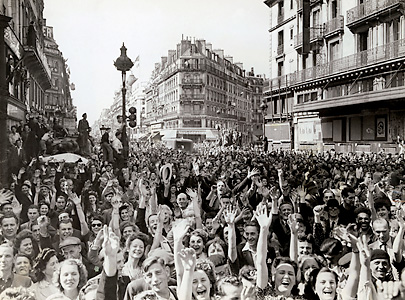
World War II Allied forces liberate France
In mid-August 1944, Allied forces landed in southern France. They moved rapidly up the Rhône River Valley. Meanwhile, Patton raced eastward through the region of Lorraine toward the German border and the Rhine River. In late August, his tanks ran out of fuel. To the north, British forces led by Field Marshal Montgomery swept into Belgium and captured Antwerp on September 4. The Allies planned a daring operation, code named Market Garden, to carry them across the Rhine. On September 17, about 35,000 airborne soldiers began dropping behind German lines to seize bridges in the Netherlands. Additional troops invaded by land. But poor planning and bad weather hampered the operation. It ended in failure. Another path to Germany would have to be found.
The Battle of the Bulge.
Germany’s generals knew they were beaten. But Hitler pulled his resources together for one more assault. On Dec. 16, 1944, German troops surprised and overwhelmed the Americans in the Ardennes Forest in Belgium and Luxembourg. However, the Germans lacked the troops and fuel to turn their thrust into a breakthrough. Within two weeks, the Americans stopped the German advance near the Meuse River in Belgium.
The Ardennes offensive is known as the Battle of the Bulge because of the bulging shape of the battleground on a map. It was the bloodiest battle for the Americans in World War II. About 80,000 Americans were killed, wounded, captured, or missing. The campaigns from September 1944 to January 1945 resulted in tens of thousands of Allied and German dead. The troops and armor lost in Hitler’s desperate attack in the Ardennes left Germany with little to defend itself. The end was near, but the killing would go on.
The Soviet advance.
More soldiers died fighting on the Eastern Front—over 10 million—than on all other fronts combined. In 1943, the bloodletting at Stalingrad ended Germany’s progress in eastern Europe. Germany could not sustain such losses. But the Soviet Union could. After January 1943, the Red Army steadily shoved the Germans back. Soviet forces had improved. They outnumbered the opposing German armies. Supplies poured into the Soviet Union from the United Kingdom and the United States. Soviet factories had also geared up their wartime production. 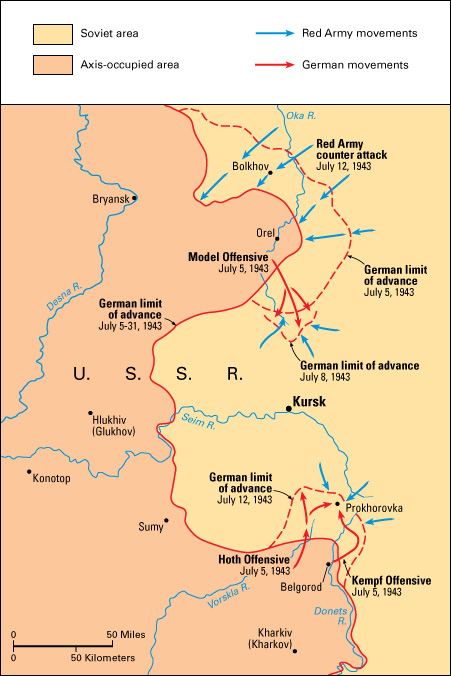
Nevertheless, the German army returned to the offensive in July 1943 near the Soviet city of Kursk. There, they massed an assault against superior Soviet forces. For more than two weeks, over 2 million soldiers slaughtered one another in brutal fighting. On July 12, about 800 tanks clashed at Prokhorovka. After the combined deaths of over 300,000 troops, the Red Army held the ground. Hitler finally called off the attack to deal with the Allied invasion of Sicily.
Soviet troops moved slowly forward during the summer and fall of 1943. In January 1944, a Soviet offensive ended the siege of Leningrad. In June, soon after the Normandy invasion, Stalin’s armies attacked along a 450-mile (720-kilometer) front in the east. By late July, Soviet troops had reached the outskirts of Warsaw. Poland’s Home Army rose up against German forces in Warsaw on August 1. But Soviet troops refused to come to Poland’s aid. Stalin permitted the Germans to destroy the Home Army. It might have resisted his plans to set up a Communist government in Poland after the war. The Warsaw uprising lasted two months. More than 200,000 Poles were killed. Soviet forces entered Warsaw in January 1945.
Meanwhile, Soviet troops drove into Romania and Bulgaria. The Germans pulled out of Greece and Yugoslavia in the fall of 1944. But Germany resisted a siege in Budapest, Hungary’s capital, until February 1945. Vienna, Austria’s capital, fell to Soviet soldiers in April. By then, Soviet troops occupied nearly all of eastern Europe.
Victory in Europe.
The Allies began their final assault on Germany in early 1945. Soviet soldiers reached the Oder River, about 40 miles (65 kilometers) east of Berlin, in January. Allied forces in the west occupied positions along the Rhine by early March. 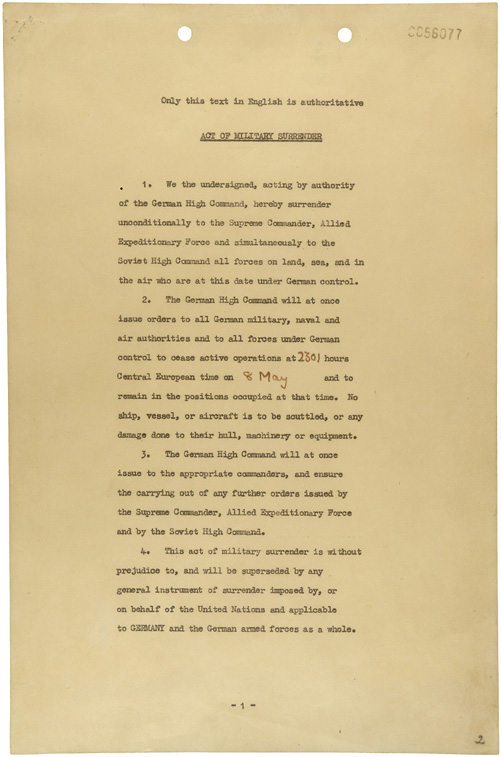
British and Canadian forces cleared the Germans out of the Netherlands and swept into northern Germany. American and French forces raced toward the Elbe River in central Germany. Hitler ordered his soldiers to fight to the death. But large numbers of German soldiers surrendered each day.
As they advanced, the Allies discovered horrifying evidence of Nazi brutality. Hitler had ordered the imprisonment and murder of millions of Jews and members of other minority groups in concentration camps. The starving survivors of the death camps gave proof of the terrible suffering of those who had already died. The full nature and reality of the Holocaust came to light in later months and years.
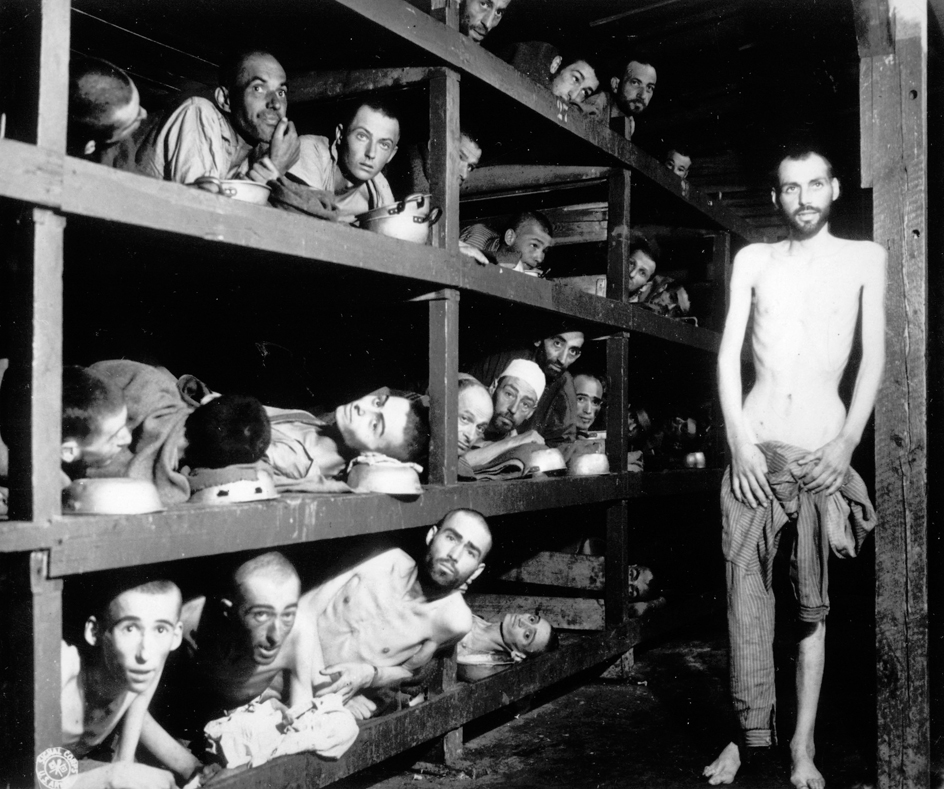
The Allies left the capture of Berlin to Soviet forces. By April 25, 1945, Soviet troops had surrounded the city. From a bunker (shelter) deep underground, Hitler ordered German soldiers to fight on. On April 30, however, Hitler killed himself rather than face defeat. With him died the Third Reich (Third Empire), the Nazi term for the empire in which they hoped to unite all Germanic peoples.
The fighting in Berlin claimed the lives of over 70,000 Soviet soldiers. The Germans propped up their remaining units with children and elderly reservists. Thousands of them died in that last week of fighting.
German Grand Admiral Karl Dönitz briefly succeeded Hitler and arranged for Germany’s surrender. On May 7, 1945, General Alfred Jodl, chief of staff of the German armed forces, signed a statement of unconditional surrender at Eisenhower’s headquarters in Reims, France. World War II had ended in Europe. The Allies declared May 8 as V-E Day, or Victory in Europe Day.
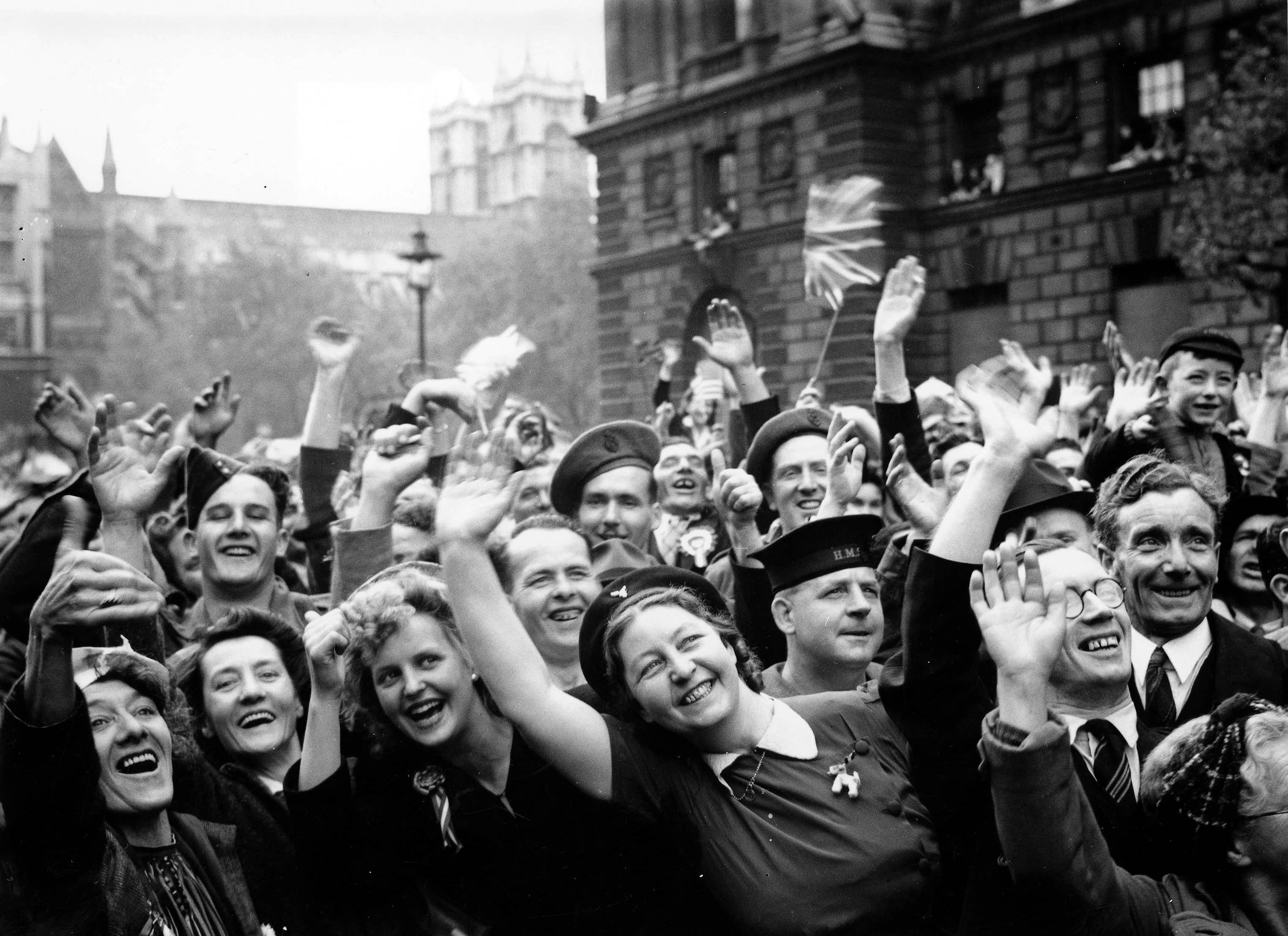
The war in Asia and the Pacific
The attack on Pearl Harbor on Dec. 7, 1941, left the U.S. Pacific Fleet briefly powerless to halt Japan’s expansion. During the next six months, Japanese forces swept across Southeast Asia and the western Pacific Ocean. Japan’s empire reached its greatest size in August 1942. It stretched northeast to the Aleutian Islands of Alaska, west to Burma (now Myanmar), and south to the Netherlands Indies (now Indonesia). The Allies halted Japan’s expansion in the summer of 1942. They hacked away at its empire until Japan surrendered in August 1945.
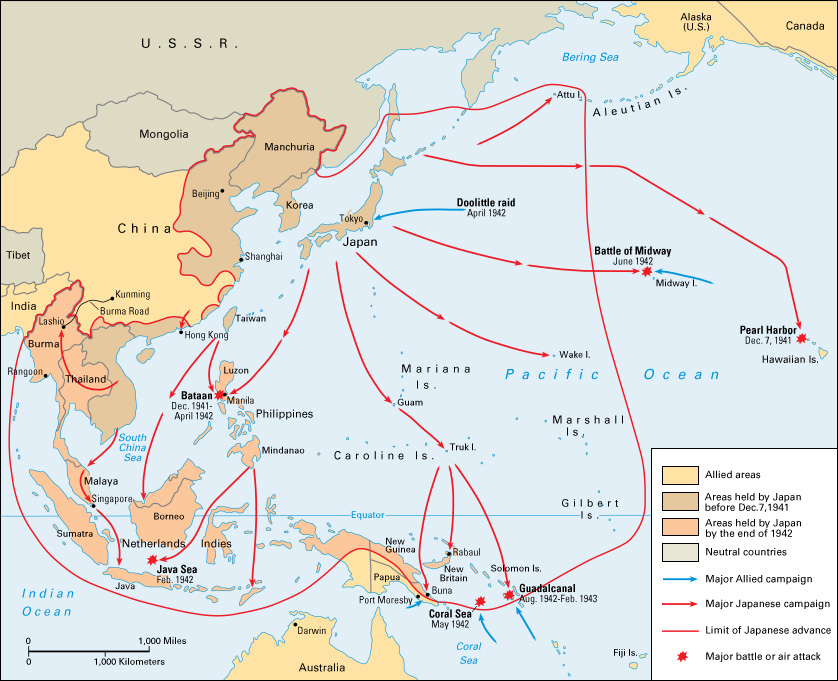
Early Japanese victories.
On Dec. 8, 1941, Japanese bombers struck the British colony of Hong Kong on the south coast of China. They also attacked two U.S. islands in the Pacific Ocean—Guam and Wake. The Japanese invaded Thailand the same day. Thailand surrendered within hours and began cooperating with the Japanese. Japanese troops took Hong Kong, Guam, and Wake Island by the end of the year.
From Thailand, Japanese forces soon advanced into the British-ruled regions of Malaya (now part of Malaysia) and Burma. Thinking the thick jungles of the Malay Peninsula impenetrable, the British Army expected an assault by sea. But Japanese troops streamed through the jungles and rapidly overran the peninsula. 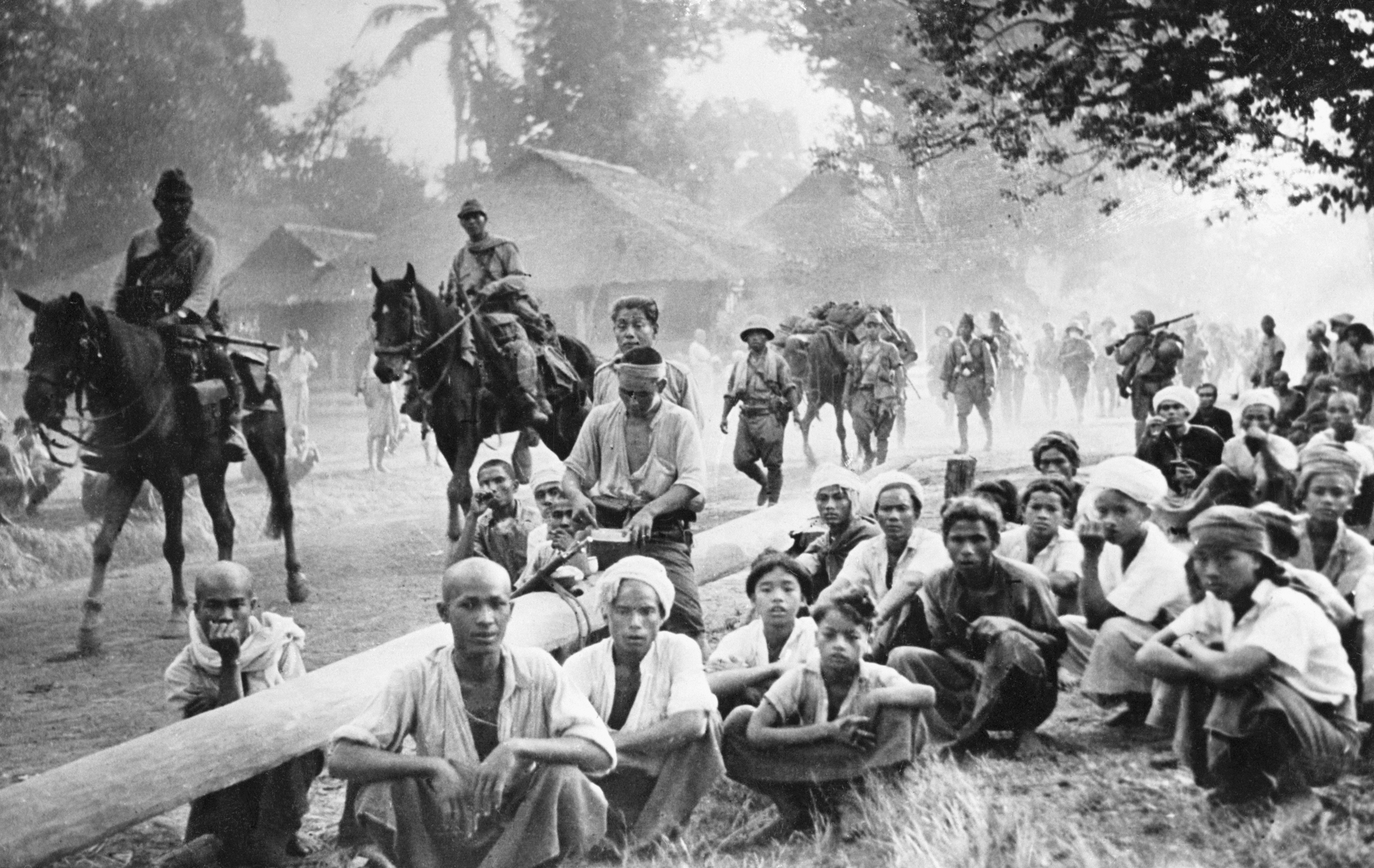
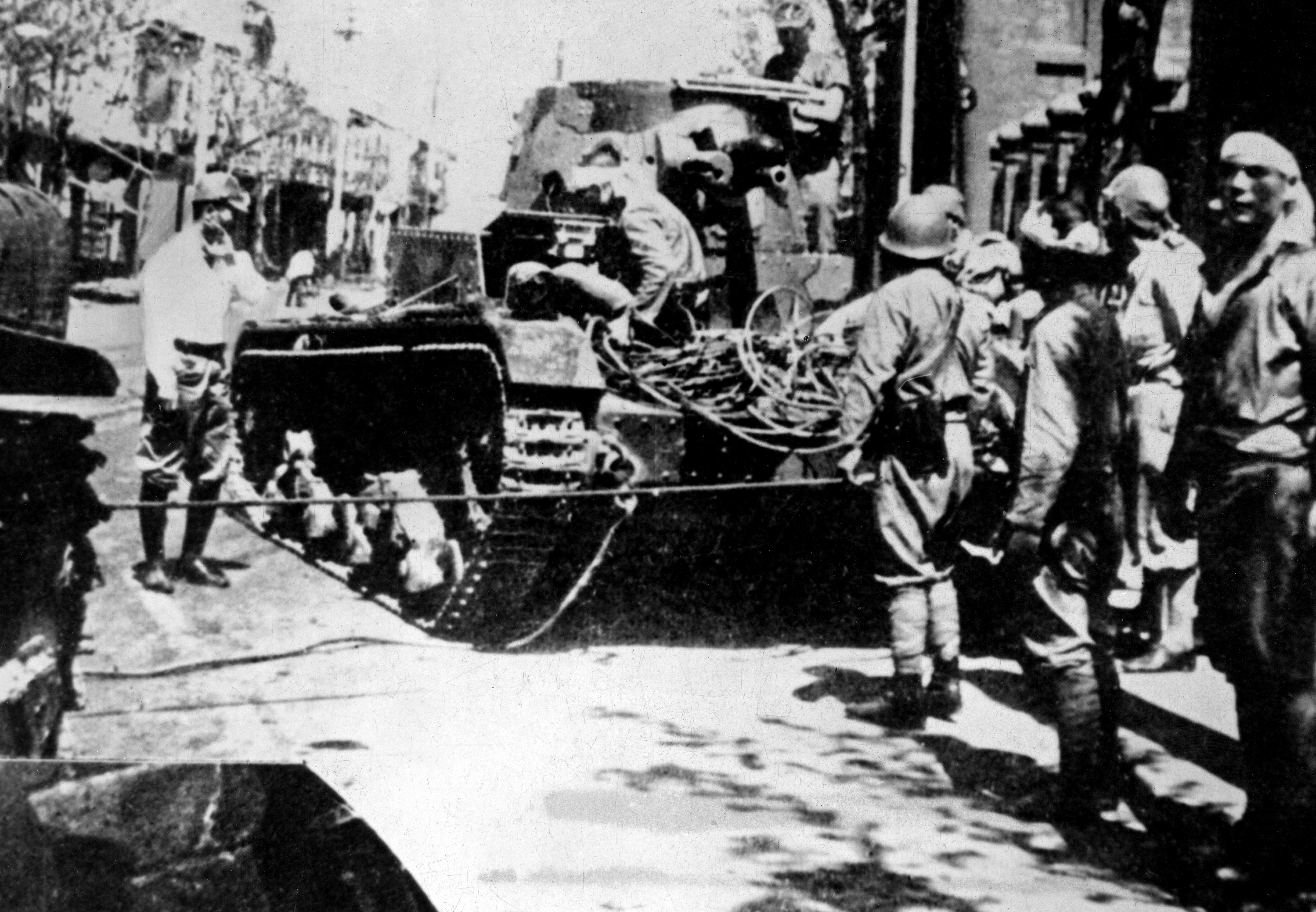
By late January 1942, the Japanese had pushed a large British, Australian, and Indian force back to Singapore. Singapore was a fortified island off the tip of the Malay Peninsula. The Japanese stormed the island on February 8. Singapore surrendered a week later. Japan captured more than 60,000 soldiers. The fall of Singapore ranked as the United Kingdom’s worst military defeat ever. Thousands of Commonwealth troops were killed in the Malayan Campaign. The Japanese lost about 3,500 troops. 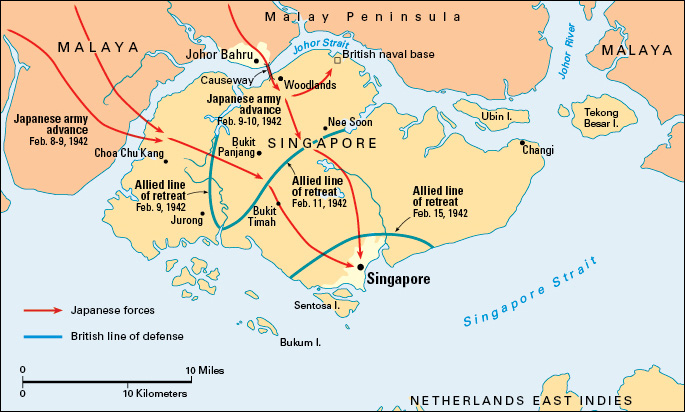
Japan’s next target was the petroleum-rich Netherlands Indies, south of Malaya. A combined Allied naval force protected those islands. On Feb. 27, 1942, Japan sank five Allied ships. More than 2,000 Allied sailors died in the lopsided Battle of the Java Sea. The Imperial Japanese Navy suffered little damage. The Netherlands Indies fell in early March.
Meanwhile, Japanese forces had advanced into southern Burma. China sent troops into Burma to help the United Kingdom hold the Burma Road. Weapons, food, and other goods traveled over that supply route from India to China. In April 1942, Japan seized and shut down the Burma Road. The Japanese had driven Allied forces from most of Burma by mid-May. The United Kingdom’s Burma Corps lost 1,500 troops. The Japanese lost 2,000. Chinese units suffered many deaths as well.
Japan began landing troops in the Philippines on Dec. 8, 1941. American and Philippine forces commanded by U.S. General Douglas MacArthur defended the islands. In late December, MacArthur’s forces abandoned Manila, the capital of the Philippines. MacArthur withdrew to nearby Bataan Peninsula. Although suffering from malnutrition and disease, American and Filipino troops beat back Japanese attacks for over three months. 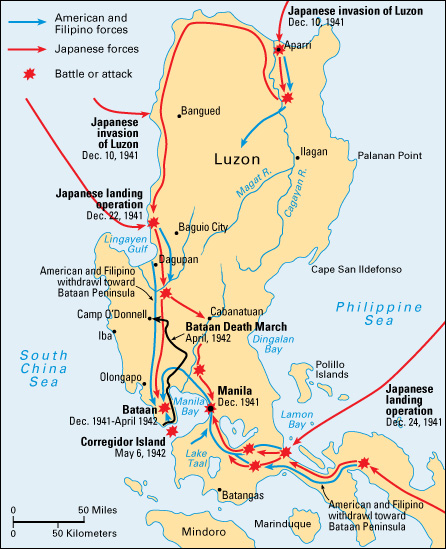
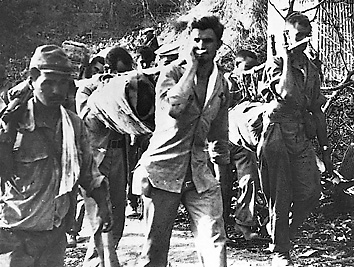
President Roosevelt ordered MacArthur to Australia. He left the Philippines in March 1942. He famously promised the Filipinos, “I shall return.” On April 9, over 75,000 exhausted American and Filipino troops on Bataan surrendered to the Japanese. Thousands of them died of disease and mistreatment on a 65-mile (105-kilometer) forced march to prison camps, known as the Bataan Death March. Some soldiers held out on Corregidor Island, near Bataan, until May 6. Thousands of American and Filipino soldiers were killed in action. The Japanese suffered over 2,500 killed.
Japan’s string of quick victories astonished even the Japanese. The fall of the Netherlands Indies left Australia unprotected. The capture of Burma brought the Japanese to India’s border. Australia and India feared invasion. Japanese planes bombed Darwin on Australia’s north coast in February 1942.
The tide turns.
Three events in 1942 helped turn the tide against Japan. They were the Doolittle raid, the Battle of the Coral Sea, and the Battle of Midway.
The Doolittle raid.
To prove it could be done, the United States staged a daring bombing raid on the Japanese homeland. On April 18, 1942, Lieutenant Colonel James H. Doolittle led 16 B-25 Mitchell bombers in a surprise attack on Tokyo and other Japanese cities. The twin-engined bombers took off from the deck of the Hornet, an aircraft carrier more than 600 miles (960 kilometers) east of Japan. The raid did little damage. But it was a huge morale boost for the American military and public alike. It also alarmed Japan’s leaders. They had believed their homeland safe from Allied attack. To prevent future raids, the Japanese determined to capture more islands to the south and the east to extend the country’s defenses.
Although no B-25’s were shot down, all 16 were lost as they ran out of fuel. Out of the 80 crew members, 73 survived. Doolittle was awarded the Medal of Honor.
The Battle of the Coral Sea.
In May 1942, a Japanese invasion force sailed toward Australia’s base at Port Moresby on the south coast of the island of New Guinea, at Australia’s doorstep. American warships, supported by the Royal Australian Navy, met the Japanese force in the Coral Sea, northeast of Australia. The Battle of the Coral Sea, fought from May 4 to 8, was the first naval battle in which opposing ships never sighted one another. Each side attacked the other with carrier-based warplanes. The American aircraft carrier Lexington sank, as did the Japanese carrier Shoho. Around 550 Americans died. The Japanese lost close to 1,100 sailors and aviators. The air-sea battle halted the assault on Port Moresby and temporarily checked the threat to Australia.
The Battle of Midway.
Japan next sent a large fleet to capture Midway Island at the westernmost tip of the Hawaiian Archipelago. The United States had cracked Japan’s naval code. Thus it learned about the coming invasion. Admiral Chester W. Nimitz, commander of the U.S. Pacific Fleet, gathered the ships that had survived the raid on Pearl Harbor and the Battle of the Coral Sea. He prepared to ambush the Japanese. 
The battle opened on June 4, 1942, with a Japanese air strike on Midway Island. The air strike inflicted heavy damage. American bombers responded from the island but damaged no Japanese ships. Three squadrons of U.S. torpedo-bombers—41 aircraft—followed. They flew in low against Japanese warships. But the Japanese shot down 33 of the American planes without a single torpedo striking its target. A wave of 54 American dive bombers followed. They pounded the enemy aircraft carriers while planes refueled and rearmed on deck. The three-day battle was fought entirely by warplanes. The Japanese lost 4 aircraft carriers, about 300 aircraft, and around 3,000 sailors and aviators. The Japanese sank the aircraft carrier USS Yorktown, shot down about 150 U.S. planes, and killed about 300 Americans.
The Battle of Midway was the first clear Allied victory over Japan in World War II. The battle crippled the Japanese navy and stopped Japan’s advances. Aircraft carriers had become the most important weapon in the war in the Pacific.
In an effort to divert American attention from Midway, the Japanese occupied two islands at the tip of Alaska’s Aleutian chain on June 7, 1942. The Americans drove the Japanese out of the Aleutians in the spring and summer of 1943. All but 29 of the 2,500 Japanese on the islands were killed. About 560 Americans died. It was the only fighting on North American soil during World War II.
The South Pacific.
After the Battle of Midway, the Allies were determined to stop Japanese expansion in the South Pacific. In the battles that followed, American soldiers and marines fought many jungle battles on Pacific islands. The jungle itself was an enemy. Heavy rains drenched the troops and turned the jungle into a foul-smelling swamp. The soldiers had to hack their way through tangled, slimy vegetation. They had to wade through knee-deep mud. The Japanese hid everywhere, waiting to shoot unsuspecting Americans. Scorpions and snakes were a constant menace. Malaria and other tropical diseases took a heavy toll.
The Americans also encountered Japan’s strict samurai military code called bushido. The code required Japanese soldiers to fight to the death. Japanese soldiers believed that surrender meant disgrace. The Allies rarely captured them alive. When cornered, the Japanese sometimes charged at Allied troops in nighttime suicide charges. The charges were called banzai attacks because the Japanese shouted the war cry “Banzai” as they attacked. Rather than admit defeat, Japan’s military leaders took their lives by stabbing themselves in the abdomen. That method of suicide was called hara-kiri.
It was dangerous for Allied soldiers to surrender to the Japanese. Because the Japanese disdained surrender, they executed many enemy prisoners of war or otherwise abused them. Of the many thousands of Americans, Australians, and British taken prisoner, one in three did not return.
The Allies developed two major campaigns against Japan in the South Pacific. One force under MacArthur stopped the Japanese on New Guinea. Another force under Nimitz battled the Japanese in the Solomon Islands northeast of Australia. MacArthur and Nimitz aimed at taking the port of Rabaul on New Britain, a large island off the northeast coast of New Guinea. Rabaul was Japan’s chief base in the South Pacific. Japanese aircraft and warships attacked Allied ships from Rabaul. Japan also supplied other islands in the South Pacific from that base.
New Guinea.
In the summer of 1942, Japanese troops began an overland drive across New Guinea’s rugged, jungle-covered mountains to the Australian base of Port Moresby on the south coast. An Allied force made up chiefly of Australians counterattacked. By November, the Allies had pushed the Japanese back across the mountains. MacArthur then attacked Japanese positions along the north coast in a series of combined air, sea, and land operations. By the time fighting ceased in July 1944, the New Guinea Campaign had taken the lives of many thousands of Allied and Japanese personnel.
Guadalcanal.
On Aug. 7, 1942, U.S. marines invaded the island of Guadalcanal in the first stage of a campaign in the Solomon Islands. The Japanese were building an air base on Guadalcanal from which to attack Allied ships. The invasion took the Japanese by surprise. But they fought back. A fierce battle developed. 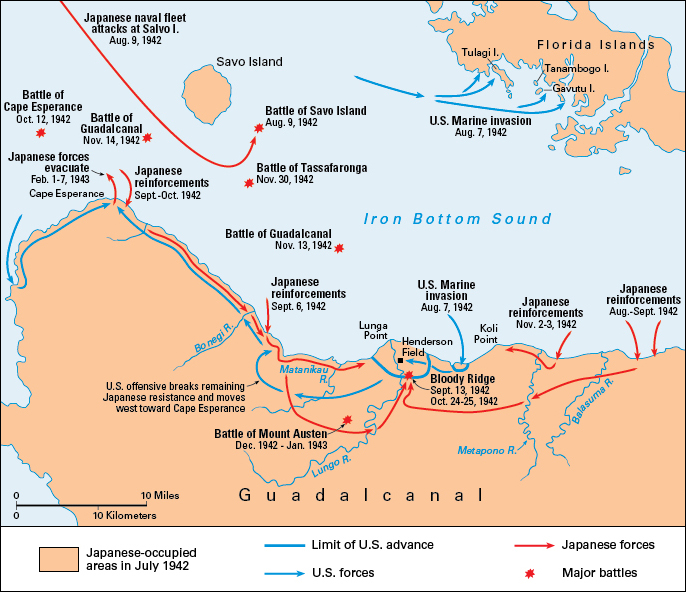
The six-month battle for Guadalcanal was one of the most vicious campaigns of World War II. Each side depended on its navy to land supplies and troop reinforcements. In a series of naval battles, the Allies gained control of the waters surrounding Guadalcanal. They then cut off Japanese shipments. Until that time, Allied supplies had been short. The marines had depended on rice captured from the enemy. By February 1943, the starving Japanese had evacuated Guadalcanal. They lost nearly 15,000 troops in action. The U.S. Army and Marine Corps suffered about 1,500 deaths. In heavy naval action around the island, about 5,000 Allied personnel were killed. Around 4,800 Japanese were lost.
Rabaul.
In the summer of 1943, Allied military leaders canceled the invasion of Rabaul. Instead, American bombers pounded the Japanese base. Aircraft and submarines sank shipments headed for Rabaul. About 100,000 Japanese defenders waited there for an attack that never came. There was one significant casualty out of Rabaul, however. Japanese Admiral Isoroku Yamamoto died when American fighters destroyed his plane on April 18, 1943. Yamamoto was the architect of the attack on Pearl Harbor—and the attack on Midway.
Island hopping in the Central Pacific.
From late 1943 until the fall of 1944, the Allies hopped from island to island across the Central Pacific toward the Philippines. During the island-hopping campaign, the Allies became expert at amphibious invasions. Such invasions were seaborne operations that involve naval, air, and land forces. Each island they captured provided a base from which to strike the next target. But rather than capture every island, the Allies by-passed Japanese strongholds and invaded islands that were weakly held. That strategy, known as leapfrogging, saved time and lives. Leapfrogging carried the Allies across the Gilbert, Marshall, Caroline, and Mariana islands in the Central Pacific.
Admiral Nimitz selected the Gilbert Islands as the first major objective in the island-hopping campaign. American marines invaded Tarawa in the Gilberts in November 1943. The attackers met heavy fire from Japanese troops in concrete shelters. But they inched forward and captured the tiny island after four days of savage fighting. The Japanese lost about 5,000 troops defending the island. Just 17 remained alive when the shooting stopped. The Marines lost close to 1,000 killed in the assault. The Allies improved their amphibious operations because of lessons learned at Tarawa. As a result, fewer soldiers died in later landings. 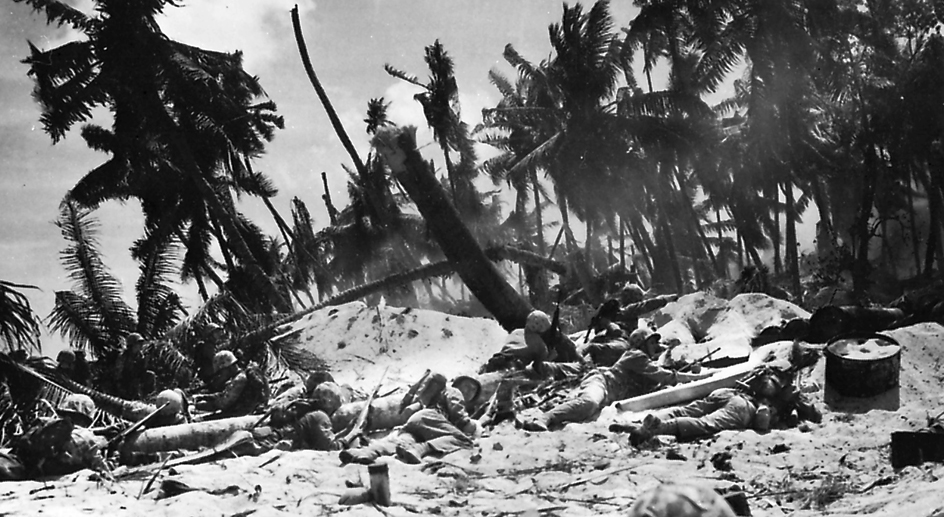
In February 1944, U.S. marines and infantry leaped north to the Marshall Islands. They captured Kwajalein and Enewetak with ease. Only 600 American troops were killed, compared with the Japanese total of 11,000. Allied military leaders meanwhile had decided to by-pass Truk (now Chuuk), a key Japanese naval base in the Caroline Islands west of the Marshalls. American warplanes ravaged Truk, though. They sank 39 Japanese ships and destroyed 275 aircraft at a cost of only 25 American planes.
The Americans made their next jump to the Mariana Islands, about 1,000 miles (1,600 kilometers) northwest of Enewetak. Bitter fighting for the Marianas began in June 1944. The islands of Saipan, Guam, and Tinian fell at a cost of almost 5,000 American dead and 68,000 Japanese. 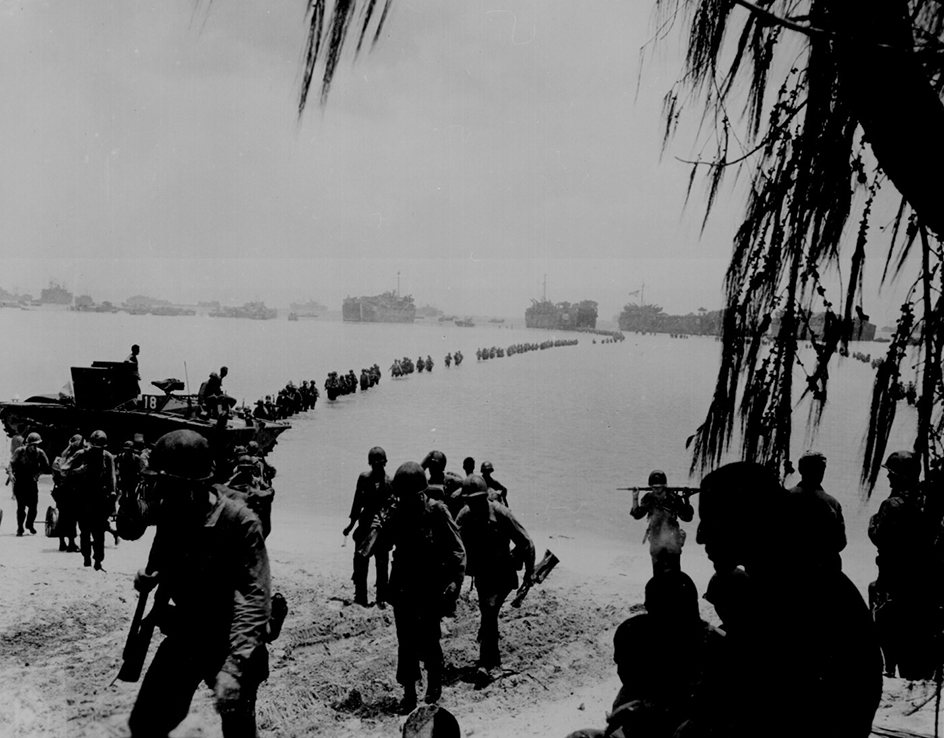
In the Battle of the Philippine Sea on June 19 and 20, Japan’s navy once again attempted to destroy the U.S. Pacific Fleet. Instead, the Americans massacred Japan’s navy and destroyed its air power. Japan lost 3 aircraft carriers, thousands of sailors, and 480 airplanes. More than three-fourths of the planes it sent into battle were destroyed. The United States lost 130 aircraft. Most of them were lost in dangerous nighttime carrier landings. Most of their crews survived. The lopsided air battle became known as the “Great Marianas Turkey Shoot.”
Hideki Tojo resigned as Japan’s prime minister in July 1944 after the loss of Saipan. By November, American B-29 Superfortress bombers were pounding the home islands of Japan from air bases in the Marianas.
A final hop before the invasion of the Philippines took U.S. forces to the Palau Islands in September 1944. The islands lie between the Marianas and the Philippines. Most of the fighting took place on the small island of Peleliu. The Japanese fought fiercely. They lost 13,600 killed and took close to 2,000 Americans with them. The Battle of Peleliu had the highest U.S. casualty rate of any amphibious invasion in the Pacific theater of war.
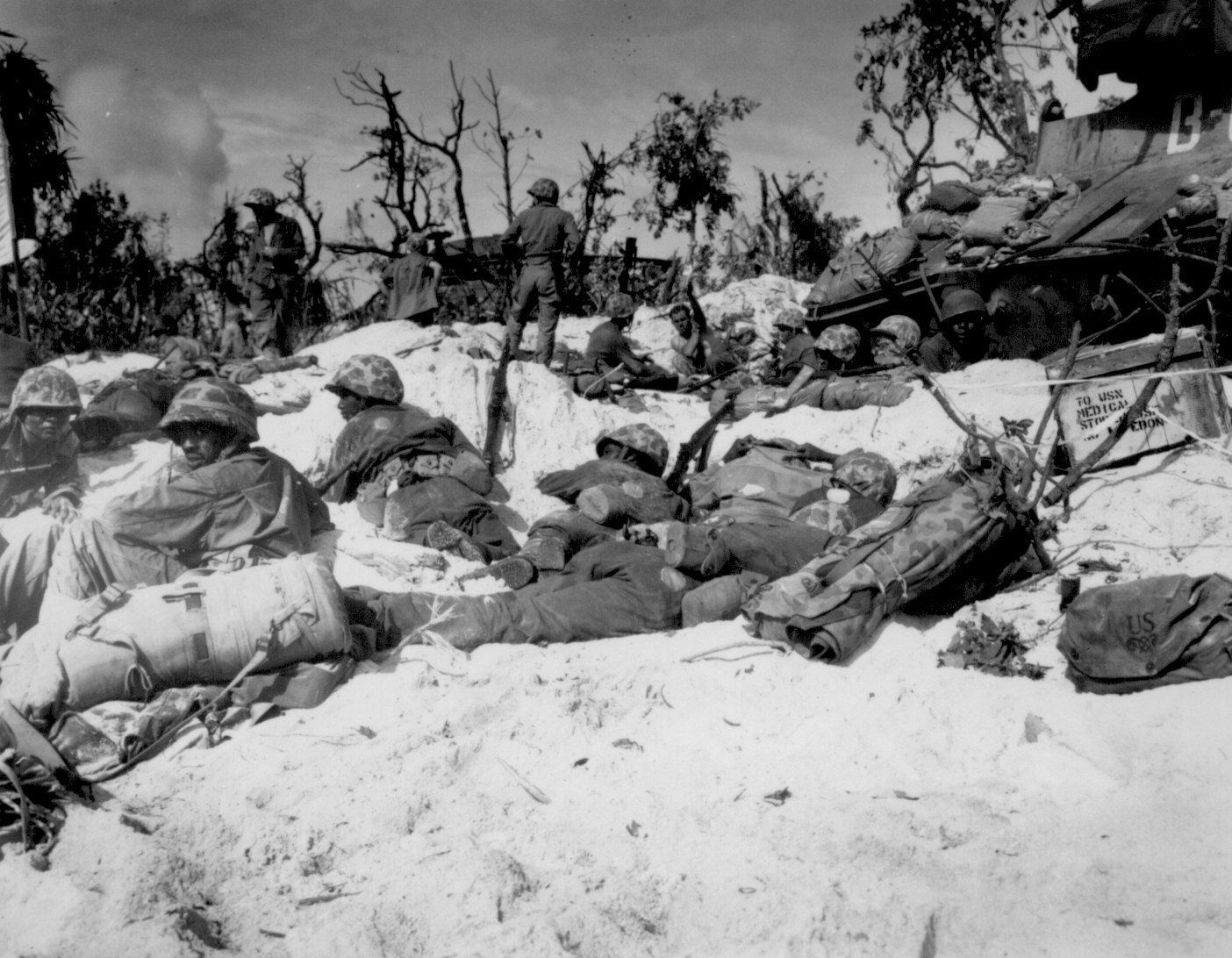
The liberation of the Philippines.
The campaigns in New Guinea and the Central Pacific brought the Allies within striking distance of the Philippine Islands. Expecting stiff Japanese resistance, the Allies assembled a landing force of more than 700 ships. They pointed the landing force at the island of Leyte in the central Philippines. On Oct. 20, 1944, American troops poured ashore. 
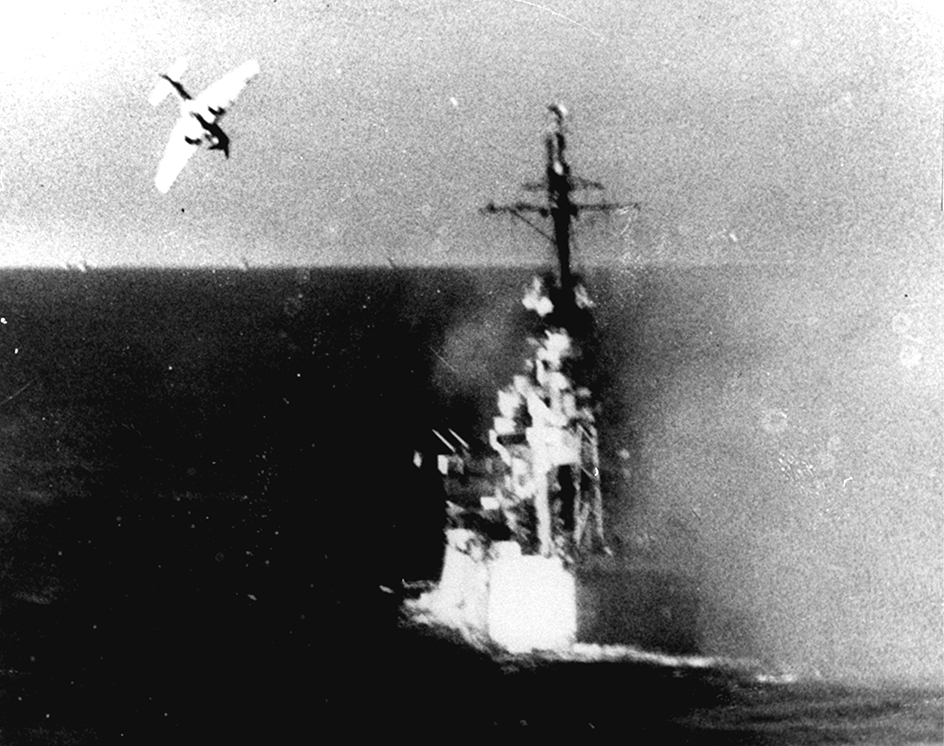
In a desperate attempt to disrupt the invasion, the Imperial Japanese Navy lured U.S. Admiral Bill Halsey’s task force into the Battle of Leyte Gulf. It became the largest naval battle in history. The Japanese sent 64 ships against 216 American and 2 Australian warships. The Americans had 24 aircraft carriers. It was an overwhelming victory for the United States. The defeat left Japan’s navy ravaged. More than 10,000 Japanese sailors and aviators died at Leyte Gulf. Nearly 3,000 Americans were killed or wounded.
During the Battle for Leyte Gulf, the Japanese unleashed a terrifying new weapon—the kamikaze suicide pilot. Kamikaze was Japanese for divine wind. Kamikazes intended to crash their planes filled with explosives into Allied warships. But most were shot down before they reached their targets. The few that got through, however, caused great damage, terror, and loss of life.
The fight for the island of Leyte lasted until the end of 1944. On Jan. 9, 1945, the Allies landed on the island of Luzon. They fought their way to the capital city of Manila, which was almost completely destroyed. Nearly 100,000 Filipino civilians died in the conquest of Manila. In the mountains, the remaining Japanese troops on Luzon—more than 150,000 of them—continued to fight. About 50,000 of the troops remained to surrender at war’s end.
American losses in the Philippines were heavy, with 13,700 killed in action. Japanese losses were catastrophic, with more than 250,000 dead. Japan was doomed to defeat after losing the Philippines. But it did not intend to surrender.
The China-Burma-India theater.
While fighting raged in the Pacific, the Allies also battled the Japanese on the Asian mainland. By mid-1942, Japan held much of eastern and southern China. It had also conquered nearly all Burma. The Japanese had closed the Burma Road, the overland supply route from India to China. China lacked equipment and trained troops. But the Allies wanted to keep China in the war because the Chinese tied down hundreds of thousands of Japanese troops. For three years, the Allies flew war supplies over the world’s tallest mountain system, the Himalaya, from India to China. The route was known as “the Hump.”
China.
By 1942, five years after Japan had invaded China, the opposing armies neared exhaustion. Japanese troops staged attacks to capture China’s food supplies for themselves and to starve the country into surrender. As a result, millions of Chinese people died from lack of food. The fighting in China left nearly half a million Japanese soldiers dead. It also killed 1 1/3 million Chinese soldiers and millions more civilians.
A struggle between China’s Nationalist government, headed by Chiang Kai-shek, and Chinese Communists weakened the country’s war effort. At first, the Nationalist forces and the Communists had joined in fighting the Japanese invaders. But their cooperation broke down as they prepared for a brutal civil war.
The American Volunteer Group—better known as the Flying Tigers—served in China. They were led by Colonel Claire L. Chennault. His three squadrons of fighter pilots gunned down 300 Japanese planes. By the end of 1943, they controlled the skies over China. Major General Joseph W. Stilwell trained the Chinese army and commanded the U.S. forces in China and Burma. 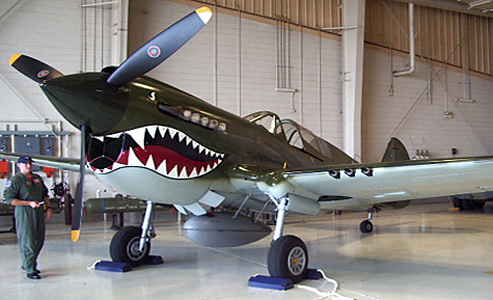
Burma.
The Allied campaign in Burma was linked to the fighting in China. From 1943 until early 1945, the Allies fought to recapture Burma from the Japanese and reopen the Burma Road. Rugged jungle, heavy rains, and a shortage of troops and supplies hampered Allied efforts.
Admiral Louis Mountbatten of the United Kingdom became supreme Allied commander in Southeast Asia in August 1943. He directed several successful offensives in Burma in late 1943 and in 1944. By January 1945, Allied forces had battled their way through the jungles of northern Burma and opened a supply route. Yangon (also spelled Rangoon), Burma’s capital, fell to the Allies in May. British Empire and Commonwealth troops took the brunt of the casualties there. They lost 15,000 troops in combat. American battle deaths in Burma topped 3,000. Japan lost well over 100,000 killed in action. At least 140,000 civilians also died.
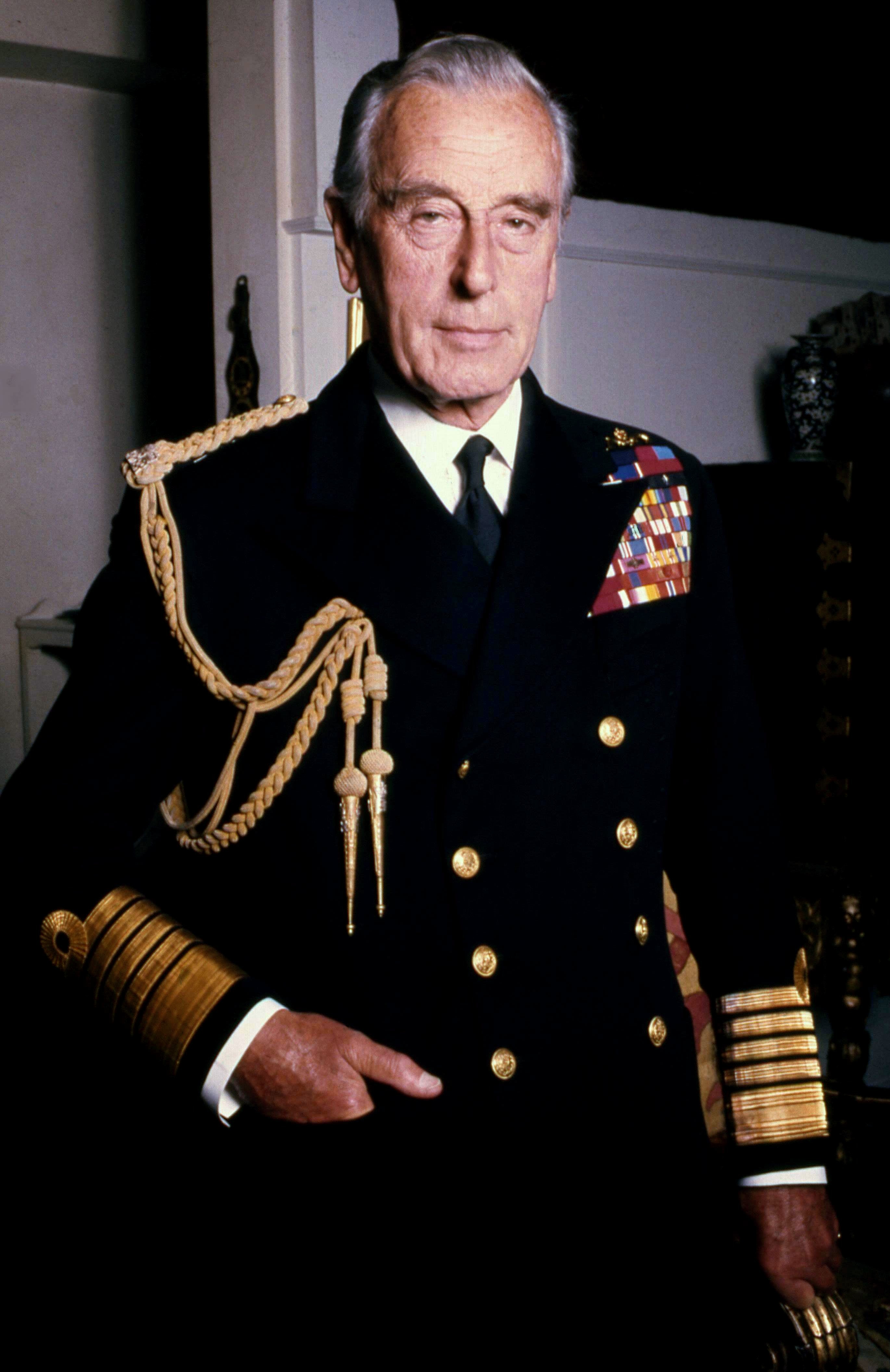
India
became an important supply base and training center for Allied forces during World War II. Japan’s conquest of Burma in 1942 placed India in danger. In early 1944, Japanese troops invaded India. They encircled the towns of Imphal and Kohima just inside India’s border. The British supplied the towns by air. By June, the Japanese offensive ground to a halt. Japan began pulling out of India. On all fronts, about 36,000 Indian troops died during World War II. An additional 2,600 died in the Indian National Army. The Indian National Army was a military force formed by Indian nationalists to seek Independence from the United Kingdom. The Indian National Army fought alongside the Japanese. Tens of thousands of Japanese soldiers were lost to combat and disease in India. Hundreds of thousands of Indian civilians died of starvation during the war.
Closing in on Japan.
Superiority at sea and in the air enabled the Allies to close in on Japan in early 1945. By then, Japan had lost much of its empire. It had also lost most of its aircraft and cargo ships, and nearly all its warships. Hundreds of thousands of Japanese soldiers remained stranded on Pacific islands by-passed by the Allies. American B-29 Superfortress bombers were pounding Japan’s industries. American submarines were sinking vital supplies headed for Japan. 
In January 1945, Major General Curtis E. LeMay took command of the air war against Japan. He ordered more frequent, more daring, and more devastating raids. American bombers began to drop incendiary (fire-producing) bombs that set Japanese cities aflame. A massive incendiary raid in March 1945 destroyed the heart of Tokyo. In all, over 300,000 Japanese civilians were killed in American bombing raids.
Japan’s military leaders went on fighting, though they faced certain defeat. The Allies decided they needed more bases to step up the bombing against Japan. They chose the Japanese islands of Iwo Jima and Okinawa.
Iwo Jima.
About 750 miles (1,207 kilometers) south of Japan is a small, volcanic island then called Iwo Jima—Japanese for “Sulfur Island.” The island covers only 8 square miles (21 square kilometers). It is now called Iwo To. In 1945, it was defended by 21,000 Japanese troops prepared to fight to the death. They fought from fortified caves and underground tunnels. In preparation for the invasion, American B-24 Liberator bombers rocked Iwo Jima 74 days in a row. On Feb. 19, 1945, U.S. marines hit the island’s black sand beaches. The Japanese fought desperately from camouflaged pits, from caves, from trees, and from concrete bunkers. 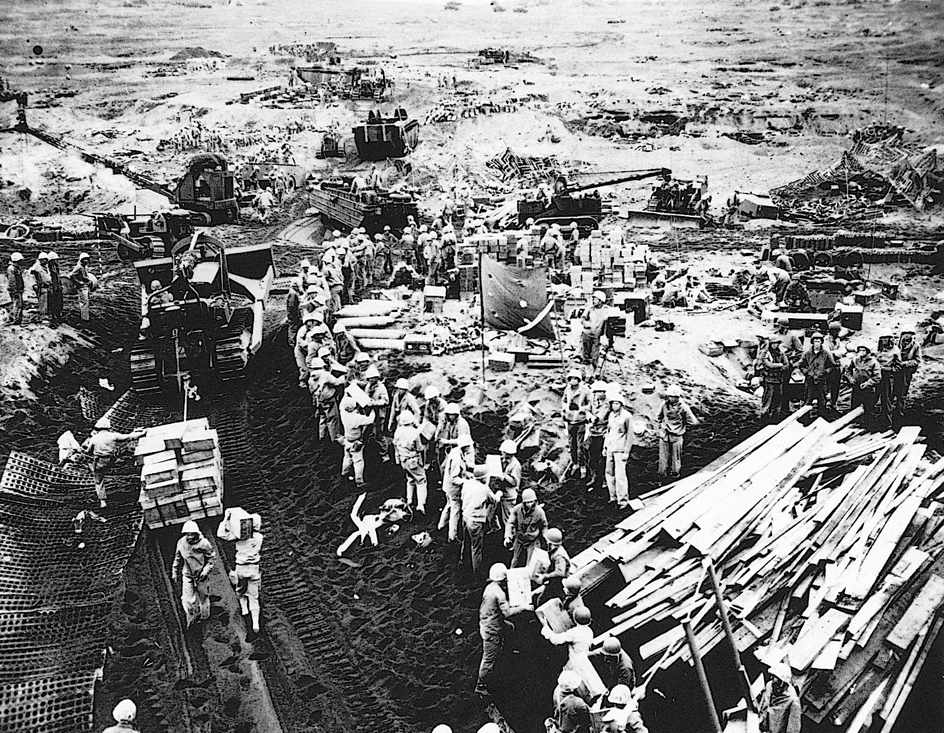
The famous flag-raising on Mount Suribachi occurred on February 23. But fighting dragged on into April. It was the bloodiest battle in U.S. Marine Corps history. Nearly 7,000 marines were killed in action on Iwo Jima. As for the Japanese defenders, 212 surrendered. But more than 20,000 did not. The fighting was savage. For their part in the battle, 22 marines and 5 sailors were awarded the Medal of Honor. The island proved worth taking because 2,250 B-29 Superfortress bombers made emergency landings there in the following months. Each bomber had 11 crew members on board.
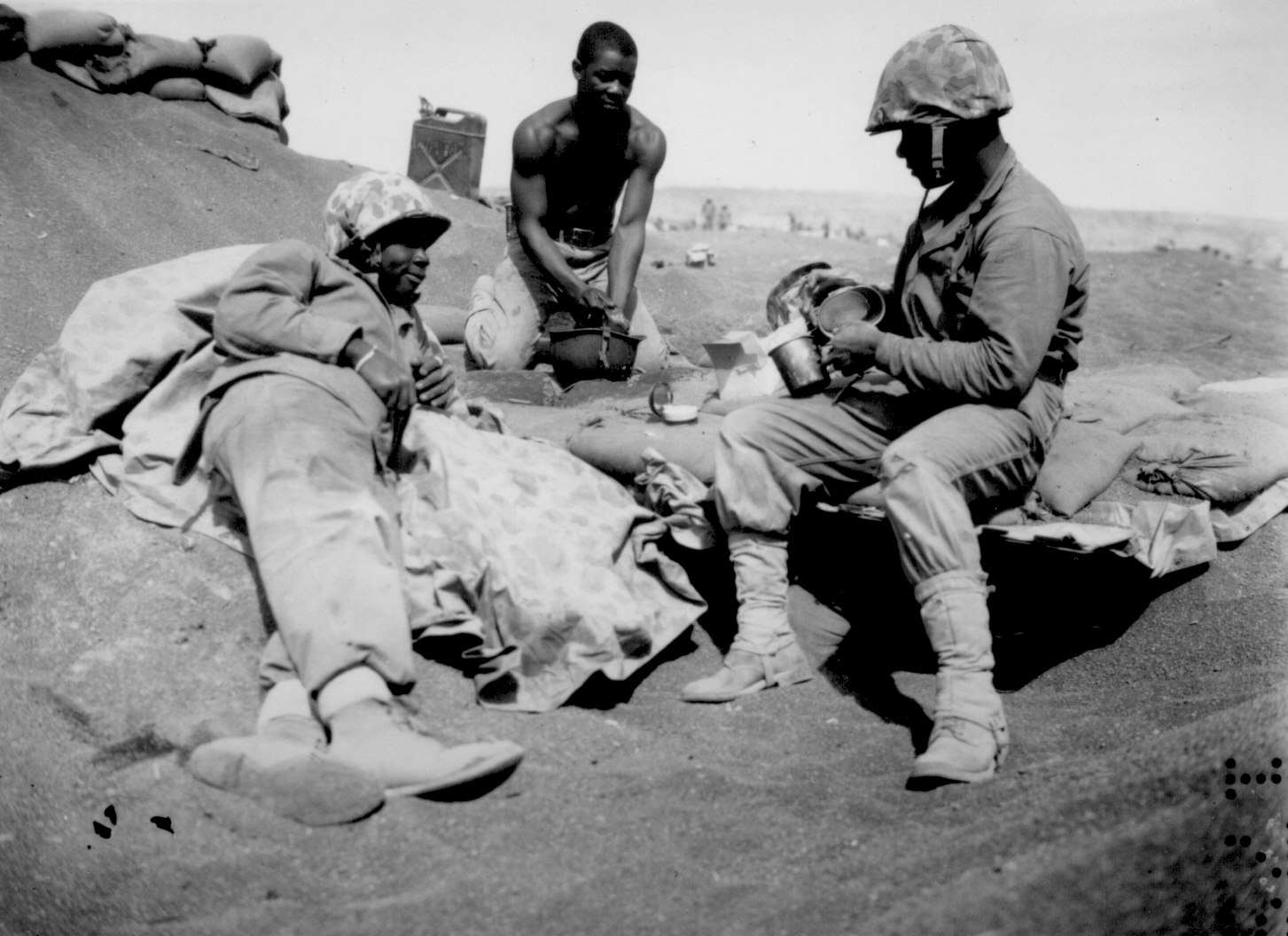
Operation Iceberg.
Okinawa is an island just 350 miles (563 kilometers) from Kyushu, the southernmost of Japan’s home islands. On April 1, 1945, American troops poured ashore. Three months of brutal combat followed. The two sides fought on Okinawa’s steep hills and in its deep ravines. At sea, Japan sent wave after wave of kamikazes at the American Navy. Japan attacked with what remained of the Japanese fleet as well. By the time the battle ended on June 21, 36 U.S. ships had been sunk and 368 damaged. It was the costliest battle in U.S. Navy history. The Japanese navy lost 16 ships and 7,830 aircraft, many of which were kamikazes. The battle took the lives of 110,000 Japanese and Okinawan military personnel. The American death toll was the heaviest of any battle in the Pacific—12,500 soldiers, sailors, and aviators killed. The famous American war correspondent Ernie Pyle was killed there too on April 18. About 80,000 Okinawan civilians died. Many chose to kill themselves rather than be conquered. 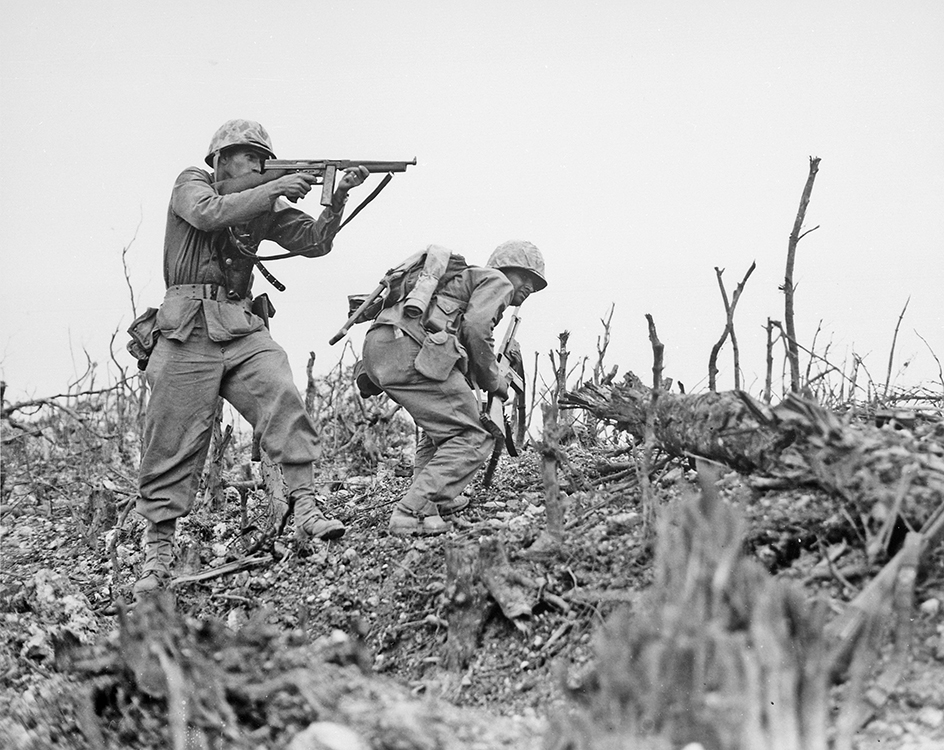
By the summer of 1945, some members of Japan’s government favored surrender. Others insisted that Japan fight on. Meanwhile, Okinawa had taught the Allies a grim lesson. While planning the invasion of Japan for November 1945, they estimated it might cost 1 million American lives. Some Allied leaders believed that Soviet help was needed to defeat Japan. They had encouraged Stalin to invade Manchuria. However, the Allies found another way to end the war. 
The atomic bomb.
In 1939, the German-born scientist Albert Einstein had informed President Roosevelt about the possibility of creating a superbomb. It would produce a powerful explosion by splitting the atom. Einstein and other scientists feared that Germany might develop such a bomb first. In 1942, the United States set up the Manhattan Project. The project was a top-secret program to develop an atomic bomb. The United States exploded the first bomb in a test blast in the New Mexico desert in July 1945. 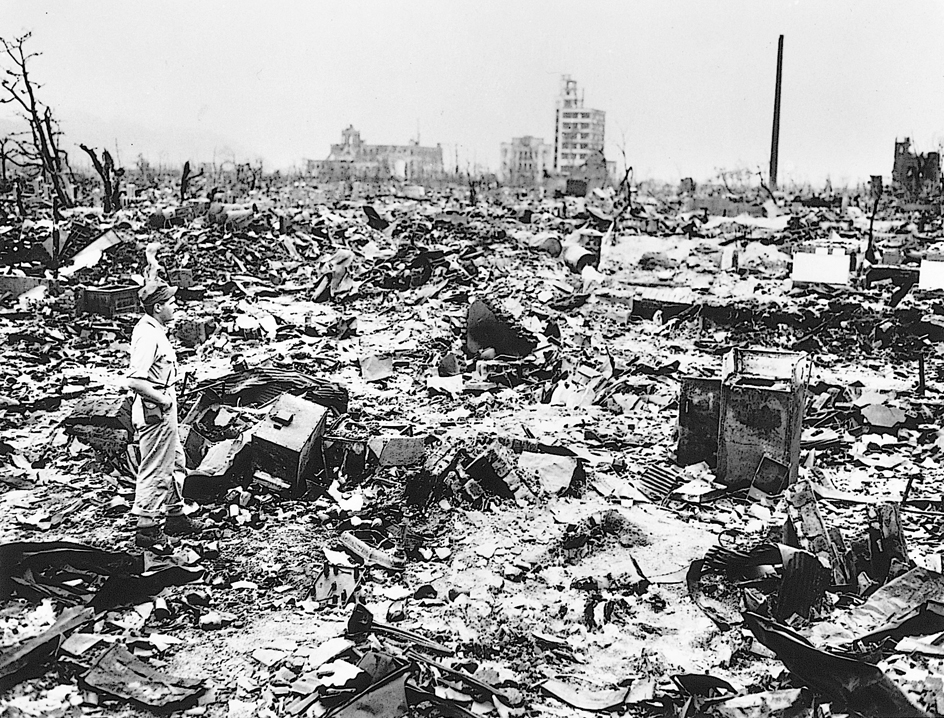
Eyewitness account of the bombing of Nagasaki
Roosevelt died in April 1945. Vice President Harry S. Truman became president of the United States. Truman met with Churchill and Stalin in Potsdam, Germany, in July, shortly after Germany’s defeat. At the Potsdam Conference, Truman learned of the successful test explosion of the atomic bomb. He informed the other leaders of it. The United States, the United Kingdom, and China then issued a statement threatening to destroy Japan unless it surrendered unconditionally. In spite of the warning, Japan went on fighting.
On Aug. 6, 1945, an American B-29 bomber called the Enola Gay dropped the first atomic bomb used in warfare on the Japanese city of Hiroshima. The explosion killed from 70,000 to 140,000 people. It destroyed about 5 square miles (13 square kilometers) of the city. After Japanese leaders failed to respond to the bombing, the United States dropped another bomb on Nagasaki on August 9. It killed about 40,000 people. Later, thousands more died of injuries and radiation from the two bombings. Meanwhile, on August 8, the Soviet Union declared war on Japan and invaded Manchuria.
Victory in the Pacific.
Although Japan’s emperors had traditionally stayed out of politics, Hirohito urged the government to surrender. On August 14, Japan agreed to unconditional surrender. 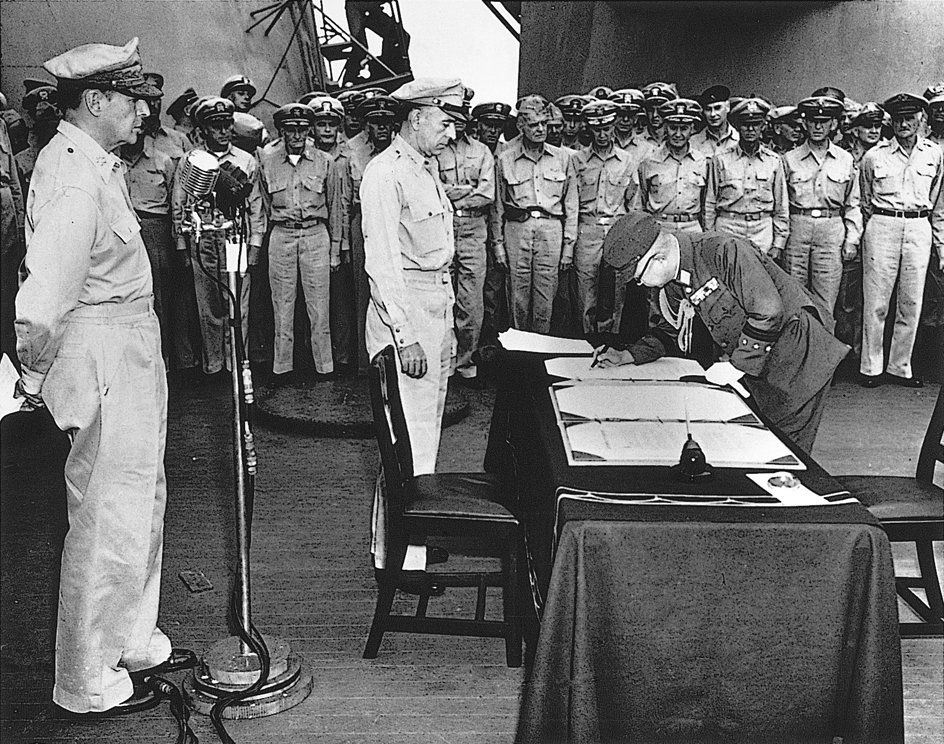
On Sept. 2, 1945, representatives of Japan signed the official statement of surrender aboard the U.S. battleship Missouri. The ship lay at anchor in Tokyo Bay. Representatives of all the Allied nations were present. Truman declared September 2 as V-J Day, or Victory over Japan Day. World War II had ended.
The secret war
Throughout World War II, a secret war was fought between the Allies and the Axis. The goals of the secret war were to obtain information about each other’s activities and to weaken each other’s war effort. Codebreakers tried to figure out secret communications. Spies worked behind enemy lines to gather information. Saboteurs tried to disrupt activities on the home front. Many people in Axis-held territories joined undercover resistance groups that opposed the occupying forces. All the warring nations used propaganda to influence public opinion.
The Ultra secret.
Soon after the outbreak of World War II, the United Kingdom obtained, with the help of Polish spies, an Enigma machine. Germany used Enigma to code secret messages. British mathematicians and codebreakers solved the machine’s electronic coding procedures. The ability to read many of Germany’s wartime communications was known as the Ultra secret. Ultra helped the Allies defeat Germany. During the 1940 Battle of Britain, Ultra supplied warning of where and when the Luftwaffe planned to attack. Ultra also helped Montgomery defeat the Germans in Egypt in 1942 by providing him with Rommel’s battle plan. See also Codes and ciphers (Cipher machines) . 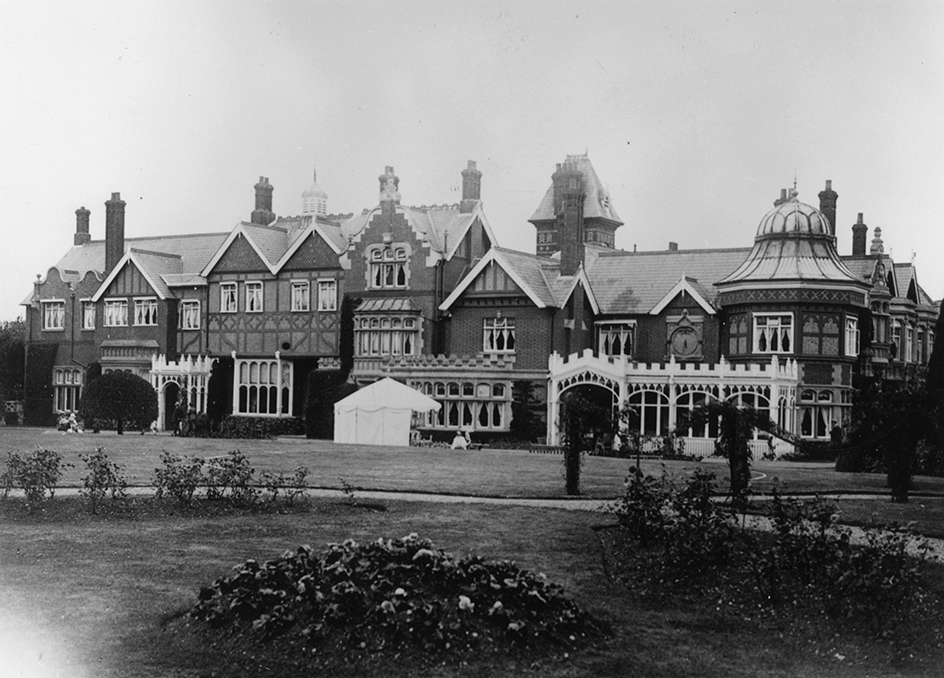
The British carefully guarded the Ultra secret. They were cautious about using their knowledge so that Germany would not change its coding procedures. The Germans never discovered that the United Kingdom had broken their code.
Spying and sabotage.
The warring nations trained spies and saboteurs. Spies reported on troop movements, defense build-ups, and other developments behind enemy lines. Spies of Allied nations also supplied resistance groups with weapons and explosives. Saboteurs hampered the enemy’s war effort by blowing up factories and bridges and organizing slowdowns in war plants.
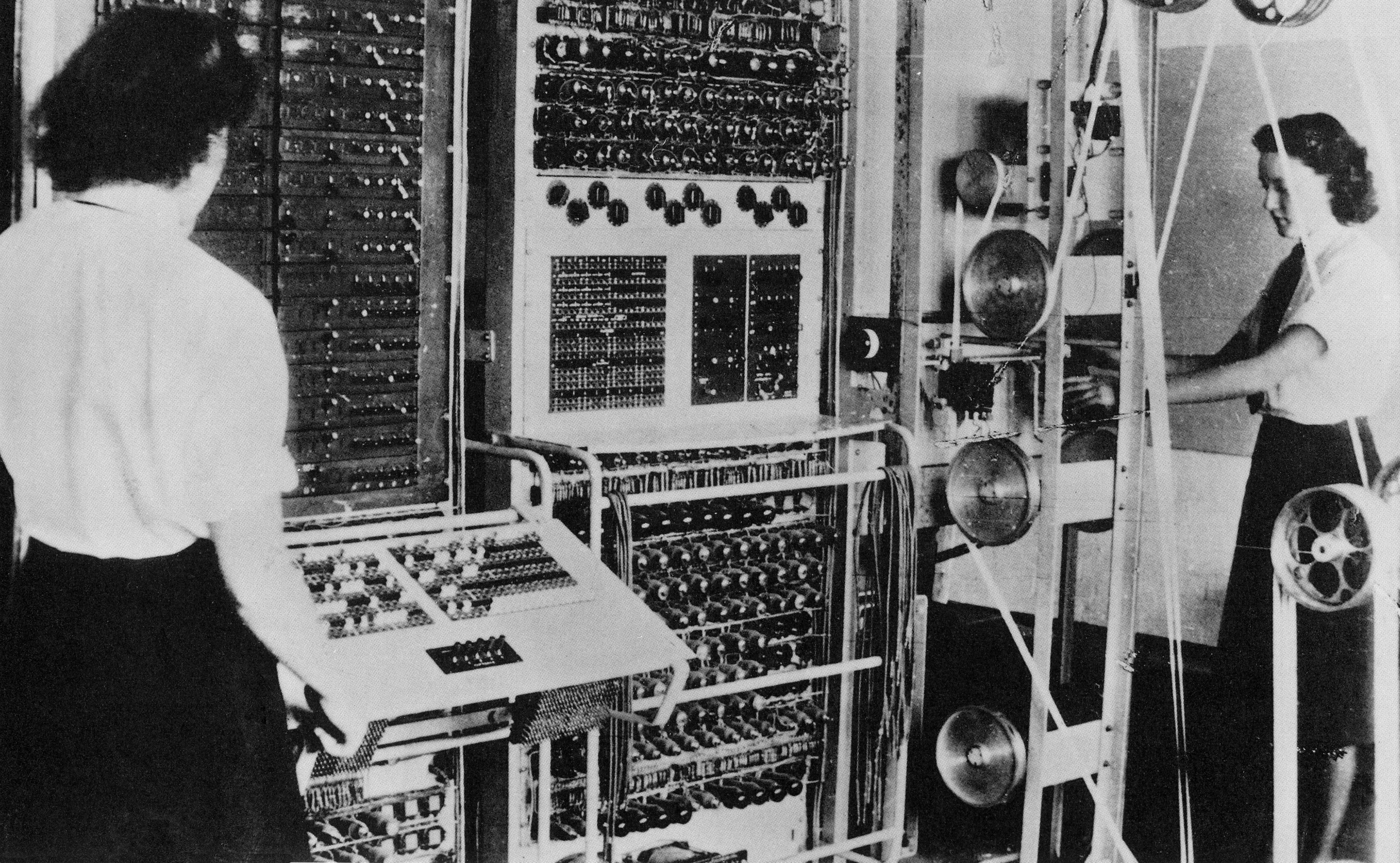
Germany had spies in many countries. But its efforts at spying were less successful than those of the Allies. The U.S. government set up a wartime agency called the Office of Strategic Services (OSS) to engage in spying and sabotage. The OSS worked closely with a similar British agency, the Special Operations Executive. The Soviet Union operated networks of spies in Allied nations as well as in Germany and Japan.
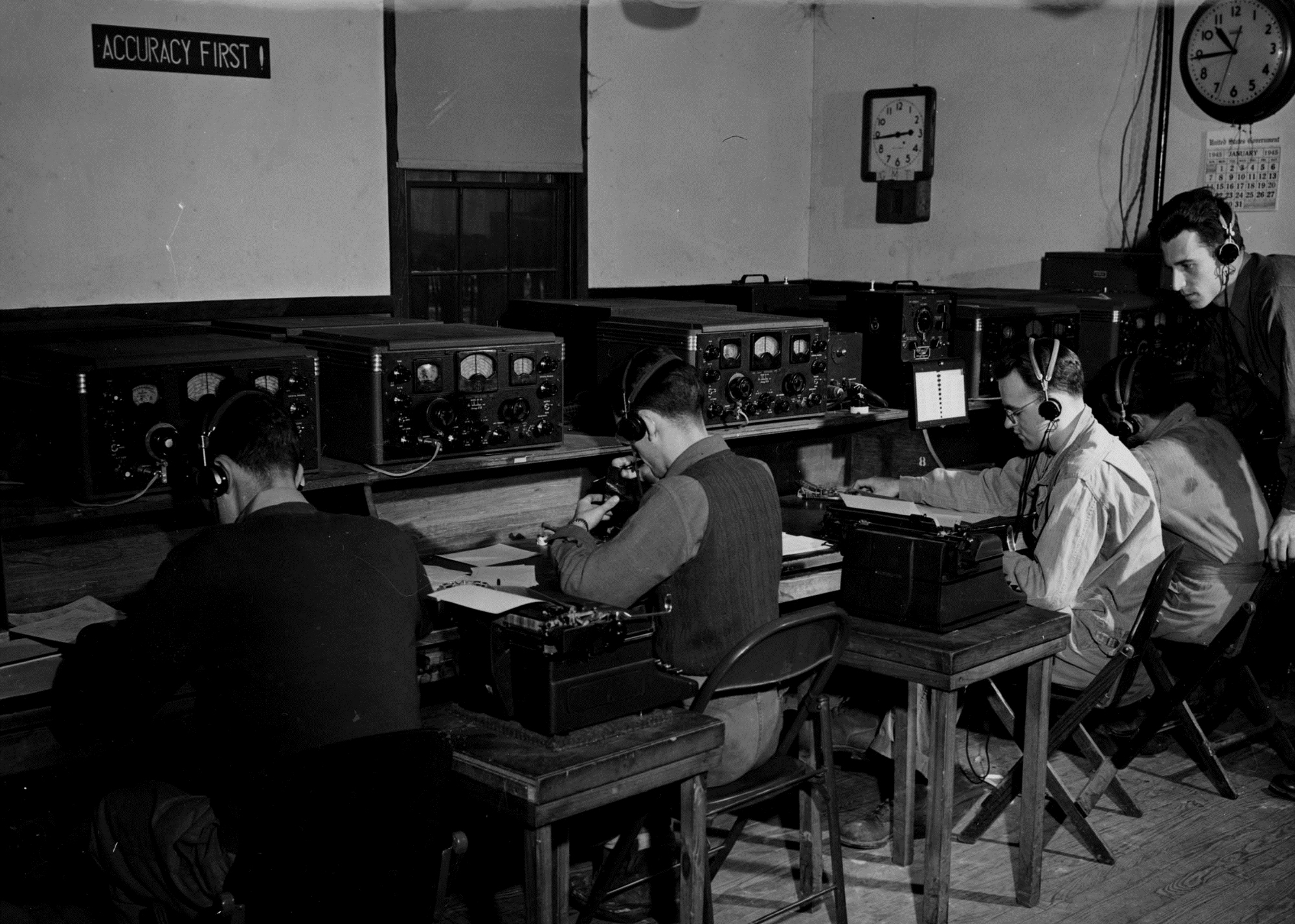
Resistance groups
sprang up in every Axis-occupied country. Resistance began with individual acts of defiance against the occupiers. Gradually, like-minded people banded together and worked in secret to oppose the Axis. Resistance groups expanded their activities as the war continued. The resistance published and distributed illegal newspapers. Resistance workers rescued Allied aircrews shot down behind enemy lines. The resistance also gathered information about the enemy and sabotaged military installations.
In such countries as France, Yugoslavia, and Burma, resistance groups organized bands of fighters. Resistance fighters staged raids, ambushes, and guerrilla attacks against the occupation forces. The French resistance interfered with German efforts to repel the Allied invasion of Normandy in 1944. Norwegian resistance workers destroyed a German-bound shipment of heavy water, a substance needed to make atomic weapons. Yugoslavia had the most effective resistance movement of all—the Partisans. With Allied help, the Partisans drove the Germans out of Yugoslavia in 1944.
In Germany, a small underground movement opposed the Nazis. In July 1944, a group of German army officers planted a bomb intended to kill Hitler. However, Hitler escaped the explosion with minor injuries. The plotters were arrested and executed.
Resistance workers caught by the Nazis faced certain death. German soldiers rounded up and executed hundreds of civilians as reprisals (punishment) for acts of rebellion against the Nazi occupiers.
Propaganda.
All the warring nations used propaganda to win support for their policies. Governments aimed propaganda at their own people and at the enemy. Radio broadcasts reached the largest audiences. Motion pictures, posters, and cartoons were also used. 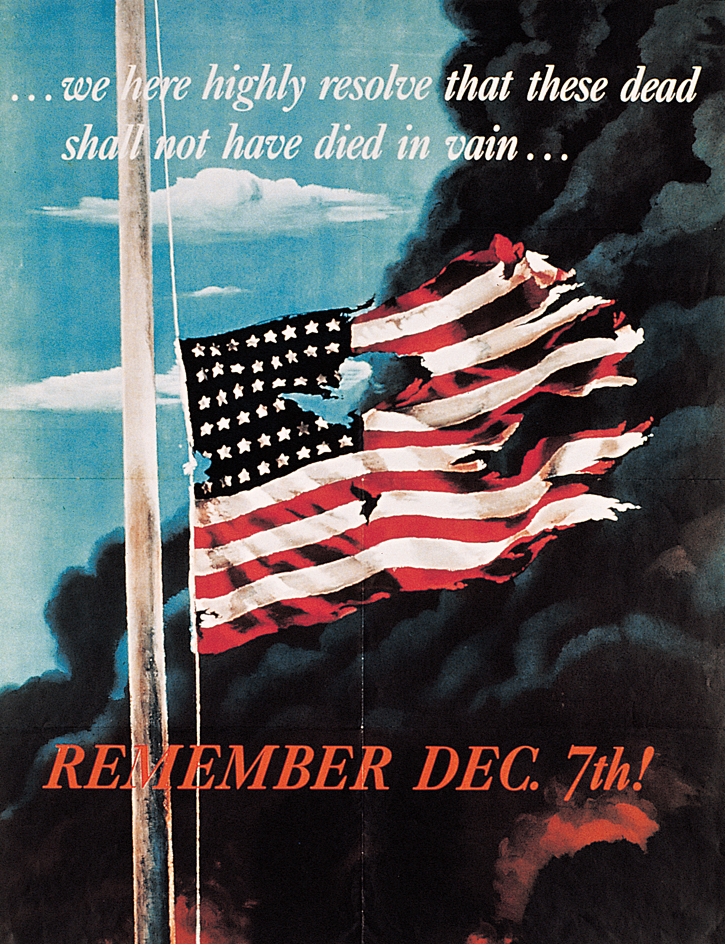
The Nazis were masters of propaganda. Joseph Goebbels directed Germany’s Ministry of Propaganda and Enlightenment. It controlled publications, radio programs, motion pictures, and the arts in Germany and German-occupied Europe. The ministry worked to convince people of the superiority of German culture and of Germany’s right to rule the world. As the war turned in favor of the Allies, the Germans claimed to be saving the world from the evils of Communism.
Mussolini stirred the Italians with dreams of restoring Italy to the glory of ancient Rome. Japan promised conquered peoples a share in the Greater East Asia Co-Prosperity Sphere. That plan would unite all eastern Asia under Japanese control. The Japanese claimed that they were freeing Asia from European rule.
British Broadcasting Corporation (BBC) newscasts provided truthful information about the day’s fighting to the European mainland. The Nazis made it a crime for people in Germany and German-held lands to listen to BBC broadcasts. The U.S. government established the Office of War Information to encourage American support for the war effort. In 1942, the Voice of America, a government radio service, began broadcasting to Axis-occupied countries.
The warring countries also engaged in psychological warfare. It was intended to destroy the enemy’s will to fight. American planes dropped leaflets over Germany that told of Nazi defeats. The Axis nations employed English-speaking radio announcers to weaken the morale of Allied soldiers. Mildred Gillars, an American known as “Axis Sally,” made broadcasts for Germany. The Japanese also used English-speaking female announcers. Some of them were referred to as “Tokyo Rose” by soldiers.
On the home front
World War II affected the civilian populations of all the fighting nations. But the effects were uneven. Much of Europe and large parts of Asia suffered widespread destruction and hardship. The United States and Canada, far from the battlefronts, were spared most of the horror of war. North America, in fact, prospered during World War II. The war effort attracted widespread support.
Producing for the war.
World War II required enormous amounts of ships, tanks, aircraft, and weapons. The United States and Canada built new plants to manufacture war goods. They also renovated automobile and other factories to do the same. 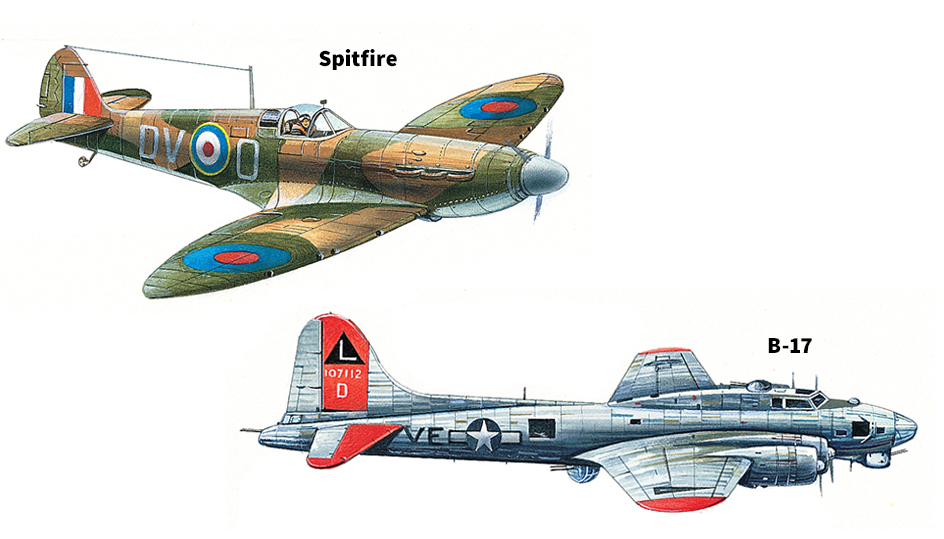
The United States astonished the world with its wartime output. Roosevelt called for the production of 60,000 aircraft during 1942. Many people believed that goal was impossible to achieve. But U.S. war plants did it. Then they turned out nearly 86,000 planes the following year. Shipbuilding gains were just as impressive. The time needed to build an aircraft carrier dropped from 36 months in 1941 to 15 months in 1945. Canada also expanded its output during World War II. Wartime expansion made Canada a leading industrial power by the war’s end.
Millions of women in the United States and Canada joined the labor force during World War II. They replaced men who were needed for combat operations. Women worked in shipyards and aircraft factories. They filled many jobs previously held only by men. Canadian women replaced men on farms as well as in factories. Civilians planted victory gardens to grow their own food so that more rations would be available for troops fighting overseas. 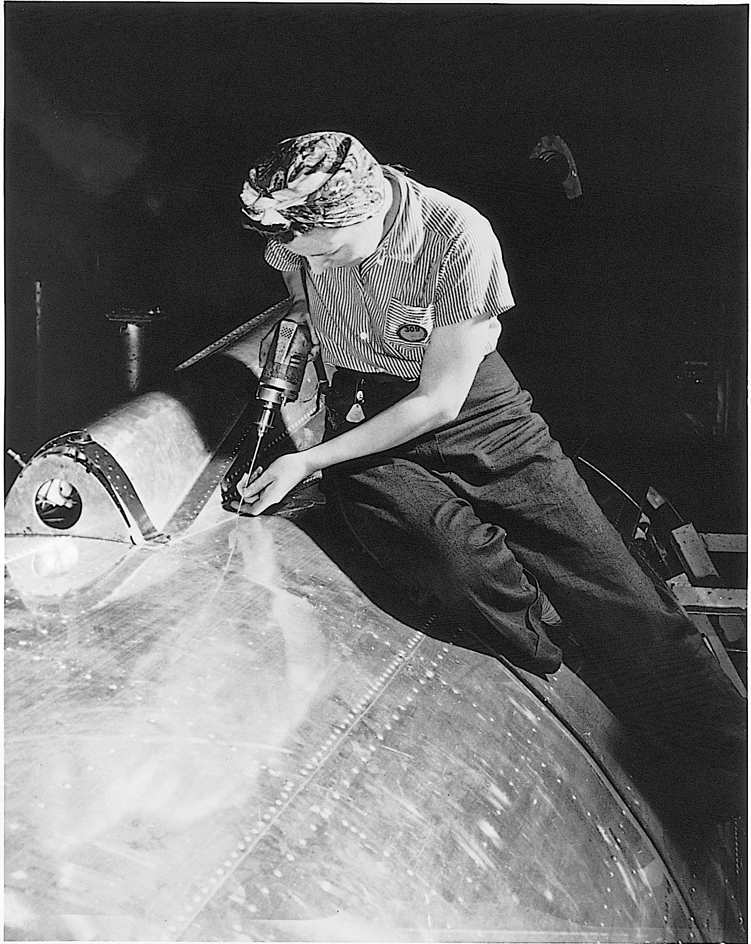
New opportunities opened up for African Americans during World War II. In 1941, Roosevelt created the Fair Employment Practices Committee to prevent job discrimination in U.S. defense industries. Large numbers of Black Southerners moved north to work in the war plants.
Mobilizing for the war.
The United States introduced its first peacetime draft in September 1940. Under the draft law, all men aged 21 through 35 were required to register for military service. The draft was later extended to men 18 through 44. More than 16 million American men served in the armed forces during World War II. About 10 million were drafted. The rest volunteered. About 338,000 women served in the U.S. armed forces. They worked as mechanics, drivers, clerks, and cooks. They also filled many other noncombat positions.
Canada also expanded its armed forces greatly during World War II. At the outbreak of the war, the Canadian government promised not to draft men for service overseas. Canada relied on volunteers for overseas duty until November 1944. By then, it suffered from a shortage of troops and began to send draftees overseas. More than a million Canadians, including about 50,000 women, served in the armed forces during the war.
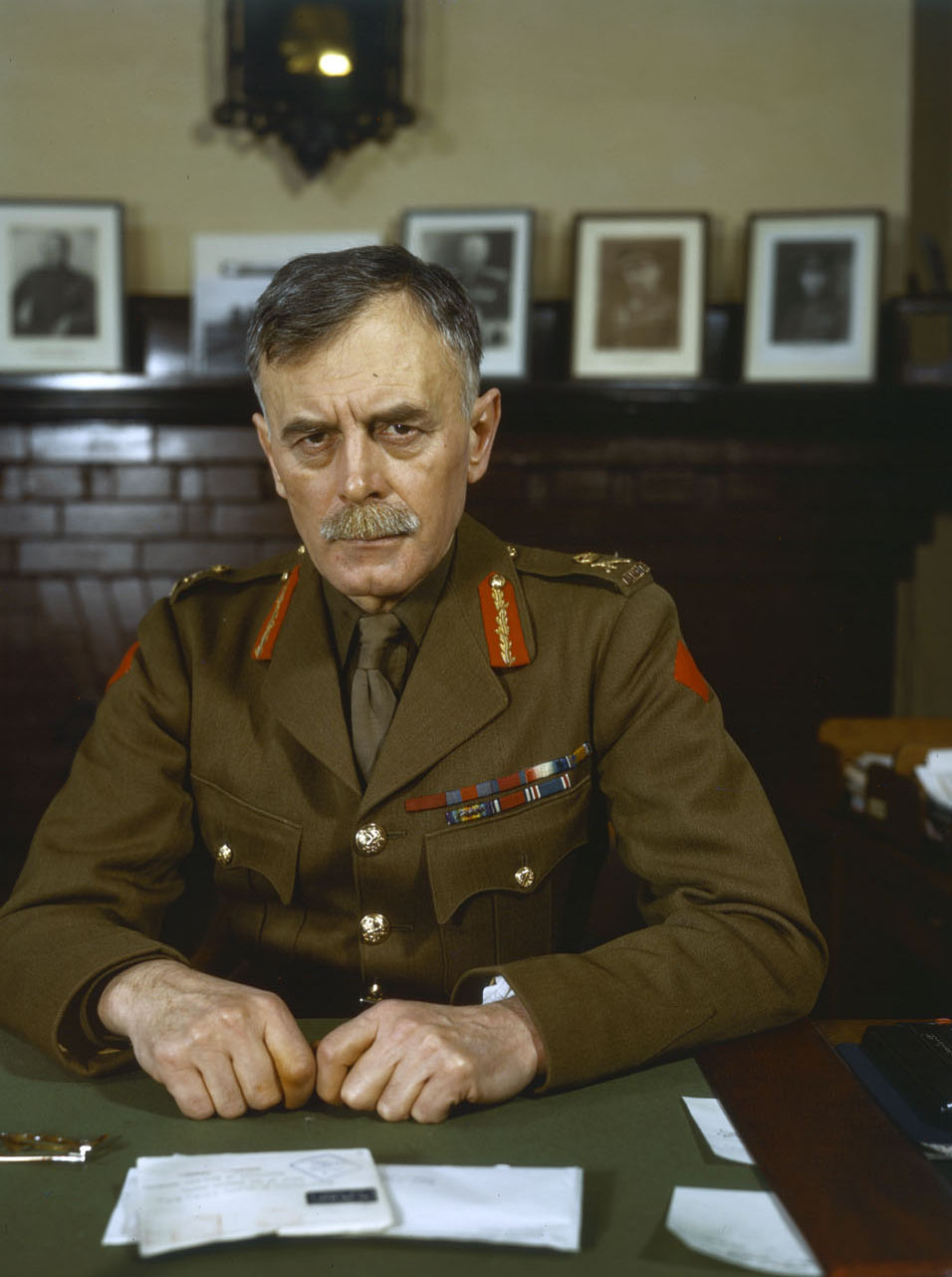
Paying for the war.
The U.S. and Canadian governments brought in money by selling war bonds, certificates, notes, and stamps. The United States government raised nearly $180 billion from such sales. Canada’s government also raised several billion dollars. Because few people were out of work, income increased during the war years. As a result, revenue from income taxes soared. The government taxed entertainment and such luxury goods as cosmetics and jewelry. Corporations paid extra taxes on higher-than-normal profits. Canadians also paid increased taxes during the war.
In spite of greater borrowing and higher taxes, the U.S. and Canadian governments spent more than they raised to pay for the war. In the United States, the national debt increased from about $49 billion in 1941 to $259 billion in 1945. Canada’s national debt rose from $4 billion in 1939 to $16 billion in 1945.
Government controls over civilian life in the United States and Canada expanded during World War II. In both countries, the national government established agencies to direct the war effort on the home front. The agencies helped contain inflation, shortages, and production foul-ups. The War Production Board, for example, controlled the distribution of raw materials needed by U.S. industries. The Office of Price Administration limited price increases in the United States. It also set up a rationing program to distribute scarce goods fairly. Each family received a book of ration coupons to obtain such items as sugar, meat, butter, and gasoline.
Canada’s government had even greater wartime powers. For example, the National Selective Service controlled Canada’s work force. It forbade men of military age to hold jobs it termed “nonessential.” Canada’s Wartime Prices and Trade Board determined wages and prices and set up a rationing program.
Treatment of enemy aliens.
During World War II, the U.S. government classified more than a million newly arrived immigrants from Germany, Italy, and Japan as “enemy aliens.” After the bombing of Pearl Harbor, some Americans directed their rage at people of Japanese ancestry. In 1942, prejudice against the Japanese led the U.S. government to move more than 110,000 West Coast residents of Japanese ancestry to inland relocation camps. The Japanese Americans lost their homes and their jobs as a result. About two-thirds of them were citizens of the United States. Canada also relocated about 21,000 people of Japanese ancestry during the war. 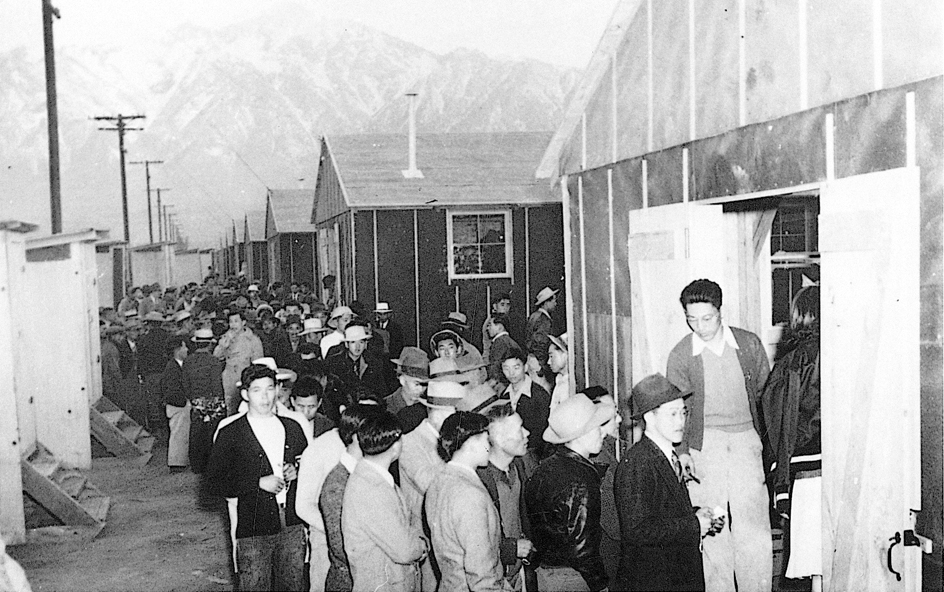
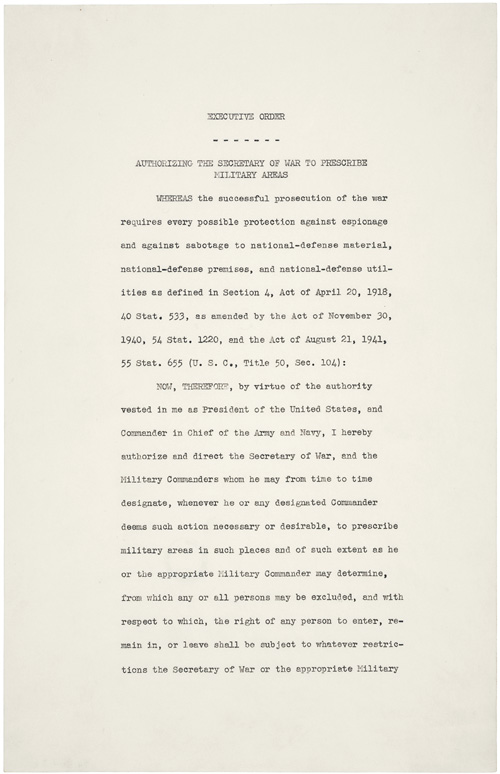
Civilian life.
Conditions were especially difficult in the Soviet Union. Fierce fighting went on there for nearly four years. Stalin ordered retreating Soviet soldiers to burn everything in their path that German troops could use for food or shelter. But that scorched-earth policy also caused hardships for the Soviet people. Millions of Soviet civilians died of famine and other war-related causes. In some areas occupied by the Soviet Union, many of the people at first welcomed the conquering German troops. The people saw the Germans as liberators from Stalin’s harsh rule. But the cruelty of the Nazis turned the people against them. During World War II, civilians and soldiers in the Soviet Union fought the Germans with hatred and determination.
The civilian population of the United Kingdom united wholeheartedly behind the war effort. The people worked long hours in war plants. They accepted severe shortages of nearly all goods. Prime Minister Churchill inspired the British people with his stirring words.
Japan came closest to collapse of all the warring nations. As the Allies closed in, Japan was deprived of the raw materials needed for its industries. American bombers pounded Japan’s cities. American submarines sank Japanese merchant ships. By 1945, hunger and malnutrition were widespread in Japan. But the people remained willing to sacrifice for the war effort.
Food, clothing, and other consumer goods remained plentiful in Germany during the early years of the war. Imports poured in from Nazi-occupied countries of Europe. The Allied bombing of Germany got off to a slow start and did little damage at first. Germany’s situation had changed by late 1942, however. The army bogged down in the Soviet Union. There were fewer reports of German victories to cheer the people. Allied bombs rained down day and night on German cities. Consumer goods became scarce. But the people continued to work hard for the war effort.
Hitler’s dreaded secret police, the Gestapo, crushed opposition to the Nazi Party. The Gestapo arrested anyone suspected of opposing Nazism in Germany and in German-held territories. To free German men for combat, the Gestapo recruited workers from occupied countries. Millions of Europeans were forced to work long hours under terrible conditions in German war plants. Many died of mistreatment or starvation.
The Holocaust.
The Nazis persecuted and murdered millions of people, including Jews, Roma (sometimes called Gypsies), and Slavs. By 1942, Hitler had started a campaign—the “final solution”—to exterminate European Jews. The Nazis rounded up Jewish men, women, and children from occupied Europe. They shipped the Jews in railway cars to concentration camps. There the Jews were systematically killed or used as slave labor. Many died from lack of food, disease, or torture. Altogether, Hitler’s forces killed approximately 6 million European Jews. Europe lost 60 percent of its prewar Jewish population. Half of the victims were Polish. The Nazis also slaughtered Slavs, Roma, socialists, Communists, homosexuals, and people with mental retardation. 
Consequences of the war
Deaths and destruction.
World War II took more lives and caused more destruction than any other war. Altogether, about 70 million people served in the armed forces of the Allied and Axis nations. More than 20 million of them lost their lives. The Soviet Union lost more than 8 1/2 million soldiers and over 10 million civilians, much more than any other country. American deaths came to about 400,000. The United Kingdom lost a similar amount. Germany lost 3 1/4 million military personnel. About 2 million Japanese military personnel died. Poland suffered 600,000 military deaths and nearly 6 million civilian dead. Italy, Romania, and Yugoslavia all lost 300,000 soldiers or more. Austria, France, and Hungary each lost more than 200,000. 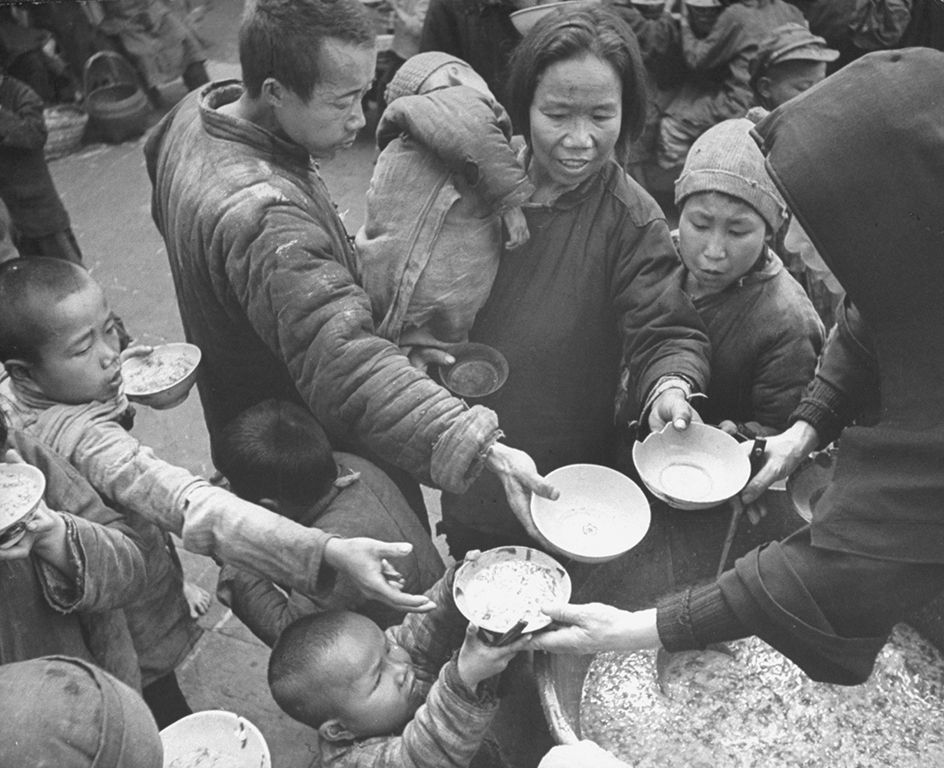
Displaced persons.
World War II uprooted millions of people. After the war, more than 40 million persons were estimated to be displaced in Europe. They included orphans, prisoners of war, and survivors of Nazi concentration and slave labor camps. They also included people who had fled invading armies and war-torn areas. Other people were displaced by changes in national borders. For example, many Germans were expelled from Poland, Czechoslovakia, and other lands in eastern Europe that the Nazis had taken. 
To help displaced persons, the Allies established the United Nations Relief and Rehabilitation Administration (UNRRA). UNRRA began operating in 1944 in areas freed from Nazi occupation. The organization set up camps for displaced persons. It provided them with food, clothing, and medical supplies. By 1947, most people had been resettled. However, about a million people still remained in camps. Many had fled from countries in eastern Europe. They refused to return to homelands that had come under Communist rule. 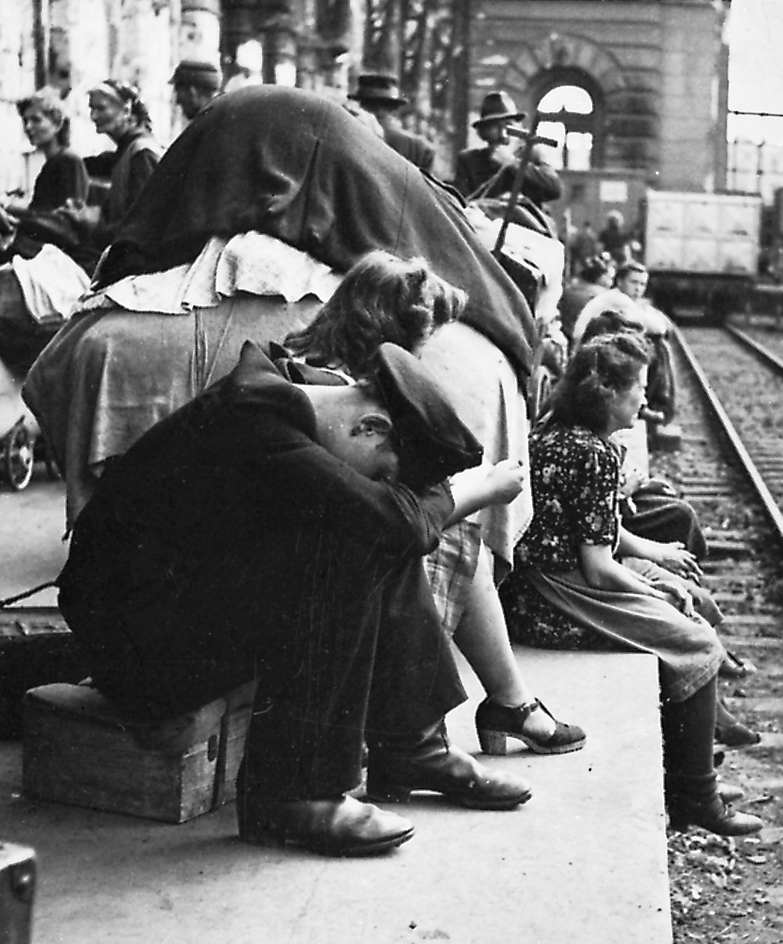
New power struggles
arose after World War II ended. The war had exhausted the leading prewar powers of Europe and Asia. Germany and Japan ended the war in defeat. The United Kingdom and France were weakened. The United States and the Soviet Union emerged as the world’s leading powers. Their wartime alliance soon collapsed, however. The Soviet Union sought to spread Communism in Europe and Asia. A struggle developed between the Communist world, led by the Soviet Union, and the non-Communist world, led by the United States. That struggle became known as the Cold War.
The United States had fought the Axis to preserve democracy. After the war, Americans found it impossible to return to the policy of isolation their country had followed before the war. Americans realized that they needed strong allies. They helped the war-torn nations—friend and foe alike—recover.
World War II had united the Soviet people behind a great patriotic effort. The Soviet Union came out of the war stronger than before, in spite of the destruction it had suffered. Before the war ended, the Soviet Union had absorbed three nations along the Baltic Sea—Estonia, Latvia, and Lithuania. It had also taken parts of Poland, Romania, Finland, and Czechoslovakia by mid-1945. At the end of the war, Soviet troops occupied most of eastern Europe. In March 1946, Churchill warned that an “iron curtain” had descended across Europe. It divided eastern Europe from western Europe. Behind the Iron Curtain, the Soviet Union helped Communist governments take power in Bulgaria, Czechoslovakia, Hungary, Poland, and Romania.
Communism also gained strength in the Far East. The Soviet Union set up a Communist government in North Korea after the war. In China, Mao Zedong’s Communist forces battled Chiang Kai-shek’s Nationalist armies. Late in 1949, Chiang fled to the island of Taiwan. China joined the Communist world.
By 1947, Communists threatened to take control of Greece. The Soviet Union was demanding military bases in Turkey. That year, President Truman announced that the United States would provide military and economic aid to any country threatened by Communism. American aid helped Greece and Turkey resist Communist aggression.
In 1948, the United States set up the Marshall Plan to help war-torn nations in Europe rebuild their economies. Under the plan, 18 nations received $13 billion in food, machinery, and other goods. The Soviet Union forbade countries in eastern Europe to participate in the Marshall Plan.
The nuclear age
opened with the development of the atomic bomb during World War II. Many people believed that weapons of mass destruction would make war unthinkable in the future. They hoped that the world would learn to live in peace. But a race to develop ever more powerful weapons soon began.
At the end of World War II, only the United States knew how to build an atomic weapon. In 1946, the United States proposed the creation of an international agency that would control atomic energy and ban the production of nuclear weapons. But the Soviet Union objected to an inspection system. The proposal was dropped. Soviet scientists developed an atomic bomb in 1949.
Establishing the peace
Birth of the United Nations (UN).
Out of the horror of World War II came efforts to prevent war from ever again engulfing the world. In 1943, representatives of the United States, the United Kingdom, the Soviet Union, and China met in Moscow. They agreed to establish an international organization that would work to promote peace. The four Allied powers met again in 1944 in Washington, D.C. The delegates decided to call the new organization the United Nations (UN). In April 1945, representatives from 50 nations gathered in San Francisco to draft a charter, or constitution, for the United Nations. They signed the charter in June. It went into effect on October 24.
Peace with Germany.
Before World War II ended, the Allies had decided on a military occupation of Germany after its defeat. They divided Germany into four zones. The United States, the Soviet Union, the United Kingdom, and France each occupied a zone. The four powers jointly administered Berlin.
At the Potsdam Conference in July 1945, the Allies set forth their occupation policy. They agreed to abolish Germany’s armed forces and to outlaw the Nazi Party. Germany lost territory east of the Oder and Neisse rivers. Most of the region went to Poland. The Soviet Union gained the northeastern corner of this territory.
The Allies brought to trial Nazi leaders accused of war crimes. The trials exposed the evils inflicted by Nazi Germany. Many leading Nazis were sentenced to death. The most important war trials took place in the German city of Nuremberg from 1945 to 1949. 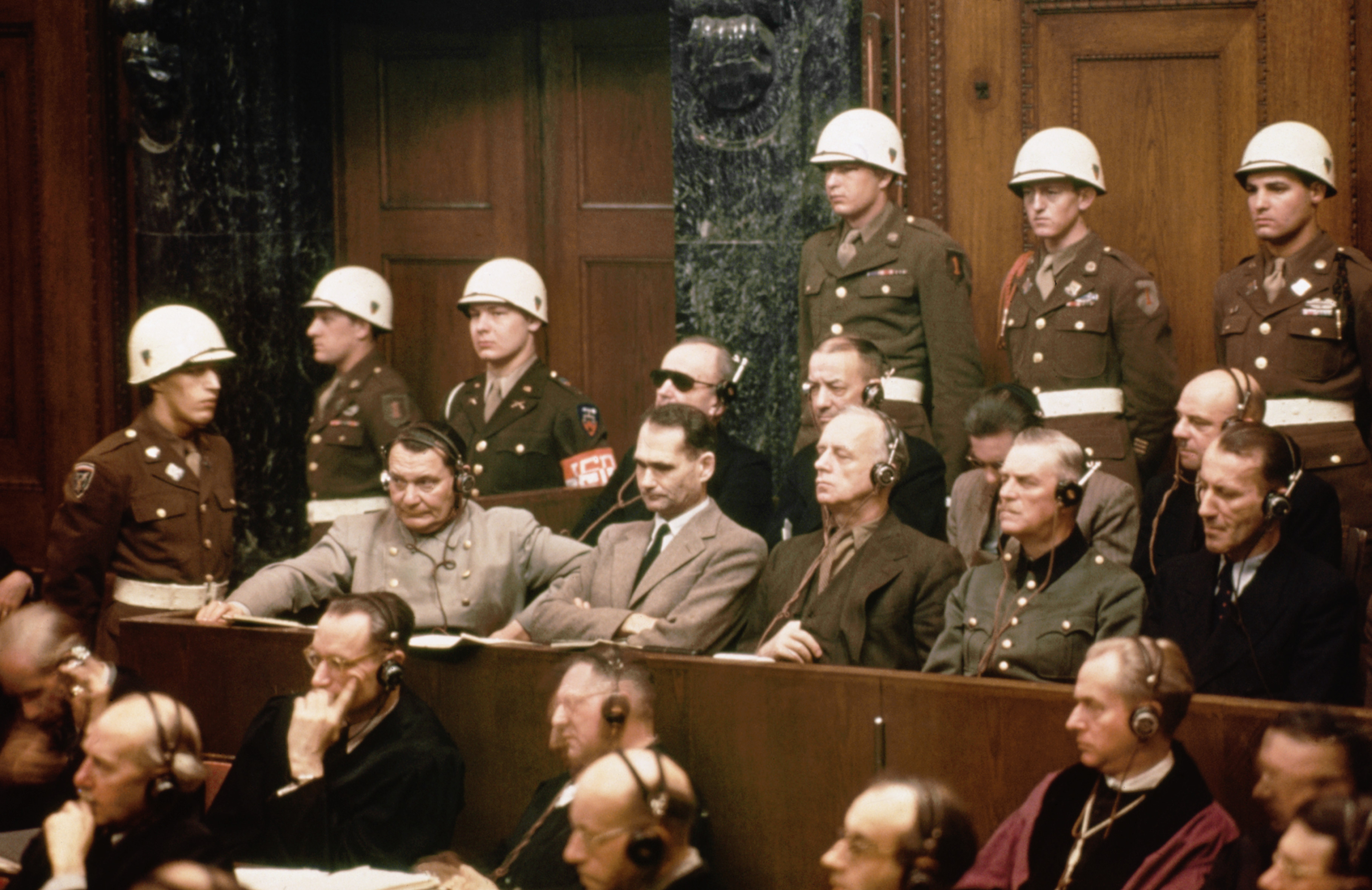
Soon after the occupation began, the Soviet Union stopped cooperating with its Western Allies. It blocked all efforts to reunite Germany. The Western Allies gradually joined their zones into one economic unit. But the Soviet Union forbade its zone to join.
The city of Berlin lay deep within the Soviet zone of Germany. In June 1948, the Soviet Union sought to drive the Western powers from Berlin by blocking all rail, water, and highway routes to the city. For over a year, the Western Allies flew in food, fuel, and other goods to Berlin. The Soviet Union finally lifted the Berlin blockade in May 1949.
The Western Allies set up political parties in their zones and held elections. In September 1949, the three Western zones combined as the Federal Republic of Germany, also known as West Germany. In May 1955, the Western Allies signed a treaty ending the occupation of West Germany. They granted the country full independence. However, the treaty was not a general peace treaty because the Soviet Union refused to sign it. The Soviet Union set up a Communist government in its zone. In October 1949, the Soviet zone became the German Democratic Republic, also called East Germany.
In September 1990, the Soviet Union and the Western Allies signed a treaty to give up all their occupation rights in East and West Germany. In October 1990, Germany was reunited as a non-Communist nation.
Peace with Japan.
The military occupation of Japan began in August 1945. Americans far outnumbered other troops in the occupation forces. General MacArthur directed the occupation as supreme commander for the Allied nations. He introduced many reforms designed to rid Japan of its military institutions and transform it into a democracy. A constitution drawn up by MacArthur’s staff took effect in 1947. The Constitution transferred all political rights from the Japanese emperor to the people. In addition, the Constitution granted voting rights to women and denied Japan’s right to declare war.


The Allied occupation forces brought to trial 25 Japanese war leaders and government officials who were accused of war crimes. Seven of these individuals were executed. The others received prison sentences.
In September 1951, the United States and most of the other Allied nations signed a peace treaty with Japan. The treaty took away Japan’s overseas empire. But it permitted Japan to rearm. The Allied occupation of Japan ended soon after the nations signed the peace treaty. However, a new treaty permitted the United States to keep troops in Japan. China’s Nationalist government signed its own peace treaty with Japan in 1952. The Soviet Union and Japan also signed a separate peace treaty in 1956.
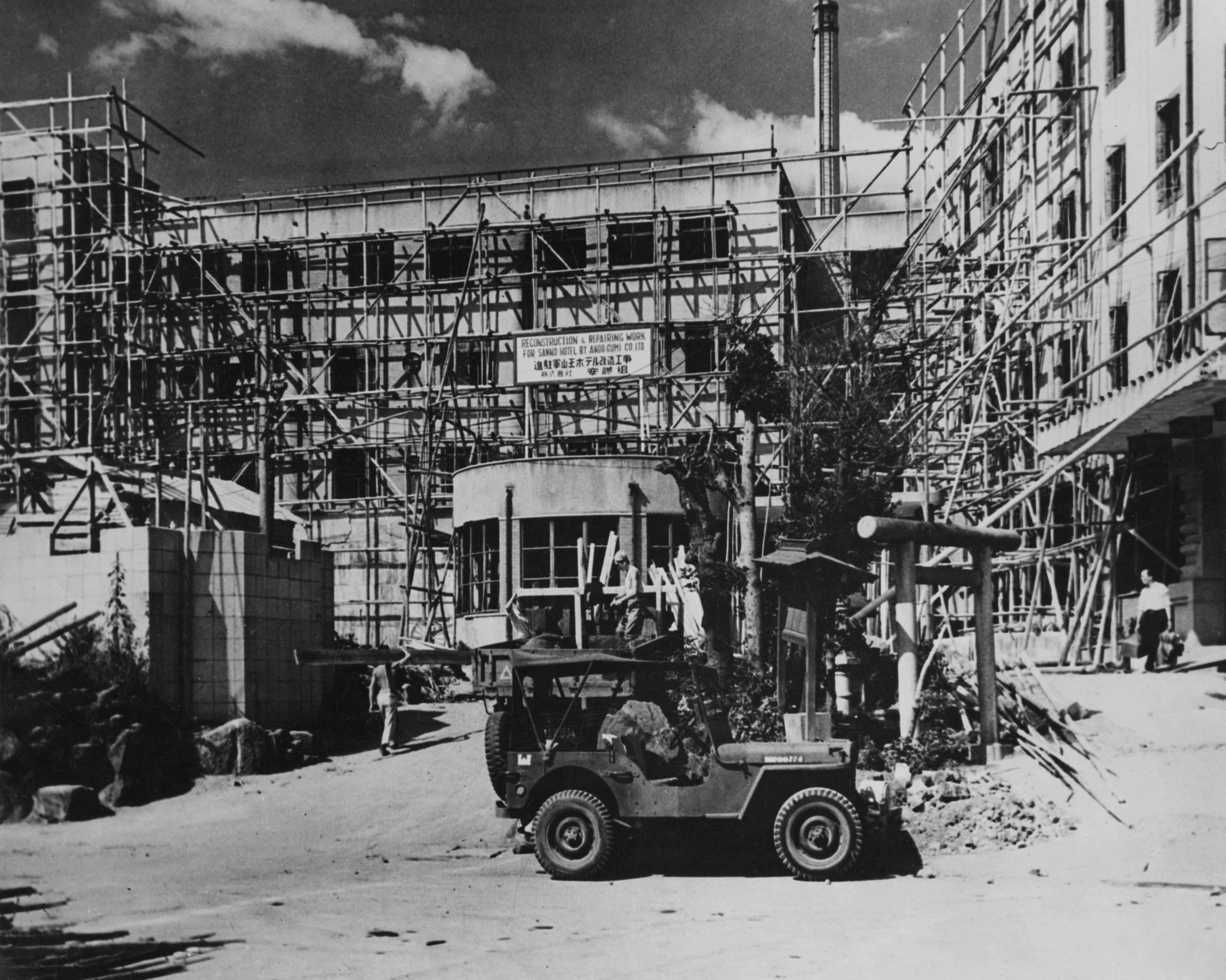
Peace with other countries.
Soon after World War II ended, the Allies began to draw up peace treaties with Italy and the other countries that fought the Allies. The treaties limited the armed forces of the defeated countries. The agreements required the defeated countries to pay war damages. The treaties also called for territorial changes. Bulgaria gave up territory to Greece and Yugoslavia. Czechoslovakia gained land from Hungary. Italy gave up land to France, Yugoslavia, and Greece. Italy also lost its empire in Africa. Romania gained territory from Hungary. But in turn it lost land to Bulgaria and the Soviet Union.
